From Business Model to Business Modeling: Modularity and Manipulation
VerifiedAdded on 2023/06/09
|35
|16843
|152
AI Summary
This paper discusses the concept of modularity in business model innovation and investigates how modularity in technology affects changes in business models. It also introduces the basic operations of business modeling via modular operators adapted from the technological modularity domain.
Contribute Materials
Your contribution can guide someone’s learning journey. Share your
documents today.
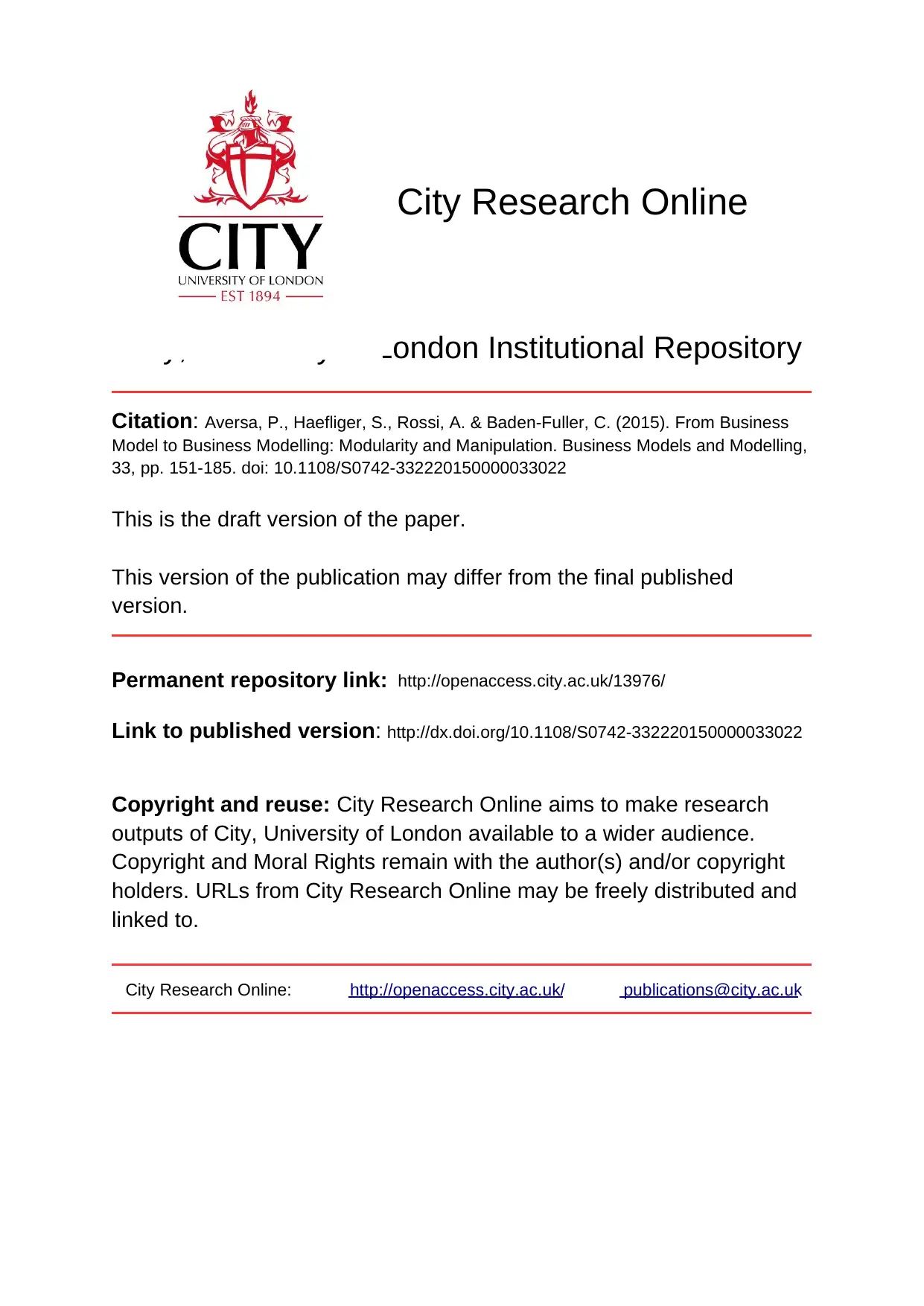
City, University of London Institutional Repository
Citation: Aversa, P., Haefliger, S., Rossi, A. & Baden-Fuller, C. (2015). From Business
Model to Business Modelling: Modularity and Manipulation. Business Models and Modelling,
33, pp. 151-185. doi: 10.1108/S0742-332220150000033022
This is the draft version of the paper.
This version of the publication may differ from the final published
version.
Permanent repository link: http://openaccess.city.ac.uk/13976/
Link to published version: http://dx.doi.org/10.1108/S0742-332220150000033022
Copyright and reuse: City Research Online aims to make research
outputs of City, University of London available to a wider audience.
Copyright and Moral Rights remain with the author(s) and/or copyright
holders. URLs from City Research Online may be freely distributed and
linked to.
City Research Online: http://openaccess.city.ac.uk/ publications@city.ac.uk
City Research Online
Citation: Aversa, P., Haefliger, S., Rossi, A. & Baden-Fuller, C. (2015). From Business
Model to Business Modelling: Modularity and Manipulation. Business Models and Modelling,
33, pp. 151-185. doi: 10.1108/S0742-332220150000033022
This is the draft version of the paper.
This version of the publication may differ from the final published
version.
Permanent repository link: http://openaccess.city.ac.uk/13976/
Link to published version: http://dx.doi.org/10.1108/S0742-332220150000033022
Copyright and reuse: City Research Online aims to make research
outputs of City, University of London available to a wider audience.
Copyright and Moral Rights remain with the author(s) and/or copyright
holders. URLs from City Research Online may be freely distributed and
linked to.
City Research Online: http://openaccess.city.ac.uk/ publications@city.ac.uk
City Research Online
Secure Best Marks with AI Grader
Need help grading? Try our AI Grader for instant feedback on your assignments.
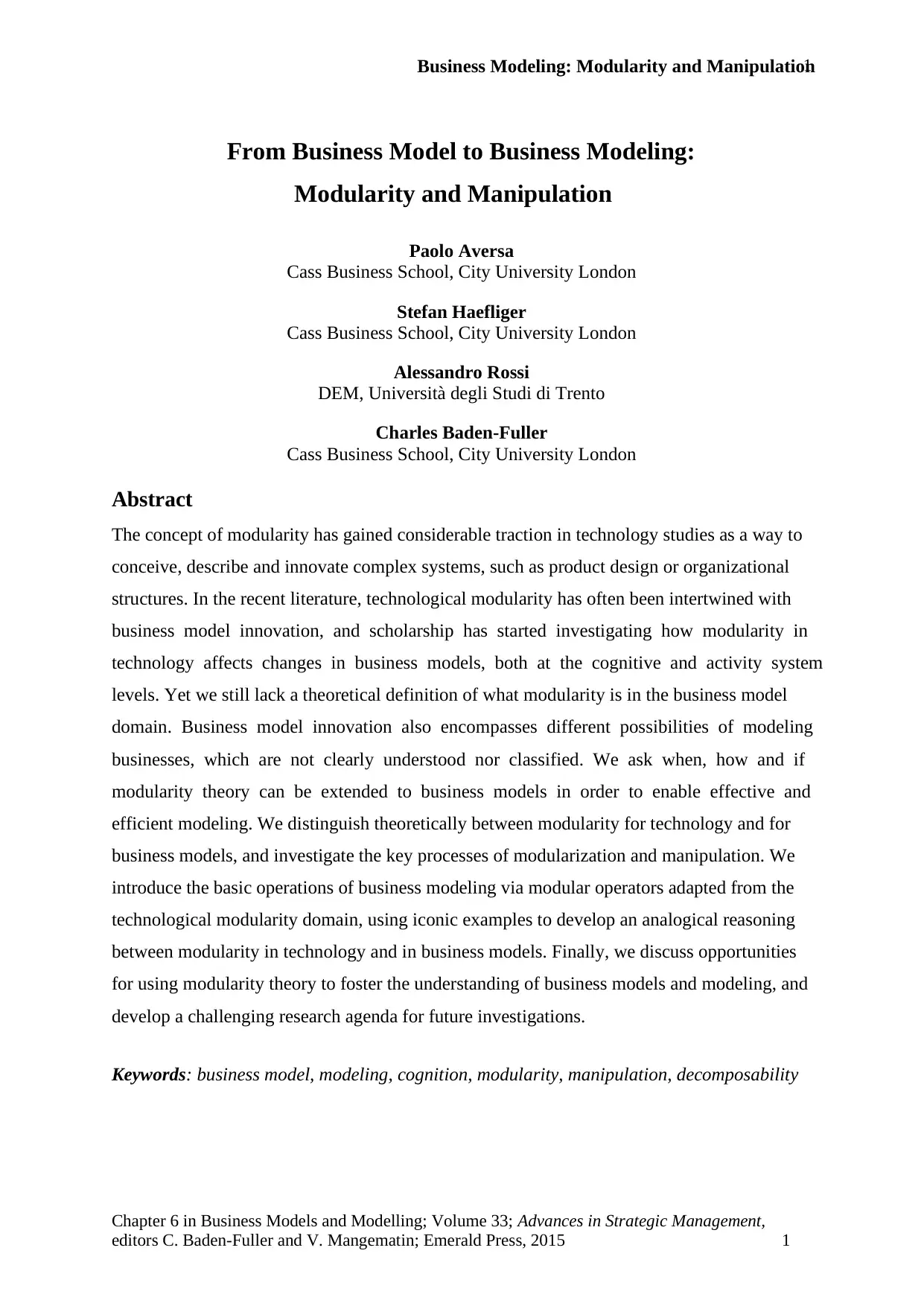
Business Modeling: Modularity and Manipulation
Chapter 6 in Business Models and Modelling; Volume 33; Advances in Strategic Management,
editors C. Baden-Fuller and V. Mangematin; Emerald Press, 2015 1
1
From Business Model to Business Modeling:
Modularity and Manipulation
Paolo Aversa
Cass Business School, City University London
Stefan Haefliger
Cass Business School, City University London
Alessandro Rossi
DEM, Università degli Studi di Trento
Charles Baden-Fuller
Cass Business School, City University London
Abstract
The concept of modularity has gained considerable traction in technology studies as a way to
conceive, describe and innovate complex systems, such as product design or organizational
structures. In the recent literature, technological modularity has often been intertwined with
business model innovation, and scholarship has started investigating how modularity in
technology affects changes in business models, both at the cognitive and activity system
levels. Yet we still lack a theoretical definition of what modularity is in the business model
domain. Business model innovation also encompasses different possibilities of modeling
businesses, which are not clearly understood nor classified. We ask when, how and if
modularity theory can be extended to business models in order to enable effective and
efficient modeling. We distinguish theoretically between modularity for technology and for
business models, and investigate the key processes of modularization and manipulation. We
introduce the basic operations of business modeling via modular operators adapted from the
technological modularity domain, using iconic examples to develop an analogical reasoning
between modularity in technology and in business models. Finally, we discuss opportunities
for using modularity theory to foster the understanding of business models and modeling, and
develop a challenging research agenda for future investigations.
Keywords: business model, modeling, cognition, modularity, manipulation, decomposability
Chapter 6 in Business Models and Modelling; Volume 33; Advances in Strategic Management,
editors C. Baden-Fuller and V. Mangematin; Emerald Press, 2015 1
1
From Business Model to Business Modeling:
Modularity and Manipulation
Paolo Aversa
Cass Business School, City University London
Stefan Haefliger
Cass Business School, City University London
Alessandro Rossi
DEM, Università degli Studi di Trento
Charles Baden-Fuller
Cass Business School, City University London
Abstract
The concept of modularity has gained considerable traction in technology studies as a way to
conceive, describe and innovate complex systems, such as product design or organizational
structures. In the recent literature, technological modularity has often been intertwined with
business model innovation, and scholarship has started investigating how modularity in
technology affects changes in business models, both at the cognitive and activity system
levels. Yet we still lack a theoretical definition of what modularity is in the business model
domain. Business model innovation also encompasses different possibilities of modeling
businesses, which are not clearly understood nor classified. We ask when, how and if
modularity theory can be extended to business models in order to enable effective and
efficient modeling. We distinguish theoretically between modularity for technology and for
business models, and investigate the key processes of modularization and manipulation. We
introduce the basic operations of business modeling via modular operators adapted from the
technological modularity domain, using iconic examples to develop an analogical reasoning
between modularity in technology and in business models. Finally, we discuss opportunities
for using modularity theory to foster the understanding of business models and modeling, and
develop a challenging research agenda for future investigations.
Keywords: business model, modeling, cognition, modularity, manipulation, decomposability
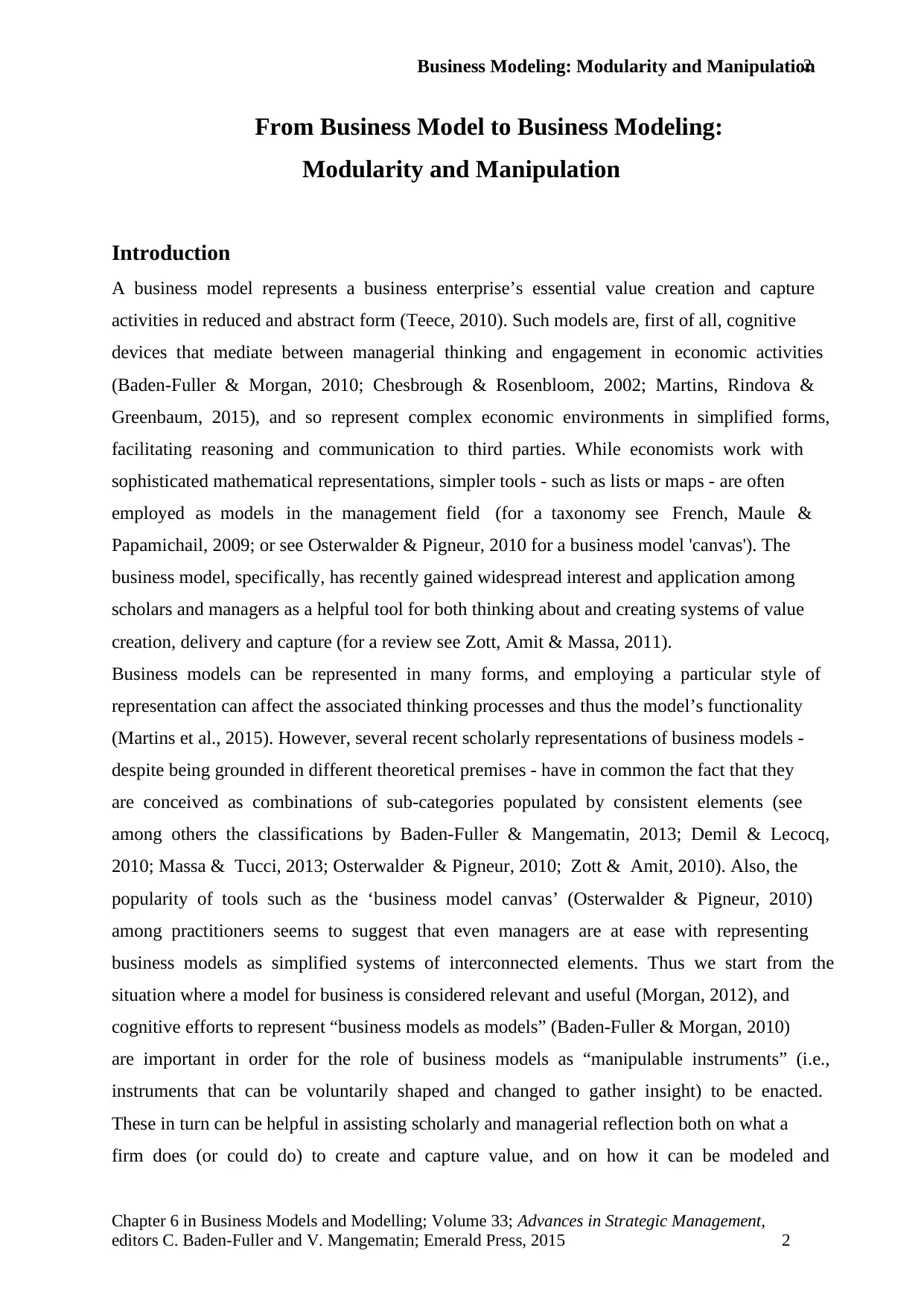
Business Modeling: Modularity and Manipulation
Chapter 6 in Business Models and Modelling; Volume 33; Advances in Strategic Management,
editors C. Baden-Fuller and V. Mangematin; Emerald Press, 2015 2
2
From Business Model to Business Modeling:
Modularity and Manipulation
Introduction
A business model represents a business enterprise’s essential value creation and capture
activities in reduced and abstract form (Teece, 2010). Such models are, first of all, cognitive
devices that mediate between managerial thinking and engagement in economic activities
(Baden-Fuller & Morgan, 2010; Chesbrough & Rosenbloom, 2002; Martins, Rindova &
Greenbaum, 2015), and so represent complex economic environments in simplified forms,
facilitating reasoning and communication to third parties. While economists work with
sophisticated mathematical representations, simpler tools - such as lists or maps - are often
employed as models in the management field (for a taxonomy see French, Maule &
Papamichail, 2009; or see Osterwalder & Pigneur, 2010 for a business model 'canvas'). The
business model, specifically, has recently gained widespread interest and application among
scholars and managers as a helpful tool for both thinking about and creating systems of value
creation, delivery and capture (for a review see Zott, Amit & Massa, 2011).
Business models can be represented in many forms, and employing a particular style of
representation can affect the associated thinking processes and thus the model’s functionality
(Martins et al., 2015). However, several recent scholarly representations of business models -
despite being grounded in different theoretical premises - have in common the fact that they
are conceived as combinations of sub-categories populated by consistent elements (see
among others the classifications by Baden-Fuller & Mangematin, 2013; Demil & Lecocq,
2010; Massa & Tucci, 2013; Osterwalder & Pigneur, 2010; Zott & Amit, 2010). Also, the
popularity of tools such as the ‘business model canvas’ (Osterwalder & Pigneur, 2010)
among practitioners seems to suggest that even managers are at ease with representing
business models as simplified systems of interconnected elements. Thus we start from the
situation where a model for business is considered relevant and useful (Morgan, 2012), and
cognitive efforts to represent “business models as models” (Baden-Fuller & Morgan, 2010)
are important in order for the role of business models as “manipulable instruments” (i.e.,
instruments that can be voluntarily shaped and changed to gather insight) to be enacted.
These in turn can be helpful in assisting scholarly and managerial reflection both on what a
firm does (or could do) to create and capture value, and on how it can be modeled and
Chapter 6 in Business Models and Modelling; Volume 33; Advances in Strategic Management,
editors C. Baden-Fuller and V. Mangematin; Emerald Press, 2015 2
2
From Business Model to Business Modeling:
Modularity and Manipulation
Introduction
A business model represents a business enterprise’s essential value creation and capture
activities in reduced and abstract form (Teece, 2010). Such models are, first of all, cognitive
devices that mediate between managerial thinking and engagement in economic activities
(Baden-Fuller & Morgan, 2010; Chesbrough & Rosenbloom, 2002; Martins, Rindova &
Greenbaum, 2015), and so represent complex economic environments in simplified forms,
facilitating reasoning and communication to third parties. While economists work with
sophisticated mathematical representations, simpler tools - such as lists or maps - are often
employed as models in the management field (for a taxonomy see French, Maule &
Papamichail, 2009; or see Osterwalder & Pigneur, 2010 for a business model 'canvas'). The
business model, specifically, has recently gained widespread interest and application among
scholars and managers as a helpful tool for both thinking about and creating systems of value
creation, delivery and capture (for a review see Zott, Amit & Massa, 2011).
Business models can be represented in many forms, and employing a particular style of
representation can affect the associated thinking processes and thus the model’s functionality
(Martins et al., 2015). However, several recent scholarly representations of business models -
despite being grounded in different theoretical premises - have in common the fact that they
are conceived as combinations of sub-categories populated by consistent elements (see
among others the classifications by Baden-Fuller & Mangematin, 2013; Demil & Lecocq,
2010; Massa & Tucci, 2013; Osterwalder & Pigneur, 2010; Zott & Amit, 2010). Also, the
popularity of tools such as the ‘business model canvas’ (Osterwalder & Pigneur, 2010)
among practitioners seems to suggest that even managers are at ease with representing
business models as simplified systems of interconnected elements. Thus we start from the
situation where a model for business is considered relevant and useful (Morgan, 2012), and
cognitive efforts to represent “business models as models” (Baden-Fuller & Morgan, 2010)
are important in order for the role of business models as “manipulable instruments” (i.e.,
instruments that can be voluntarily shaped and changed to gather insight) to be enacted.
These in turn can be helpful in assisting scholarly and managerial reflection both on what a
firm does (or could do) to create and capture value, and on how it can be modeled and
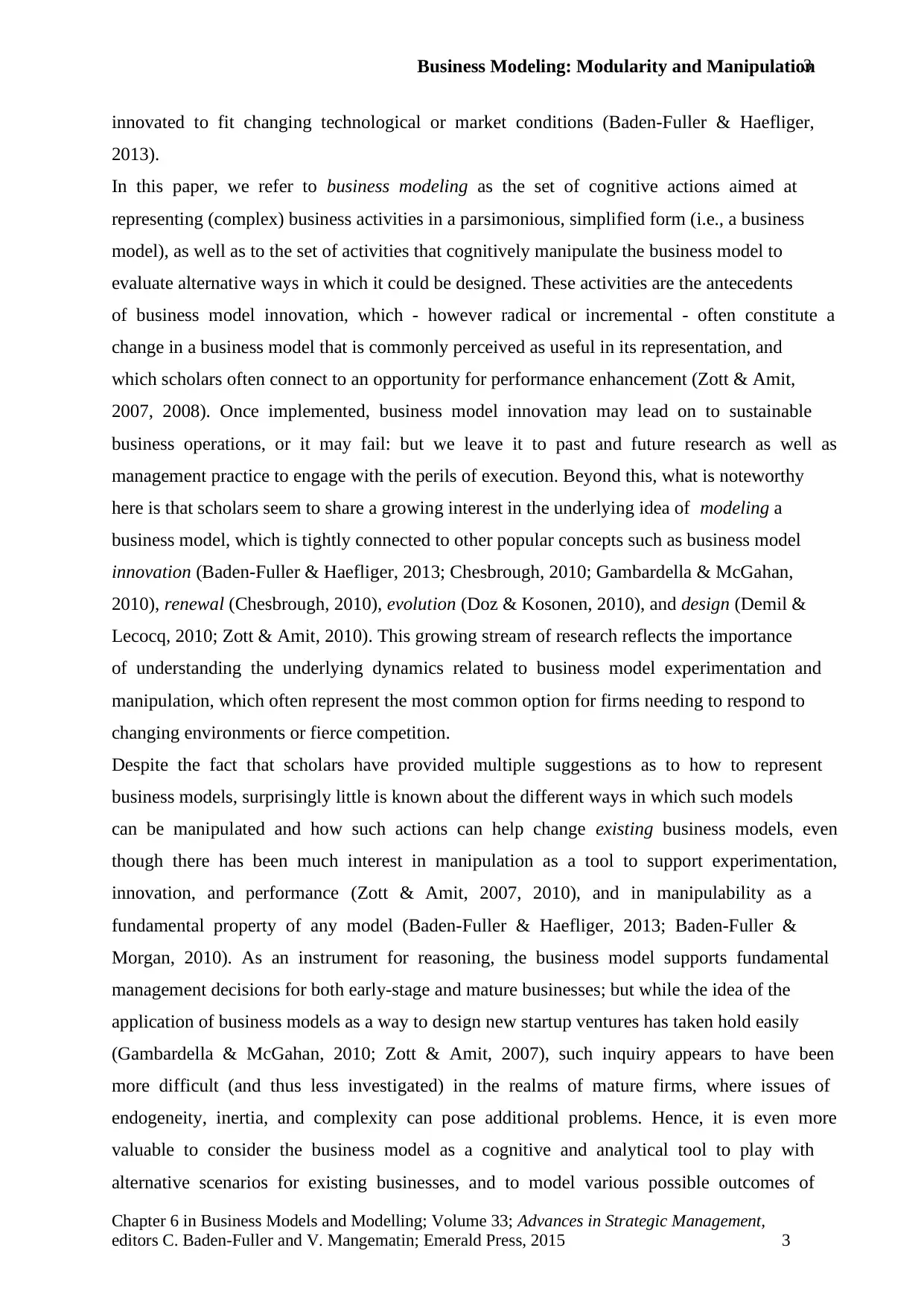
Business Modeling: Modularity and Manipulation
Chapter 6 in Business Models and Modelling; Volume 33; Advances in Strategic Management,
editors C. Baden-Fuller and V. Mangematin; Emerald Press, 2015 3
3
innovated to fit changing technological or market conditions (Baden-Fuller & Haefliger,
2013).
In this paper, we refer to business modeling as the set of cognitive actions aimed at
representing (complex) business activities in a parsimonious, simplified form (i.e., a business
model), as well as to the set of activities that cognitively manipulate the business model to
evaluate alternative ways in which it could be designed. These activities are the antecedents
of business model innovation, which - however radical or incremental - often constitute a
change in a business model that is commonly perceived as useful in its representation, and
which scholars often connect to an opportunity for performance enhancement (Zott & Amit,
2007, 2008). Once implemented, business model innovation may lead on to sustainable
business operations, or it may fail: but we leave it to past and future research as well as
management practice to engage with the perils of execution. Beyond this, what is noteworthy
here is that scholars seem to share a growing interest in the underlying idea of modeling a
business model, which is tightly connected to other popular concepts such as business model
innovation (Baden-Fuller & Haefliger, 2013; Chesbrough, 2010; Gambardella & McGahan,
2010), renewal (Chesbrough, 2010), evolution (Doz & Kosonen, 2010), and design (Demil &
Lecocq, 2010; Zott & Amit, 2010). This growing stream of research reflects the importance
of understanding the underlying dynamics related to business model experimentation and
manipulation, which often represent the most common option for firms needing to respond to
changing environments or fierce competition.
Despite the fact that scholars have provided multiple suggestions as to how to represent
business models, surprisingly little is known about the different ways in which such models
can be manipulated and how such actions can help change existing business models, even
though there has been much interest in manipulation as a tool to support experimentation,
innovation, and performance (Zott & Amit, 2007, 2010), and in manipulability as a
fundamental property of any model (Baden-Fuller & Haefliger, 2013; Baden-Fuller &
Morgan, 2010). As an instrument for reasoning, the business model supports fundamental
management decisions for both early-stage and mature businesses; but while the idea of the
application of business models as a way to design new startup ventures has taken hold easily
(Gambardella & McGahan, 2010; Zott & Amit, 2007), such inquiry appears to have been
more difficult (and thus less investigated) in the realms of mature firms, where issues of
endogeneity, inertia, and complexity can pose additional problems. Hence, it is even more
valuable to consider the business model as a cognitive and analytical tool to play with
alternative scenarios for existing businesses, and to model various possible outcomes of
Chapter 6 in Business Models and Modelling; Volume 33; Advances in Strategic Management,
editors C. Baden-Fuller and V. Mangematin; Emerald Press, 2015 3
3
innovated to fit changing technological or market conditions (Baden-Fuller & Haefliger,
2013).
In this paper, we refer to business modeling as the set of cognitive actions aimed at
representing (complex) business activities in a parsimonious, simplified form (i.e., a business
model), as well as to the set of activities that cognitively manipulate the business model to
evaluate alternative ways in which it could be designed. These activities are the antecedents
of business model innovation, which - however radical or incremental - often constitute a
change in a business model that is commonly perceived as useful in its representation, and
which scholars often connect to an opportunity for performance enhancement (Zott & Amit,
2007, 2008). Once implemented, business model innovation may lead on to sustainable
business operations, or it may fail: but we leave it to past and future research as well as
management practice to engage with the perils of execution. Beyond this, what is noteworthy
here is that scholars seem to share a growing interest in the underlying idea of modeling a
business model, which is tightly connected to other popular concepts such as business model
innovation (Baden-Fuller & Haefliger, 2013; Chesbrough, 2010; Gambardella & McGahan,
2010), renewal (Chesbrough, 2010), evolution (Doz & Kosonen, 2010), and design (Demil &
Lecocq, 2010; Zott & Amit, 2010). This growing stream of research reflects the importance
of understanding the underlying dynamics related to business model experimentation and
manipulation, which often represent the most common option for firms needing to respond to
changing environments or fierce competition.
Despite the fact that scholars have provided multiple suggestions as to how to represent
business models, surprisingly little is known about the different ways in which such models
can be manipulated and how such actions can help change existing business models, even
though there has been much interest in manipulation as a tool to support experimentation,
innovation, and performance (Zott & Amit, 2007, 2010), and in manipulability as a
fundamental property of any model (Baden-Fuller & Haefliger, 2013; Baden-Fuller &
Morgan, 2010). As an instrument for reasoning, the business model supports fundamental
management decisions for both early-stage and mature businesses; but while the idea of the
application of business models as a way to design new startup ventures has taken hold easily
(Gambardella & McGahan, 2010; Zott & Amit, 2007), such inquiry appears to have been
more difficult (and thus less investigated) in the realms of mature firms, where issues of
endogeneity, inertia, and complexity can pose additional problems. Hence, it is even more
valuable to consider the business model as a cognitive and analytical tool to play with
alternative scenarios for existing businesses, and to model various possible outcomes of
Secure Best Marks with AI Grader
Need help grading? Try our AI Grader for instant feedback on your assignments.
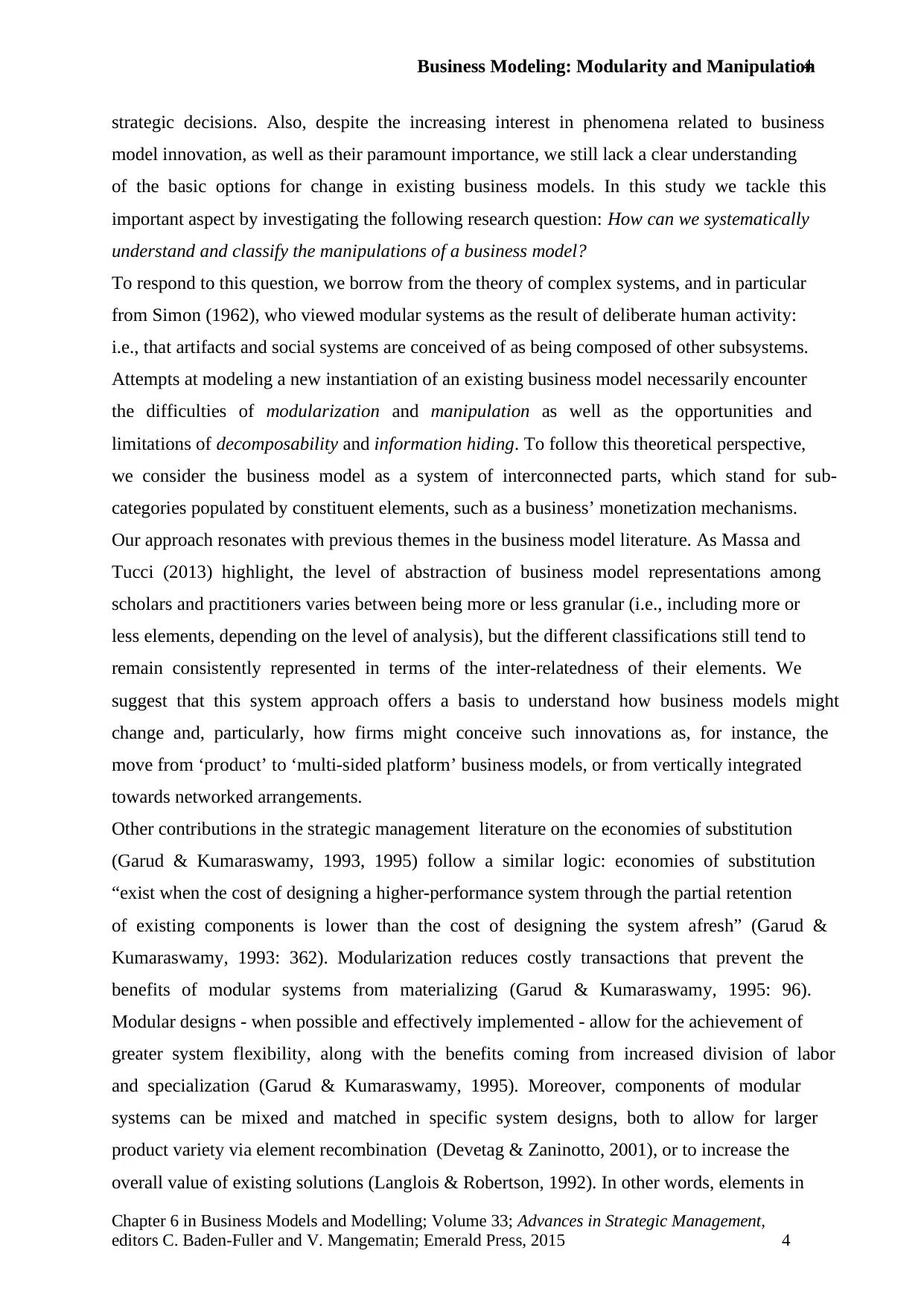
Business Modeling: Modularity and Manipulation
Chapter 6 in Business Models and Modelling; Volume 33; Advances in Strategic Management,
editors C. Baden-Fuller and V. Mangematin; Emerald Press, 2015 4
4
strategic decisions. Also, despite the increasing interest in phenomena related to business
model innovation, as well as their paramount importance, we still lack a clear understanding
of the basic options for change in existing business models. In this study we tackle this
important aspect by investigating the following research question: How can we systematically
understand and classify the manipulations of a business model?
To respond to this question, we borrow from the theory of complex systems, and in particular
from Simon (1962), who viewed modular systems as the result of deliberate human activity:
i.e., that artifacts and social systems are conceived of as being composed of other subsystems.
Attempts at modeling a new instantiation of an existing business model necessarily encounter
the difficulties of modularization and manipulation as well as the opportunities and
limitations of decomposability and information hiding. To follow this theoretical perspective,
we consider the business model as a system of interconnected parts, which stand for sub-
categories populated by constituent elements, such as a business’ monetization mechanisms.
Our approach resonates with previous themes in the business model literature. As Massa and
Tucci (2013) highlight, the level of abstraction of business model representations among
scholars and practitioners varies between being more or less granular (i.e., including more or
less elements, depending on the level of analysis), but the different classifications still tend to
remain consistently represented in terms of the inter-relatedness of their elements. We
suggest that this system approach offers a basis to understand how business models might
change and, particularly, how firms might conceive such innovations as, for instance, the
move from ‘product’ to ‘multi-sided platform’ business models, or from vertically integrated
towards networked arrangements.
Other contributions in the strategic management literature on the economies of substitution
(Garud & Kumaraswamy, 1993, 1995) follow a similar logic: economies of substitution
“exist when the cost of designing a higher-performance system through the partial retention
of existing components is lower than the cost of designing the system afresh” (Garud &
Kumaraswamy, 1993: 362). Modularization reduces costly transactions that prevent the
benefits of modular systems from materializing (Garud & Kumaraswamy, 1995: 96).
Modular designs - when possible and effectively implemented - allow for the achievement of
greater system flexibility, along with the benefits coming from increased division of labor
and specialization (Garud & Kumaraswamy, 1995). Moreover, components of modular
systems can be mixed and matched in specific system designs, both to allow for larger
product variety via element recombination (Devetag & Zaninotto, 2001), or to increase the
overall value of existing solutions (Langlois & Robertson, 1992). In other words, elements in
Chapter 6 in Business Models and Modelling; Volume 33; Advances in Strategic Management,
editors C. Baden-Fuller and V. Mangematin; Emerald Press, 2015 4
4
strategic decisions. Also, despite the increasing interest in phenomena related to business
model innovation, as well as their paramount importance, we still lack a clear understanding
of the basic options for change in existing business models. In this study we tackle this
important aspect by investigating the following research question: How can we systematically
understand and classify the manipulations of a business model?
To respond to this question, we borrow from the theory of complex systems, and in particular
from Simon (1962), who viewed modular systems as the result of deliberate human activity:
i.e., that artifacts and social systems are conceived of as being composed of other subsystems.
Attempts at modeling a new instantiation of an existing business model necessarily encounter
the difficulties of modularization and manipulation as well as the opportunities and
limitations of decomposability and information hiding. To follow this theoretical perspective,
we consider the business model as a system of interconnected parts, which stand for sub-
categories populated by constituent elements, such as a business’ monetization mechanisms.
Our approach resonates with previous themes in the business model literature. As Massa and
Tucci (2013) highlight, the level of abstraction of business model representations among
scholars and practitioners varies between being more or less granular (i.e., including more or
less elements, depending on the level of analysis), but the different classifications still tend to
remain consistently represented in terms of the inter-relatedness of their elements. We
suggest that this system approach offers a basis to understand how business models might
change and, particularly, how firms might conceive such innovations as, for instance, the
move from ‘product’ to ‘multi-sided platform’ business models, or from vertically integrated
towards networked arrangements.
Other contributions in the strategic management literature on the economies of substitution
(Garud & Kumaraswamy, 1993, 1995) follow a similar logic: economies of substitution
“exist when the cost of designing a higher-performance system through the partial retention
of existing components is lower than the cost of designing the system afresh” (Garud &
Kumaraswamy, 1993: 362). Modularization reduces costly transactions that prevent the
benefits of modular systems from materializing (Garud & Kumaraswamy, 1995: 96).
Modular designs - when possible and effectively implemented - allow for the achievement of
greater system flexibility, along with the benefits coming from increased division of labor
and specialization (Garud & Kumaraswamy, 1995). Moreover, components of modular
systems can be mixed and matched in specific system designs, both to allow for larger
product variety via element recombination (Devetag & Zaninotto, 2001), or to increase the
overall value of existing solutions (Langlois & Robertson, 1992). In other words, elements in
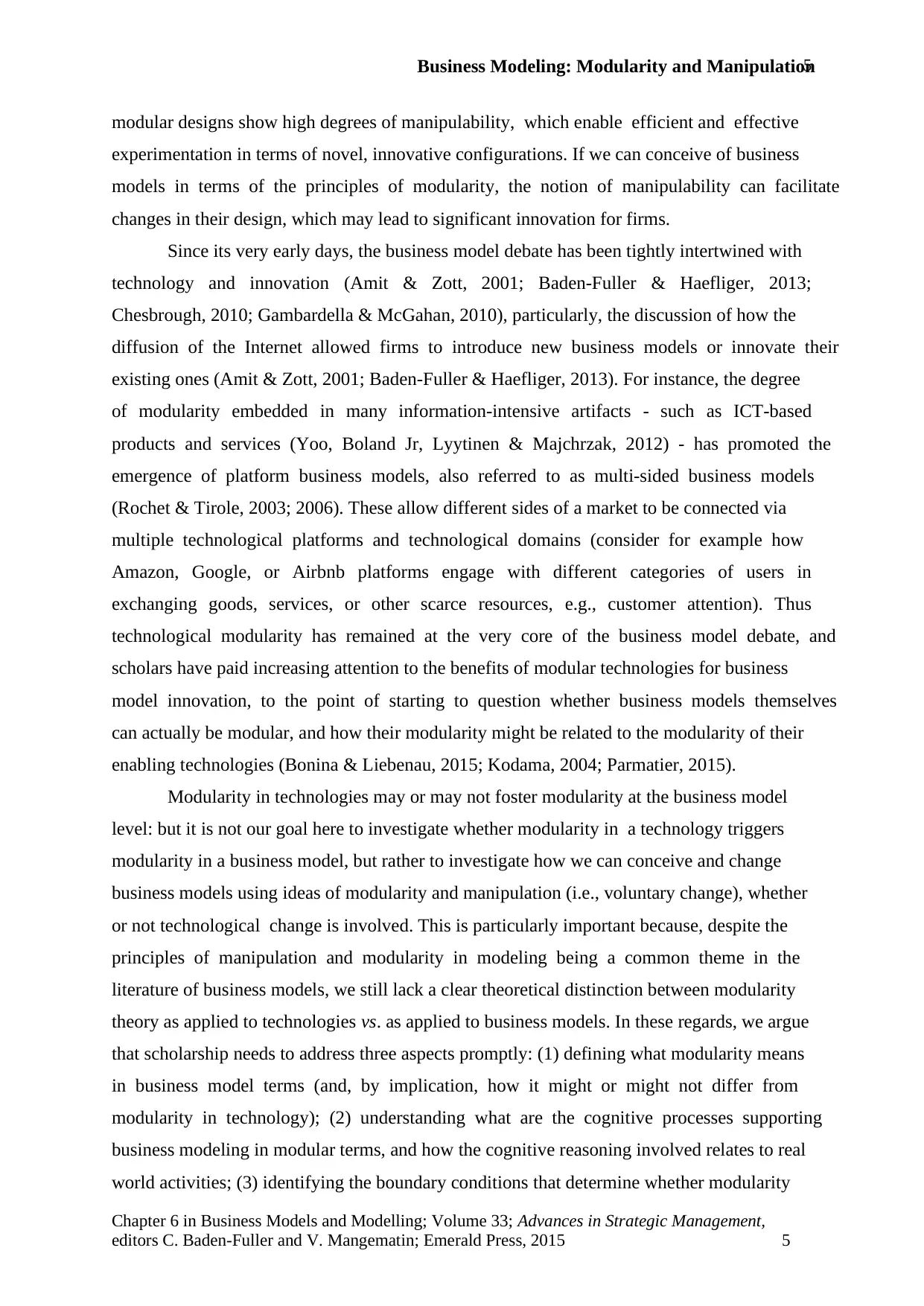
Business Modeling: Modularity and Manipulation
Chapter 6 in Business Models and Modelling; Volume 33; Advances in Strategic Management,
editors C. Baden-Fuller and V. Mangematin; Emerald Press, 2015 5
5
modular designs show high degrees of manipulability, which enable efficient and effective
experimentation in terms of novel, innovative configurations. If we can conceive of business
models in terms of the principles of modularity, the notion of manipulability can facilitate
changes in their design, which may lead to significant innovation for firms.
Since its very early days, the business model debate has been tightly intertwined with
technology and innovation (Amit & Zott, 2001; Baden-Fuller & Haefliger, 2013;
Chesbrough, 2010; Gambardella & McGahan, 2010), particularly, the discussion of how the
diffusion of the Internet allowed firms to introduce new business models or innovate their
existing ones (Amit & Zott, 2001; Baden-Fuller & Haefliger, 2013). For instance, the degree
of modularity embedded in many information-intensive artifacts - such as ICT-based
products and services (Yoo, Boland Jr, Lyytinen & Majchrzak, 2012) - has promoted the
emergence of platform business models, also referred to as multi-sided business models
(Rochet & Tirole, 2003; 2006). These allow different sides of a market to be connected via
multiple technological platforms and technological domains (consider for example how
Amazon, Google, or Airbnb platforms engage with different categories of users in
exchanging goods, services, or other scarce resources, e.g., customer attention). Thus
technological modularity has remained at the very core of the business model debate, and
scholars have paid increasing attention to the benefits of modular technologies for business
model innovation, to the point of starting to question whether business models themselves
can actually be modular, and how their modularity might be related to the modularity of their
enabling technologies (Bonina & Liebenau, 2015; Kodama, 2004; Parmatier, 2015).
Modularity in technologies may or may not foster modularity at the business model
level: but it is not our goal here to investigate whether modularity in a technology triggers
modularity in a business model, but rather to investigate how we can conceive and change
business models using ideas of modularity and manipulation (i.e., voluntary change), whether
or not technological change is involved. This is particularly important because, despite the
principles of manipulation and modularity in modeling being a common theme in the
literature of business models, we still lack a clear theoretical distinction between modularity
theory as applied to technologies vs. as applied to business models. In these regards, we argue
that scholarship needs to address three aspects promptly: (1) defining what modularity means
in business model terms (and, by implication, how it might or might not differ from
modularity in technology); (2) understanding what are the cognitive processes supporting
business modeling in modular terms, and how the cognitive reasoning involved relates to real
world activities; (3) identifying the boundary conditions that determine whether modularity
Chapter 6 in Business Models and Modelling; Volume 33; Advances in Strategic Management,
editors C. Baden-Fuller and V. Mangematin; Emerald Press, 2015 5
5
modular designs show high degrees of manipulability, which enable efficient and effective
experimentation in terms of novel, innovative configurations. If we can conceive of business
models in terms of the principles of modularity, the notion of manipulability can facilitate
changes in their design, which may lead to significant innovation for firms.
Since its very early days, the business model debate has been tightly intertwined with
technology and innovation (Amit & Zott, 2001; Baden-Fuller & Haefliger, 2013;
Chesbrough, 2010; Gambardella & McGahan, 2010), particularly, the discussion of how the
diffusion of the Internet allowed firms to introduce new business models or innovate their
existing ones (Amit & Zott, 2001; Baden-Fuller & Haefliger, 2013). For instance, the degree
of modularity embedded in many information-intensive artifacts - such as ICT-based
products and services (Yoo, Boland Jr, Lyytinen & Majchrzak, 2012) - has promoted the
emergence of platform business models, also referred to as multi-sided business models
(Rochet & Tirole, 2003; 2006). These allow different sides of a market to be connected via
multiple technological platforms and technological domains (consider for example how
Amazon, Google, or Airbnb platforms engage with different categories of users in
exchanging goods, services, or other scarce resources, e.g., customer attention). Thus
technological modularity has remained at the very core of the business model debate, and
scholars have paid increasing attention to the benefits of modular technologies for business
model innovation, to the point of starting to question whether business models themselves
can actually be modular, and how their modularity might be related to the modularity of their
enabling technologies (Bonina & Liebenau, 2015; Kodama, 2004; Parmatier, 2015).
Modularity in technologies may or may not foster modularity at the business model
level: but it is not our goal here to investigate whether modularity in a technology triggers
modularity in a business model, but rather to investigate how we can conceive and change
business models using ideas of modularity and manipulation (i.e., voluntary change), whether
or not technological change is involved. This is particularly important because, despite the
principles of manipulation and modularity in modeling being a common theme in the
literature of business models, we still lack a clear theoretical distinction between modularity
theory as applied to technologies vs. as applied to business models. In these regards, we argue
that scholarship needs to address three aspects promptly: (1) defining what modularity means
in business model terms (and, by implication, how it might or might not differ from
modularity in technology); (2) understanding what are the cognitive processes supporting
business modeling in modular terms, and how the cognitive reasoning involved relates to real
world activities; (3) identifying the boundary conditions that determine whether modularity
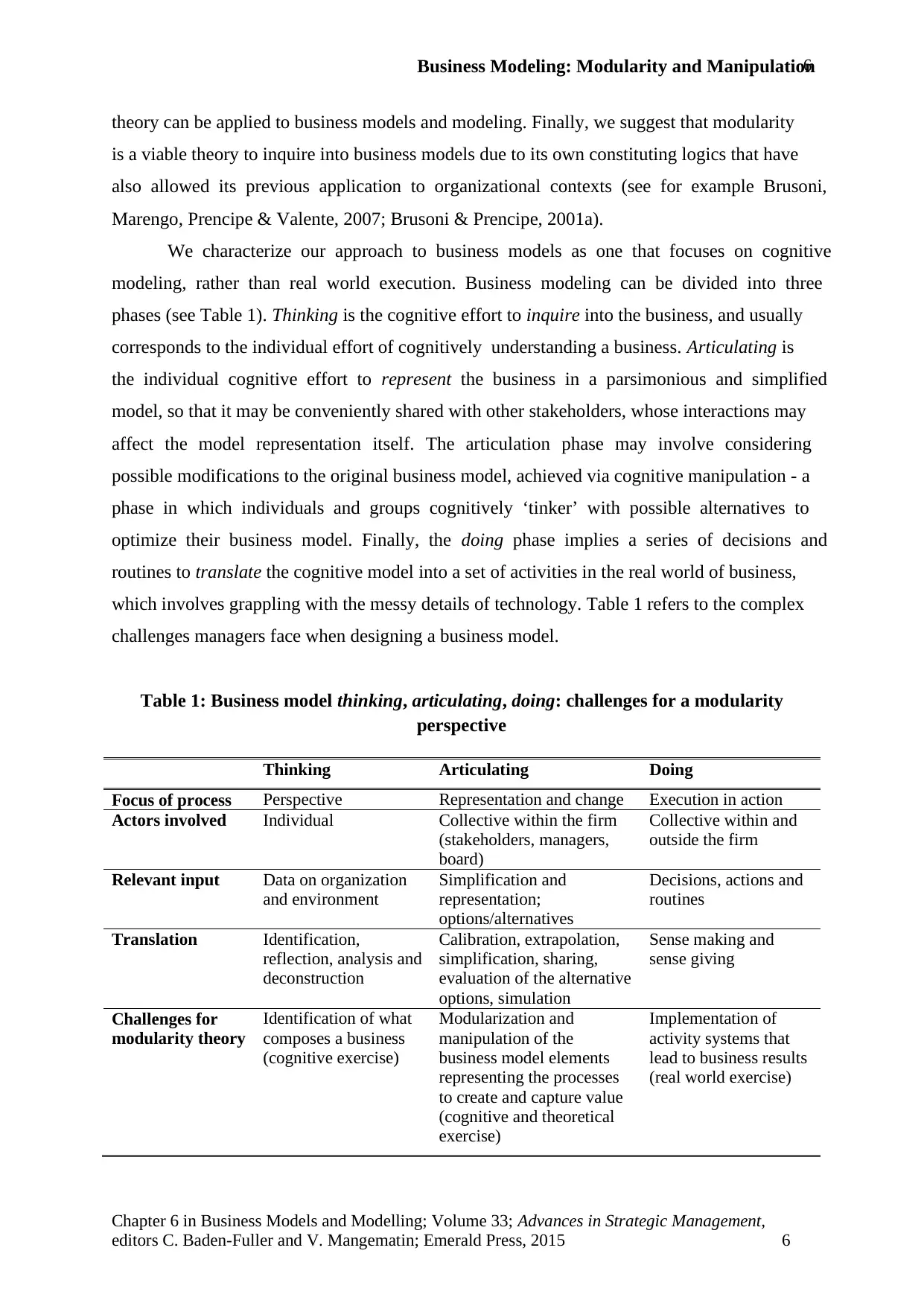
Business Modeling: Modularity and Manipulation
Chapter 6 in Business Models and Modelling; Volume 33; Advances in Strategic Management,
editors C. Baden-Fuller and V. Mangematin; Emerald Press, 2015 6
6
theory can be applied to business models and modeling. Finally, we suggest that modularity
is a viable theory to inquire into business models due to its own constituting logics that have
also allowed its previous application to organizational contexts (see for example Brusoni,
Marengo, Prencipe & Valente, 2007; Brusoni & Prencipe, 2001a).
We characterize our approach to business models as one that focuses on cognitive
modeling, rather than real world execution. Business modeling can be divided into three
phases (see Table 1). Thinking is the cognitive effort to inquire into the business, and usually
corresponds to the individual effort of cognitively understanding a business. Articulating is
the individual cognitive effort to represent the business in a parsimonious and simplified
model, so that it may be conveniently shared with other stakeholders, whose interactions may
affect the model representation itself. The articulation phase may involve considering
possible modifications to the original business model, achieved via cognitive manipulation - a
phase in which individuals and groups cognitively ‘tinker’ with possible alternatives to
optimize their business model. Finally, the doing phase implies a series of decisions and
routines to translate the cognitive model into a set of activities in the real world of business,
which involves grappling with the messy details of technology. Table 1 refers to the complex
challenges managers face when designing a business model.
Table 1: Business model thinking, articulating, doing: challenges for a modularity
perspective
Thinking Articulating Doing
Focus of process Perspective Representation and change Execution in action
Actors involved Individual Collective within the firm
(stakeholders, managers,
board)
Collective within and
outside the firm
Relevant input Data on organization
and environment
Simplification and
representation;
options/alternatives
Decisions, actions and
routines
Translation Identification,
reflection, analysis and
deconstruction
Calibration, extrapolation,
simplification, sharing,
evaluation of the alternative
options, simulation
Sense making and
sense giving
Challenges for
modularity theory
Identification of what
composes a business
(cognitive exercise)
Modularization and
manipulation of the
business model elements
representing the processes
to create and capture value
(cognitive and theoretical
exercise)
Implementation of
activity systems that
lead to business results
(real world exercise)
Chapter 6 in Business Models and Modelling; Volume 33; Advances in Strategic Management,
editors C. Baden-Fuller and V. Mangematin; Emerald Press, 2015 6
6
theory can be applied to business models and modeling. Finally, we suggest that modularity
is a viable theory to inquire into business models due to its own constituting logics that have
also allowed its previous application to organizational contexts (see for example Brusoni,
Marengo, Prencipe & Valente, 2007; Brusoni & Prencipe, 2001a).
We characterize our approach to business models as one that focuses on cognitive
modeling, rather than real world execution. Business modeling can be divided into three
phases (see Table 1). Thinking is the cognitive effort to inquire into the business, and usually
corresponds to the individual effort of cognitively understanding a business. Articulating is
the individual cognitive effort to represent the business in a parsimonious and simplified
model, so that it may be conveniently shared with other stakeholders, whose interactions may
affect the model representation itself. The articulation phase may involve considering
possible modifications to the original business model, achieved via cognitive manipulation - a
phase in which individuals and groups cognitively ‘tinker’ with possible alternatives to
optimize their business model. Finally, the doing phase implies a series of decisions and
routines to translate the cognitive model into a set of activities in the real world of business,
which involves grappling with the messy details of technology. Table 1 refers to the complex
challenges managers face when designing a business model.
Table 1: Business model thinking, articulating, doing: challenges for a modularity
perspective
Thinking Articulating Doing
Focus of process Perspective Representation and change Execution in action
Actors involved Individual Collective within the firm
(stakeholders, managers,
board)
Collective within and
outside the firm
Relevant input Data on organization
and environment
Simplification and
representation;
options/alternatives
Decisions, actions and
routines
Translation Identification,
reflection, analysis and
deconstruction
Calibration, extrapolation,
simplification, sharing,
evaluation of the alternative
options, simulation
Sense making and
sense giving
Challenges for
modularity theory
Identification of what
composes a business
(cognitive exercise)
Modularization and
manipulation of the
business model elements
representing the processes
to create and capture value
(cognitive and theoretical
exercise)
Implementation of
activity systems that
lead to business results
(real world exercise)
Paraphrase This Document
Need a fresh take? Get an instant paraphrase of this document with our AI Paraphraser
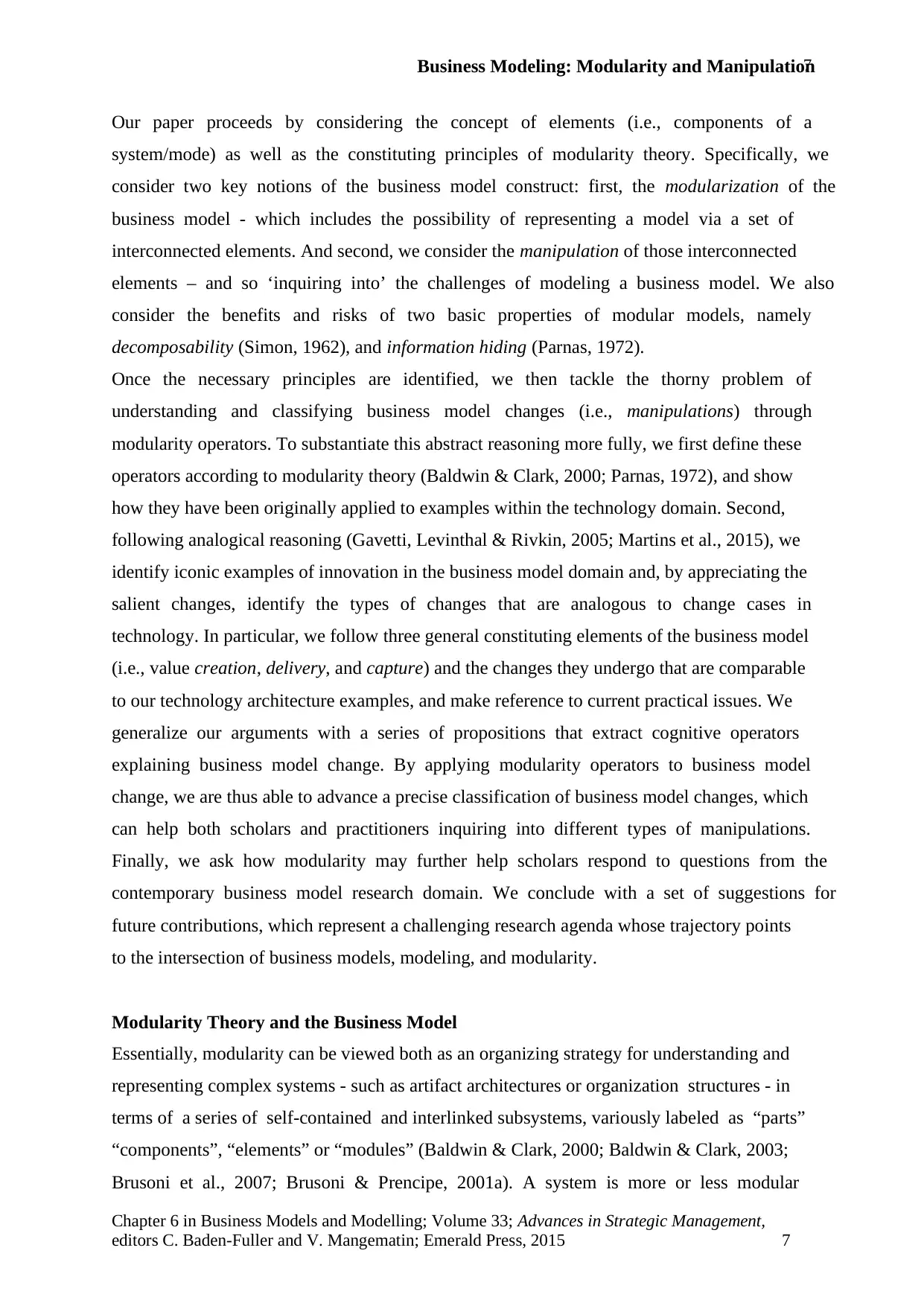
Business Modeling: Modularity and Manipulation
Chapter 6 in Business Models and Modelling; Volume 33; Advances in Strategic Management,
editors C. Baden-Fuller and V. Mangematin; Emerald Press, 2015 7
7
Our paper proceeds by considering the concept of elements (i.e., components of a
system/mode) as well as the constituting principles of modularity theory. Specifically, we
consider two key notions of the business model construct: first, the modularization of the
business model - which includes the possibility of representing a model via a set of
interconnected elements. And second, we consider the manipulation of those interconnected
elements – and so ‘inquiring into’ the challenges of modeling a business model. We also
consider the benefits and risks of two basic properties of modular models, namely
decomposability (Simon, 1962), and information hiding (Parnas, 1972).
Once the necessary principles are identified, we then tackle the thorny problem of
understanding and classifying business model changes (i.e., manipulations) through
modularity operators. To substantiate this abstract reasoning more fully, we first define these
operators according to modularity theory (Baldwin & Clark, 2000; Parnas, 1972), and show
how they have been originally applied to examples within the technology domain. Second,
following analogical reasoning (Gavetti, Levinthal & Rivkin, 2005; Martins et al., 2015), we
identify iconic examples of innovation in the business model domain and, by appreciating the
salient changes, identify the types of changes that are analogous to change cases in
technology. In particular, we follow three general constituting elements of the business model
(i.e., value creation, delivery, and capture) and the changes they undergo that are comparable
to our technology architecture examples, and make reference to current practical issues. We
generalize our arguments with a series of propositions that extract cognitive operators
explaining business model change. By applying modularity operators to business model
change, we are thus able to advance a precise classification of business model changes, which
can help both scholars and practitioners inquiring into different types of manipulations.
Finally, we ask how modularity may further help scholars respond to questions from the
contemporary business model research domain. We conclude with a set of suggestions for
future contributions, which represent a challenging research agenda whose trajectory points
to the intersection of business models, modeling, and modularity.
Modularity Theory and the Business Model
Essentially, modularity can be viewed both as an organizing strategy for understanding and
representing complex systems - such as artifact architectures or organization structures - in
terms of a series of self-contained and interlinked subsystems, variously labeled as “parts”
“components”, “elements” or “modules” (Baldwin & Clark, 2000; Baldwin & Clark, 2003;
Brusoni et al., 2007; Brusoni & Prencipe, 2001a). A system is more or less modular
Chapter 6 in Business Models and Modelling; Volume 33; Advances in Strategic Management,
editors C. Baden-Fuller and V. Mangematin; Emerald Press, 2015 7
7
Our paper proceeds by considering the concept of elements (i.e., components of a
system/mode) as well as the constituting principles of modularity theory. Specifically, we
consider two key notions of the business model construct: first, the modularization of the
business model - which includes the possibility of representing a model via a set of
interconnected elements. And second, we consider the manipulation of those interconnected
elements – and so ‘inquiring into’ the challenges of modeling a business model. We also
consider the benefits and risks of two basic properties of modular models, namely
decomposability (Simon, 1962), and information hiding (Parnas, 1972).
Once the necessary principles are identified, we then tackle the thorny problem of
understanding and classifying business model changes (i.e., manipulations) through
modularity operators. To substantiate this abstract reasoning more fully, we first define these
operators according to modularity theory (Baldwin & Clark, 2000; Parnas, 1972), and show
how they have been originally applied to examples within the technology domain. Second,
following analogical reasoning (Gavetti, Levinthal & Rivkin, 2005; Martins et al., 2015), we
identify iconic examples of innovation in the business model domain and, by appreciating the
salient changes, identify the types of changes that are analogous to change cases in
technology. In particular, we follow three general constituting elements of the business model
(i.e., value creation, delivery, and capture) and the changes they undergo that are comparable
to our technology architecture examples, and make reference to current practical issues. We
generalize our arguments with a series of propositions that extract cognitive operators
explaining business model change. By applying modularity operators to business model
change, we are thus able to advance a precise classification of business model changes, which
can help both scholars and practitioners inquiring into different types of manipulations.
Finally, we ask how modularity may further help scholars respond to questions from the
contemporary business model research domain. We conclude with a set of suggestions for
future contributions, which represent a challenging research agenda whose trajectory points
to the intersection of business models, modeling, and modularity.
Modularity Theory and the Business Model
Essentially, modularity can be viewed both as an organizing strategy for understanding and
representing complex systems - such as artifact architectures or organization structures - in
terms of a series of self-contained and interlinked subsystems, variously labeled as “parts”
“components”, “elements” or “modules” (Baldwin & Clark, 2000; Baldwin & Clark, 2003;
Brusoni et al., 2007; Brusoni & Prencipe, 2001a). A system is more or less modular
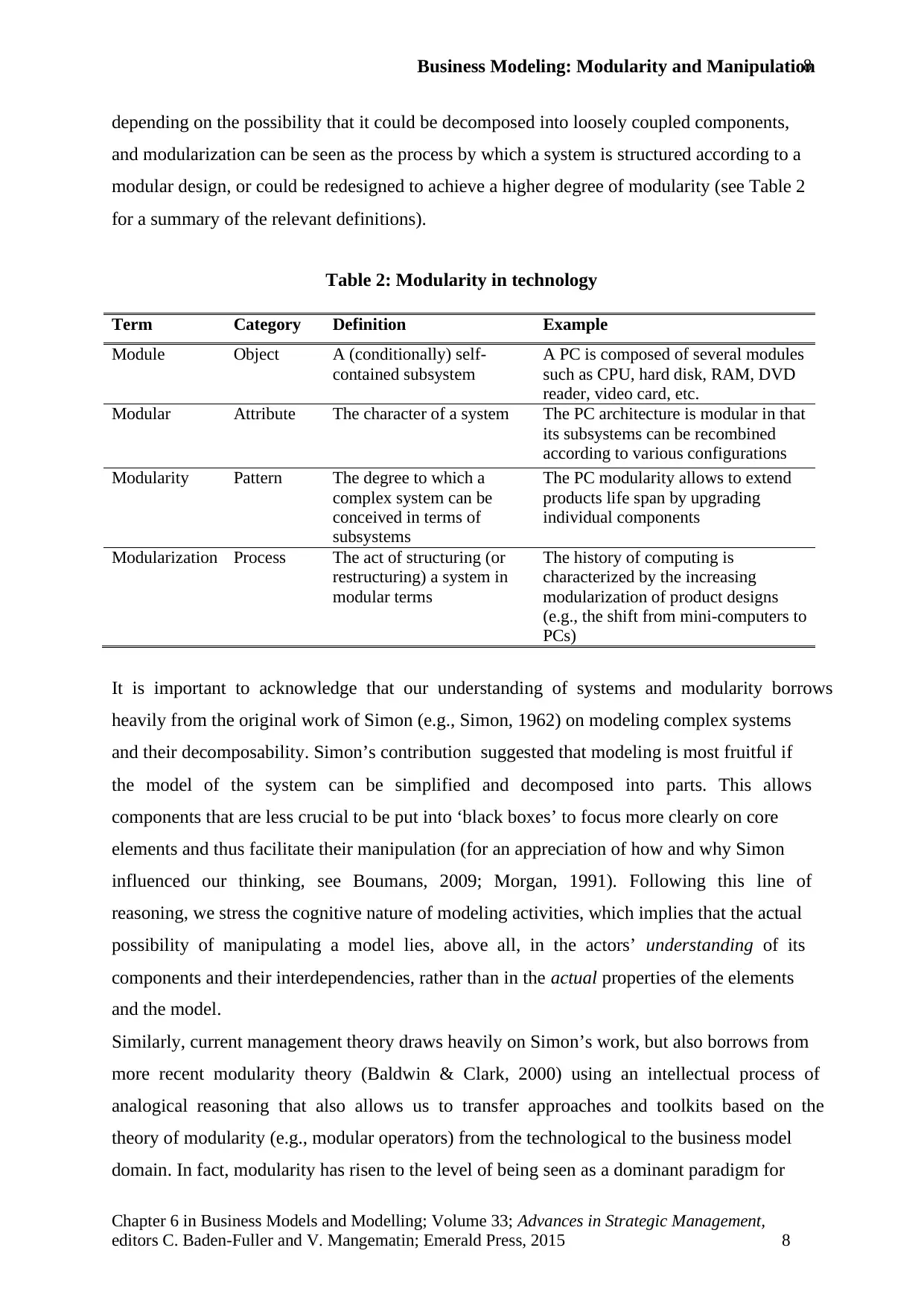
Business Modeling: Modularity and Manipulation
Chapter 6 in Business Models and Modelling; Volume 33; Advances in Strategic Management,
editors C. Baden-Fuller and V. Mangematin; Emerald Press, 2015 8
8
depending on the possibility that it could be decomposed into loosely coupled components,
and modularization can be seen as the process by which a system is structured according to a
modular design, or could be redesigned to achieve a higher degree of modularity (see Table 2
for a summary of the relevant definitions).
Table 2: Modularity in technology
Term Category Definition Example
Module Object A (conditionally) self-
contained subsystem
A PC is composed of several modules
such as CPU, hard disk, RAM, DVD
reader, video card, etc.
Modular Attribute The character of a system The PC architecture is modular in that
its subsystems can be recombined
according to various configurations
Modularity Pattern The degree to which a
complex system can be
conceived in terms of
subsystems
The PC modularity allows to extend
products life span by upgrading
individual components
Modularization Process The act of structuring (or
restructuring) a system in
modular terms
The history of computing is
characterized by the increasing
modularization of product designs
(e.g., the shift from mini-computers to
PCs)
It is important to acknowledge that our understanding of systems and modularity borrows
heavily from the original work of Simon (e.g., Simon, 1962) on modeling complex systems
and their decomposability. Simon’s contribution suggested that modeling is most fruitful if
the model of the system can be simplified and decomposed into parts. This allows
components that are less crucial to be put into ‘black boxes’ to focus more clearly on core
elements and thus facilitate their manipulation (for an appreciation of how and why Simon
influenced our thinking, see Boumans, 2009; Morgan, 1991). Following this line of
reasoning, we stress the cognitive nature of modeling activities, which implies that the actual
possibility of manipulating a model lies, above all, in the actors’ understanding of its
components and their interdependencies, rather than in the actual properties of the elements
and the model.
Similarly, current management theory draws heavily on Simon’s work, but also borrows from
more recent modularity theory (Baldwin & Clark, 2000) using an intellectual process of
analogical reasoning that also allows us to transfer approaches and toolkits based on the
theory of modularity (e.g., modular operators) from the technological to the business model
domain. In fact, modularity has risen to the level of being seen as a dominant paradigm for
Chapter 6 in Business Models and Modelling; Volume 33; Advances in Strategic Management,
editors C. Baden-Fuller and V. Mangematin; Emerald Press, 2015 8
8
depending on the possibility that it could be decomposed into loosely coupled components,
and modularization can be seen as the process by which a system is structured according to a
modular design, or could be redesigned to achieve a higher degree of modularity (see Table 2
for a summary of the relevant definitions).
Table 2: Modularity in technology
Term Category Definition Example
Module Object A (conditionally) self-
contained subsystem
A PC is composed of several modules
such as CPU, hard disk, RAM, DVD
reader, video card, etc.
Modular Attribute The character of a system The PC architecture is modular in that
its subsystems can be recombined
according to various configurations
Modularity Pattern The degree to which a
complex system can be
conceived in terms of
subsystems
The PC modularity allows to extend
products life span by upgrading
individual components
Modularization Process The act of structuring (or
restructuring) a system in
modular terms
The history of computing is
characterized by the increasing
modularization of product designs
(e.g., the shift from mini-computers to
PCs)
It is important to acknowledge that our understanding of systems and modularity borrows
heavily from the original work of Simon (e.g., Simon, 1962) on modeling complex systems
and their decomposability. Simon’s contribution suggested that modeling is most fruitful if
the model of the system can be simplified and decomposed into parts. This allows
components that are less crucial to be put into ‘black boxes’ to focus more clearly on core
elements and thus facilitate their manipulation (for an appreciation of how and why Simon
influenced our thinking, see Boumans, 2009; Morgan, 1991). Following this line of
reasoning, we stress the cognitive nature of modeling activities, which implies that the actual
possibility of manipulating a model lies, above all, in the actors’ understanding of its
components and their interdependencies, rather than in the actual properties of the elements
and the model.
Similarly, current management theory draws heavily on Simon’s work, but also borrows from
more recent modularity theory (Baldwin & Clark, 2000) using an intellectual process of
analogical reasoning that also allows us to transfer approaches and toolkits based on the
theory of modularity (e.g., modular operators) from the technological to the business model
domain. In fact, modularity has risen to the level of being seen as a dominant paradigm for
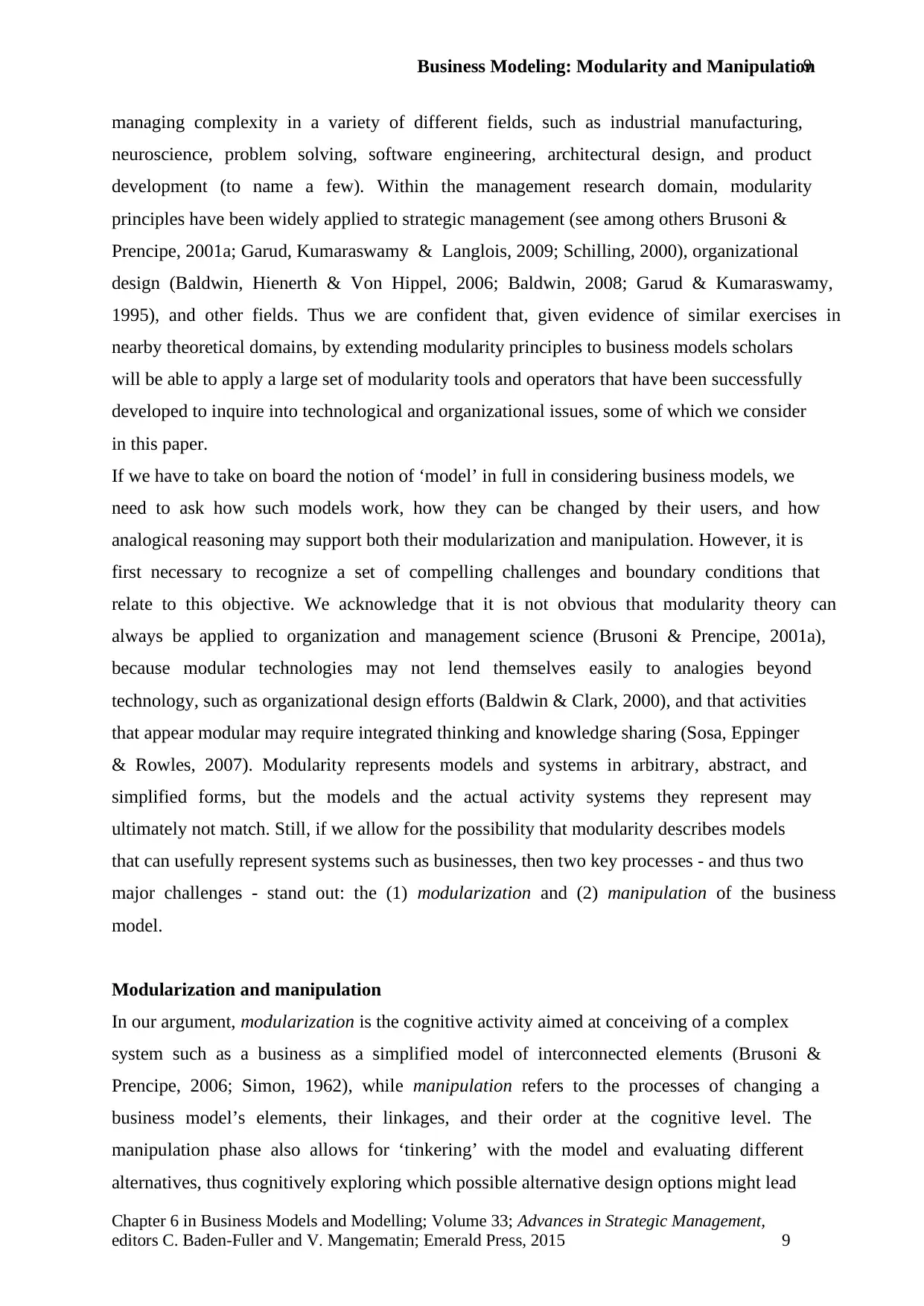
Business Modeling: Modularity and Manipulation
Chapter 6 in Business Models and Modelling; Volume 33; Advances in Strategic Management,
editors C. Baden-Fuller and V. Mangematin; Emerald Press, 2015 9
9
managing complexity in a variety of different fields, such as industrial manufacturing,
neuroscience, problem solving, software engineering, architectural design, and product
development (to name a few). Within the management research domain, modularity
principles have been widely applied to strategic management (see among others Brusoni &
Prencipe, 2001a; Garud, Kumaraswamy & Langlois, 2009; Schilling, 2000), organizational
design (Baldwin, Hienerth & Von Hippel, 2006; Baldwin, 2008; Garud & Kumaraswamy,
1995), and other fields. Thus we are confident that, given evidence of similar exercises in
nearby theoretical domains, by extending modularity principles to business models scholars
will be able to apply a large set of modularity tools and operators that have been successfully
developed to inquire into technological and organizational issues, some of which we consider
in this paper.
If we have to take on board the notion of ‘model’ in full in considering business models, we
need to ask how such models work, how they can be changed by their users, and how
analogical reasoning may support both their modularization and manipulation. However, it is
first necessary to recognize a set of compelling challenges and boundary conditions that
relate to this objective. We acknowledge that it is not obvious that modularity theory can
always be applied to organization and management science (Brusoni & Prencipe, 2001a),
because modular technologies may not lend themselves easily to analogies beyond
technology, such as organizational design efforts (Baldwin & Clark, 2000), and that activities
that appear modular may require integrated thinking and knowledge sharing (Sosa, Eppinger
& Rowles, 2007). Modularity represents models and systems in arbitrary, abstract, and
simplified forms, but the models and the actual activity systems they represent may
ultimately not match. Still, if we allow for the possibility that modularity describes models
that can usefully represent systems such as businesses, then two key processes - and thus two
major challenges - stand out: the (1) modularization and (2) manipulation of the business
model.
Modularization and manipulation
In our argument, modularization is the cognitive activity aimed at conceiving of a complex
system such as a business as a simplified model of interconnected elements (Brusoni &
Prencipe, 2006; Simon, 1962), while manipulation refers to the processes of changing a
business model’s elements, their linkages, and their order at the cognitive level. The
manipulation phase also allows for ‘tinkering’ with the model and evaluating different
alternatives, thus cognitively exploring which possible alternative design options might lead
Chapter 6 in Business Models and Modelling; Volume 33; Advances in Strategic Management,
editors C. Baden-Fuller and V. Mangematin; Emerald Press, 2015 9
9
managing complexity in a variety of different fields, such as industrial manufacturing,
neuroscience, problem solving, software engineering, architectural design, and product
development (to name a few). Within the management research domain, modularity
principles have been widely applied to strategic management (see among others Brusoni &
Prencipe, 2001a; Garud, Kumaraswamy & Langlois, 2009; Schilling, 2000), organizational
design (Baldwin, Hienerth & Von Hippel, 2006; Baldwin, 2008; Garud & Kumaraswamy,
1995), and other fields. Thus we are confident that, given evidence of similar exercises in
nearby theoretical domains, by extending modularity principles to business models scholars
will be able to apply a large set of modularity tools and operators that have been successfully
developed to inquire into technological and organizational issues, some of which we consider
in this paper.
If we have to take on board the notion of ‘model’ in full in considering business models, we
need to ask how such models work, how they can be changed by their users, and how
analogical reasoning may support both their modularization and manipulation. However, it is
first necessary to recognize a set of compelling challenges and boundary conditions that
relate to this objective. We acknowledge that it is not obvious that modularity theory can
always be applied to organization and management science (Brusoni & Prencipe, 2001a),
because modular technologies may not lend themselves easily to analogies beyond
technology, such as organizational design efforts (Baldwin & Clark, 2000), and that activities
that appear modular may require integrated thinking and knowledge sharing (Sosa, Eppinger
& Rowles, 2007). Modularity represents models and systems in arbitrary, abstract, and
simplified forms, but the models and the actual activity systems they represent may
ultimately not match. Still, if we allow for the possibility that modularity describes models
that can usefully represent systems such as businesses, then two key processes - and thus two
major challenges - stand out: the (1) modularization and (2) manipulation of the business
model.
Modularization and manipulation
In our argument, modularization is the cognitive activity aimed at conceiving of a complex
system such as a business as a simplified model of interconnected elements (Brusoni &
Prencipe, 2006; Simon, 1962), while manipulation refers to the processes of changing a
business model’s elements, their linkages, and their order at the cognitive level. The
manipulation phase also allows for ‘tinkering’ with the model and evaluating different
alternatives, thus cognitively exploring which possible alternative design options might lead
Secure Best Marks with AI Grader
Need help grading? Try our AI Grader for instant feedback on your assignments.
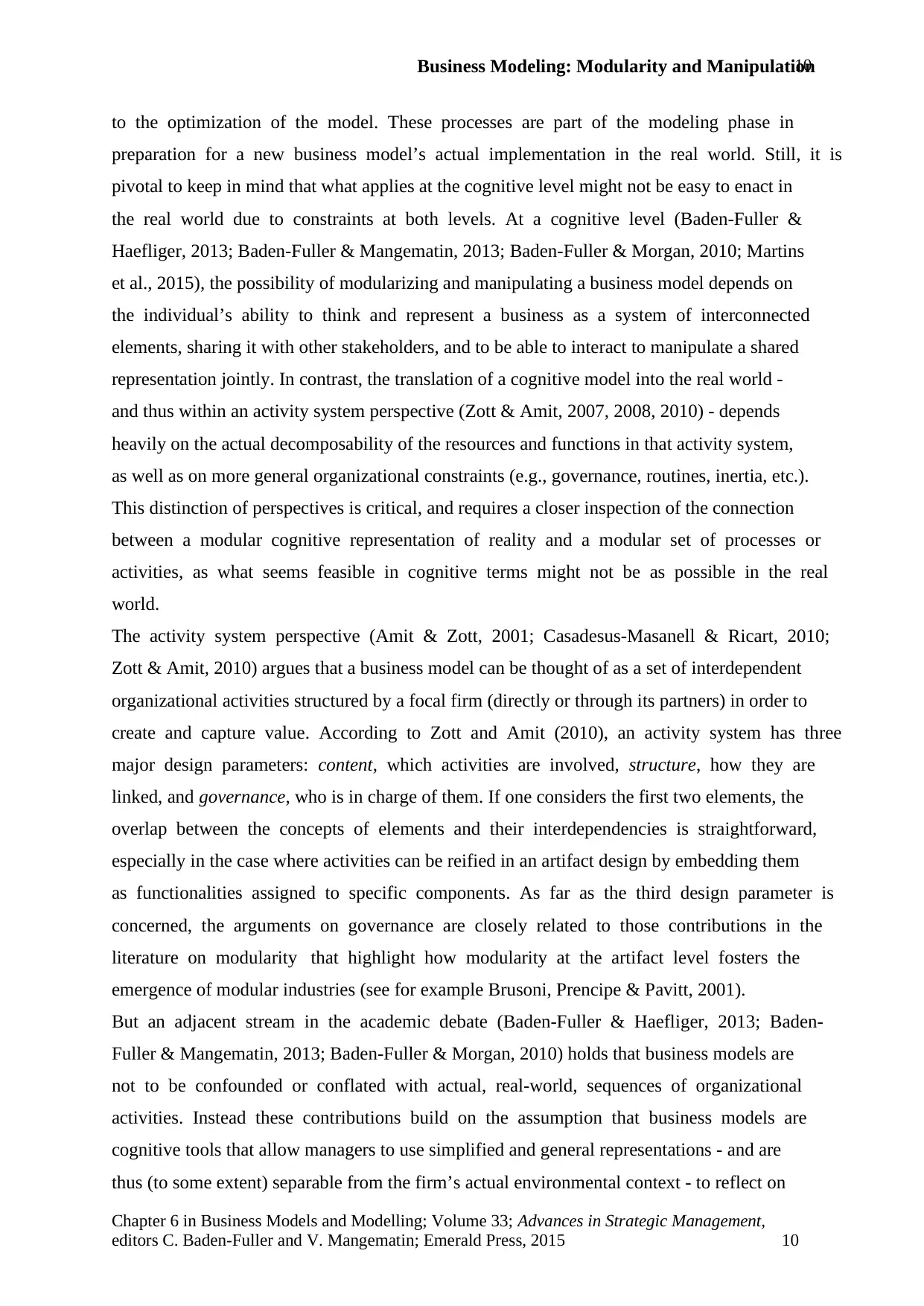
Business Modeling: Modularity and Manipulation
Chapter 6 in Business Models and Modelling; Volume 33; Advances in Strategic Management,
editors C. Baden-Fuller and V. Mangematin; Emerald Press, 2015 10
10
to the optimization of the model. These processes are part of the modeling phase in
preparation for a new business model’s actual implementation in the real world. Still, it is
pivotal to keep in mind that what applies at the cognitive level might not be easy to enact in
the real world due to constraints at both levels. At a cognitive level (Baden-Fuller &
Haefliger, 2013; Baden-Fuller & Mangematin, 2013; Baden-Fuller & Morgan, 2010; Martins
et al., 2015), the possibility of modularizing and manipulating a business model depends on
the individual’s ability to think and represent a business as a system of interconnected
elements, sharing it with other stakeholders, and to be able to interact to manipulate a shared
representation jointly. In contrast, the translation of a cognitive model into the real world -
and thus within an activity system perspective (Zott & Amit, 2007, 2008, 2010) - depends
heavily on the actual decomposability of the resources and functions in that activity system,
as well as on more general organizational constraints (e.g., governance, routines, inertia, etc.).
This distinction of perspectives is critical, and requires a closer inspection of the connection
between a modular cognitive representation of reality and a modular set of processes or
activities, as what seems feasible in cognitive terms might not be as possible in the real
world.
The activity system perspective (Amit & Zott, 2001; Casadesus-Masanell & Ricart, 2010;
Zott & Amit, 2010) argues that a business model can be thought of as a set of interdependent
organizational activities structured by a focal firm (directly or through its partners) in order to
create and capture value. According to Zott and Amit (2010), an activity system has three
major design parameters: content, which activities are involved, structure, how they are
linked, and governance, who is in charge of them. If one considers the first two elements, the
overlap between the concepts of elements and their interdependencies is straightforward,
especially in the case where activities can be reified in an artifact design by embedding them
as functionalities assigned to specific components. As far as the third design parameter is
concerned, the arguments on governance are closely related to those contributions in the
literature on modularity that highlight how modularity at the artifact level fosters the
emergence of modular industries (see for example Brusoni, Prencipe & Pavitt, 2001).
But an adjacent stream in the academic debate (Baden-Fuller & Haefliger, 2013; Baden-
Fuller & Mangematin, 2013; Baden-Fuller & Morgan, 2010) holds that business models are
not to be confounded or conflated with actual, real-world, sequences of organizational
activities. Instead these contributions build on the assumption that business models are
cognitive tools that allow managers to use simplified and general representations - and are
thus (to some extent) separable from the firm’s actual environmental context - to reflect on
Chapter 6 in Business Models and Modelling; Volume 33; Advances in Strategic Management,
editors C. Baden-Fuller and V. Mangematin; Emerald Press, 2015 10
10
to the optimization of the model. These processes are part of the modeling phase in
preparation for a new business model’s actual implementation in the real world. Still, it is
pivotal to keep in mind that what applies at the cognitive level might not be easy to enact in
the real world due to constraints at both levels. At a cognitive level (Baden-Fuller &
Haefliger, 2013; Baden-Fuller & Mangematin, 2013; Baden-Fuller & Morgan, 2010; Martins
et al., 2015), the possibility of modularizing and manipulating a business model depends on
the individual’s ability to think and represent a business as a system of interconnected
elements, sharing it with other stakeholders, and to be able to interact to manipulate a shared
representation jointly. In contrast, the translation of a cognitive model into the real world -
and thus within an activity system perspective (Zott & Amit, 2007, 2008, 2010) - depends
heavily on the actual decomposability of the resources and functions in that activity system,
as well as on more general organizational constraints (e.g., governance, routines, inertia, etc.).
This distinction of perspectives is critical, and requires a closer inspection of the connection
between a modular cognitive representation of reality and a modular set of processes or
activities, as what seems feasible in cognitive terms might not be as possible in the real
world.
The activity system perspective (Amit & Zott, 2001; Casadesus-Masanell & Ricart, 2010;
Zott & Amit, 2010) argues that a business model can be thought of as a set of interdependent
organizational activities structured by a focal firm (directly or through its partners) in order to
create and capture value. According to Zott and Amit (2010), an activity system has three
major design parameters: content, which activities are involved, structure, how they are
linked, and governance, who is in charge of them. If one considers the first two elements, the
overlap between the concepts of elements and their interdependencies is straightforward,
especially in the case where activities can be reified in an artifact design by embedding them
as functionalities assigned to specific components. As far as the third design parameter is
concerned, the arguments on governance are closely related to those contributions in the
literature on modularity that highlight how modularity at the artifact level fosters the
emergence of modular industries (see for example Brusoni, Prencipe & Pavitt, 2001).
But an adjacent stream in the academic debate (Baden-Fuller & Haefliger, 2013; Baden-
Fuller & Mangematin, 2013; Baden-Fuller & Morgan, 2010) holds that business models are
not to be confounded or conflated with actual, real-world, sequences of organizational
activities. Instead these contributions build on the assumption that business models are
cognitive tools that allow managers to use simplified and general representations - and are
thus (to some extent) separable from the firm’s actual environmental context - to reflect on
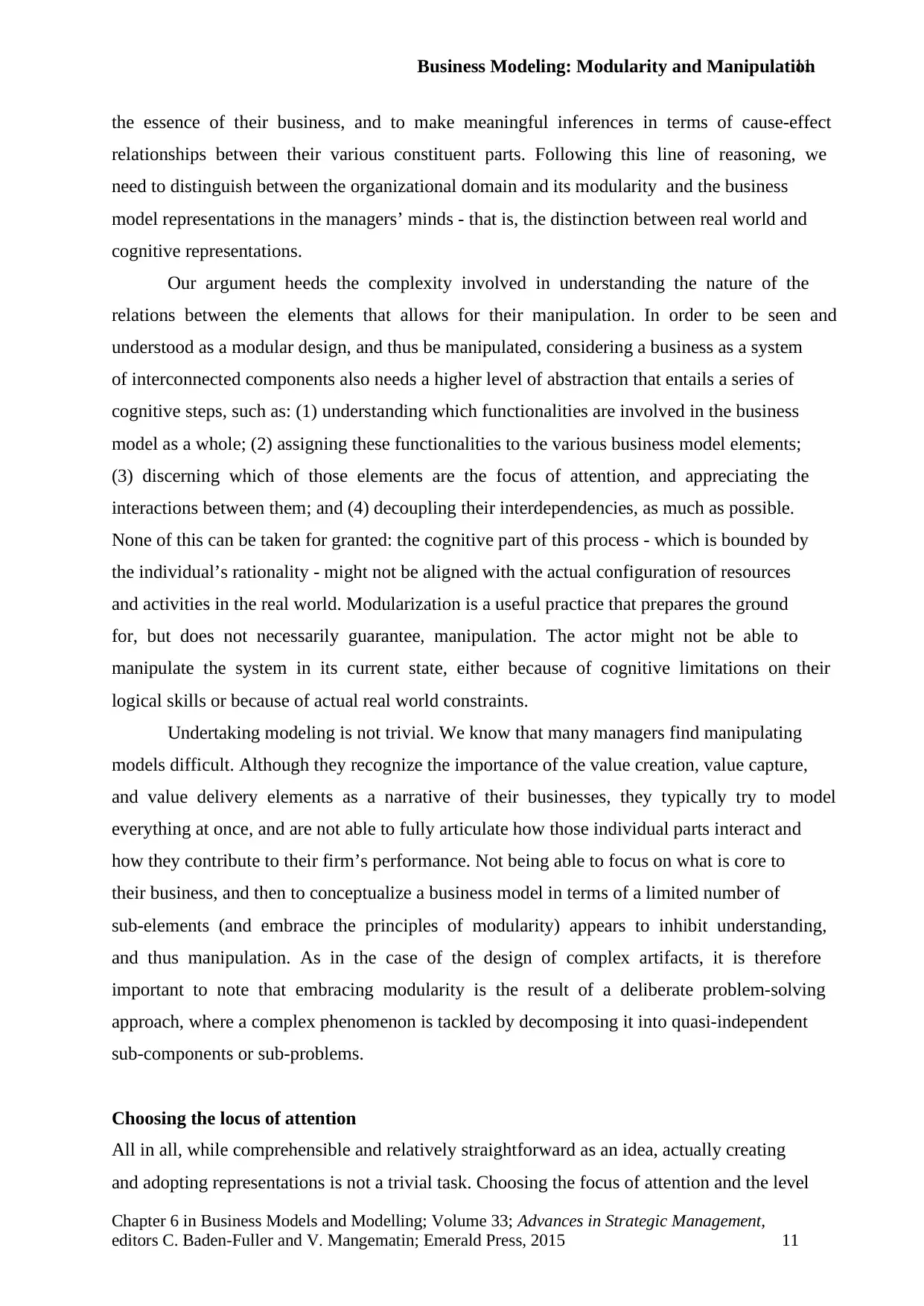
Business Modeling: Modularity and Manipulation
Chapter 6 in Business Models and Modelling; Volume 33; Advances in Strategic Management,
editors C. Baden-Fuller and V. Mangematin; Emerald Press, 2015 11
11
the essence of their business, and to make meaningful inferences in terms of cause-effect
relationships between their various constituent parts. Following this line of reasoning, we
need to distinguish between the organizational domain and its modularity and the business
model representations in the managers’ minds - that is, the distinction between real world and
cognitive representations.
Our argument heeds the complexity involved in understanding the nature of the
relations between the elements that allows for their manipulation. In order to be seen and
understood as a modular design, and thus be manipulated, considering a business as a system
of interconnected components also needs a higher level of abstraction that entails a series of
cognitive steps, such as: (1) understanding which functionalities are involved in the business
model as a whole; (2) assigning these functionalities to the various business model elements;
(3) discerning which of those elements are the focus of attention, and appreciating the
interactions between them; and (4) decoupling their interdependencies, as much as possible.
None of this can be taken for granted: the cognitive part of this process - which is bounded by
the individual’s rationality - might not be aligned with the actual configuration of resources
and activities in the real world. Modularization is a useful practice that prepares the ground
for, but does not necessarily guarantee, manipulation. The actor might not be able to
manipulate the system in its current state, either because of cognitive limitations on their
logical skills or because of actual real world constraints.
Undertaking modeling is not trivial. We know that many managers find manipulating
models difficult. Although they recognize the importance of the value creation, value capture,
and value delivery elements as a narrative of their businesses, they typically try to model
everything at once, and are not able to fully articulate how those individual parts interact and
how they contribute to their firm’s performance. Not being able to focus on what is core to
their business, and then to conceptualize a business model in terms of a limited number of
sub-elements (and embrace the principles of modularity) appears to inhibit understanding,
and thus manipulation. As in the case of the design of complex artifacts, it is therefore
important to note that embracing modularity is the result of a deliberate problem-solving
approach, where a complex phenomenon is tackled by decomposing it into quasi-independent
sub-components or sub-problems.
Choosing the locus of attention
All in all, while comprehensible and relatively straightforward as an idea, actually creating
and adopting representations is not a trivial task. Choosing the focus of attention and the level
Chapter 6 in Business Models and Modelling; Volume 33; Advances in Strategic Management,
editors C. Baden-Fuller and V. Mangematin; Emerald Press, 2015 11
11
the essence of their business, and to make meaningful inferences in terms of cause-effect
relationships between their various constituent parts. Following this line of reasoning, we
need to distinguish between the organizational domain and its modularity and the business
model representations in the managers’ minds - that is, the distinction between real world and
cognitive representations.
Our argument heeds the complexity involved in understanding the nature of the
relations between the elements that allows for their manipulation. In order to be seen and
understood as a modular design, and thus be manipulated, considering a business as a system
of interconnected components also needs a higher level of abstraction that entails a series of
cognitive steps, such as: (1) understanding which functionalities are involved in the business
model as a whole; (2) assigning these functionalities to the various business model elements;
(3) discerning which of those elements are the focus of attention, and appreciating the
interactions between them; and (4) decoupling their interdependencies, as much as possible.
None of this can be taken for granted: the cognitive part of this process - which is bounded by
the individual’s rationality - might not be aligned with the actual configuration of resources
and activities in the real world. Modularization is a useful practice that prepares the ground
for, but does not necessarily guarantee, manipulation. The actor might not be able to
manipulate the system in its current state, either because of cognitive limitations on their
logical skills or because of actual real world constraints.
Undertaking modeling is not trivial. We know that many managers find manipulating
models difficult. Although they recognize the importance of the value creation, value capture,
and value delivery elements as a narrative of their businesses, they typically try to model
everything at once, and are not able to fully articulate how those individual parts interact and
how they contribute to their firm’s performance. Not being able to focus on what is core to
their business, and then to conceptualize a business model in terms of a limited number of
sub-elements (and embrace the principles of modularity) appears to inhibit understanding,
and thus manipulation. As in the case of the design of complex artifacts, it is therefore
important to note that embracing modularity is the result of a deliberate problem-solving
approach, where a complex phenomenon is tackled by decomposing it into quasi-independent
sub-components or sub-problems.
Choosing the locus of attention
All in all, while comprehensible and relatively straightforward as an idea, actually creating
and adopting representations is not a trivial task. Choosing the focus of attention and the level
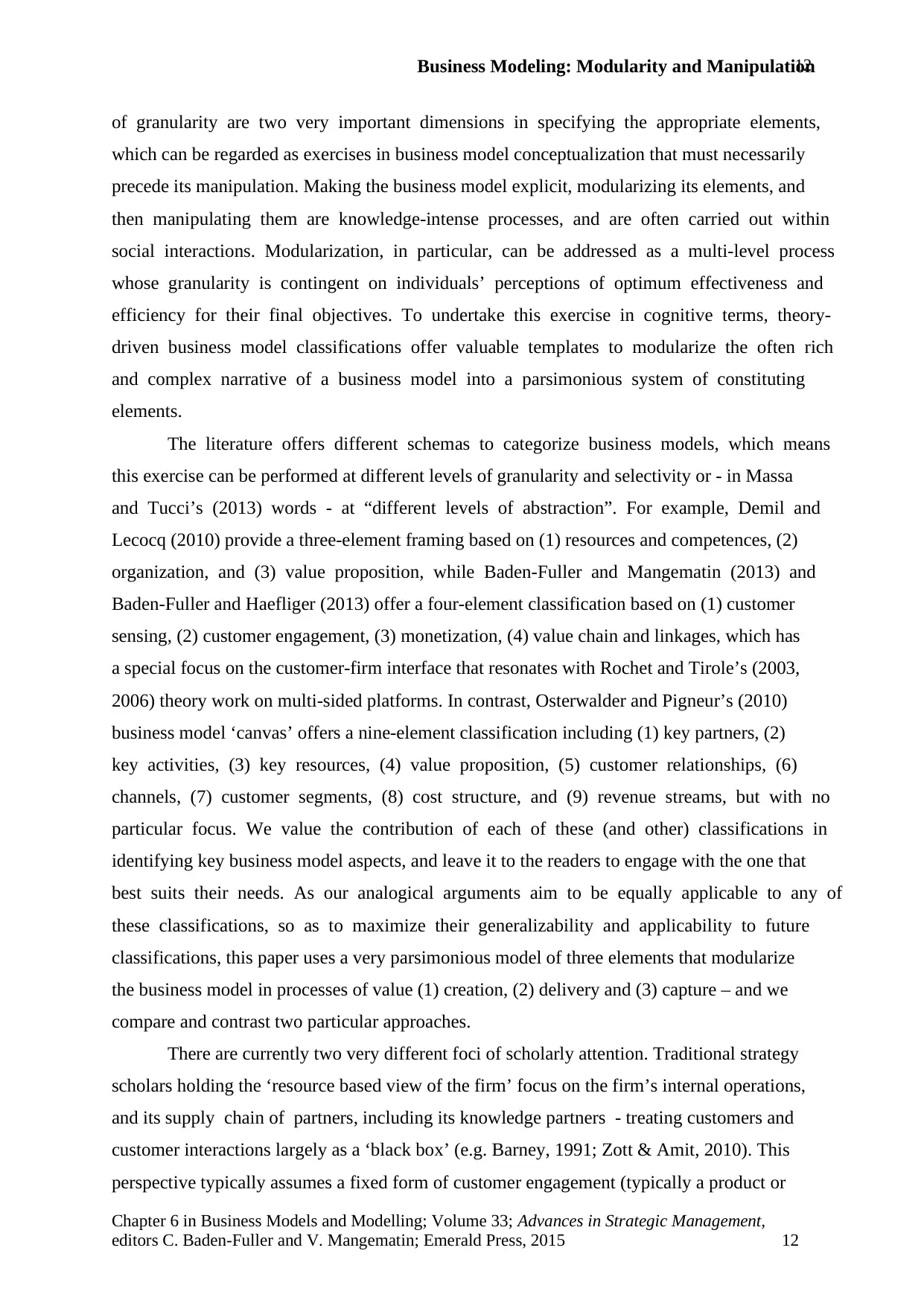
Business Modeling: Modularity and Manipulation
Chapter 6 in Business Models and Modelling; Volume 33; Advances in Strategic Management,
editors C. Baden-Fuller and V. Mangematin; Emerald Press, 2015 12
12
of granularity are two very important dimensions in specifying the appropriate elements,
which can be regarded as exercises in business model conceptualization that must necessarily
precede its manipulation. Making the business model explicit, modularizing its elements, and
then manipulating them are knowledge-intense processes, and are often carried out within
social interactions. Modularization, in particular, can be addressed as a multi-level process
whose granularity is contingent on individuals’ perceptions of optimum effectiveness and
efficiency for their final objectives. To undertake this exercise in cognitive terms, theory-
driven business model classifications offer valuable templates to modularize the often rich
and complex narrative of a business model into a parsimonious system of constituting
elements.
The literature offers different schemas to categorize business models, which means
this exercise can be performed at different levels of granularity and selectivity or - in Massa
and Tucci’s (2013) words - at “different levels of abstraction”. For example, Demil and
Lecocq (2010) provide a three-element framing based on (1) resources and competences, (2)
organization, and (3) value proposition, while Baden-Fuller and Mangematin (2013) and
Baden-Fuller and Haefliger (2013) offer a four-element classification based on (1) customer
sensing, (2) customer engagement, (3) monetization, (4) value chain and linkages, which has
a special focus on the customer-firm interface that resonates with Rochet and Tirole’s (2003,
2006) theory work on multi-sided platforms. In contrast, Osterwalder and Pigneur’s (2010)
business model ‘canvas’ offers a nine-element classification including (1) key partners, (2)
key activities, (3) key resources, (4) value proposition, (5) customer relationships, (6)
channels, (7) customer segments, (8) cost structure, and (9) revenue streams, but with no
particular focus. We value the contribution of each of these (and other) classifications in
identifying key business model aspects, and leave it to the readers to engage with the one that
best suits their needs. As our analogical arguments aim to be equally applicable to any of
these classifications, so as to maximize their generalizability and applicability to future
classifications, this paper uses a very parsimonious model of three elements that modularize
the business model in processes of value (1) creation, (2) delivery and (3) capture – and we
compare and contrast two particular approaches.
There are currently two very different foci of scholarly attention. Traditional strategy
scholars holding the ‘resource based view of the firm’ focus on the firm’s internal operations,
and its supply chain of partners, including its knowledge partners - treating customers and
customer interactions largely as a ‘black box’ (e.g. Barney, 1991; Zott & Amit, 2010). This
perspective typically assumes a fixed form of customer engagement (typically a product or
Chapter 6 in Business Models and Modelling; Volume 33; Advances in Strategic Management,
editors C. Baden-Fuller and V. Mangematin; Emerald Press, 2015 12
12
of granularity are two very important dimensions in specifying the appropriate elements,
which can be regarded as exercises in business model conceptualization that must necessarily
precede its manipulation. Making the business model explicit, modularizing its elements, and
then manipulating them are knowledge-intense processes, and are often carried out within
social interactions. Modularization, in particular, can be addressed as a multi-level process
whose granularity is contingent on individuals’ perceptions of optimum effectiveness and
efficiency for their final objectives. To undertake this exercise in cognitive terms, theory-
driven business model classifications offer valuable templates to modularize the often rich
and complex narrative of a business model into a parsimonious system of constituting
elements.
The literature offers different schemas to categorize business models, which means
this exercise can be performed at different levels of granularity and selectivity or - in Massa
and Tucci’s (2013) words - at “different levels of abstraction”. For example, Demil and
Lecocq (2010) provide a three-element framing based on (1) resources and competences, (2)
organization, and (3) value proposition, while Baden-Fuller and Mangematin (2013) and
Baden-Fuller and Haefliger (2013) offer a four-element classification based on (1) customer
sensing, (2) customer engagement, (3) monetization, (4) value chain and linkages, which has
a special focus on the customer-firm interface that resonates with Rochet and Tirole’s (2003,
2006) theory work on multi-sided platforms. In contrast, Osterwalder and Pigneur’s (2010)
business model ‘canvas’ offers a nine-element classification including (1) key partners, (2)
key activities, (3) key resources, (4) value proposition, (5) customer relationships, (6)
channels, (7) customer segments, (8) cost structure, and (9) revenue streams, but with no
particular focus. We value the contribution of each of these (and other) classifications in
identifying key business model aspects, and leave it to the readers to engage with the one that
best suits their needs. As our analogical arguments aim to be equally applicable to any of
these classifications, so as to maximize their generalizability and applicability to future
classifications, this paper uses a very parsimonious model of three elements that modularize
the business model in processes of value (1) creation, (2) delivery and (3) capture – and we
compare and contrast two particular approaches.
There are currently two very different foci of scholarly attention. Traditional strategy
scholars holding the ‘resource based view of the firm’ focus on the firm’s internal operations,
and its supply chain of partners, including its knowledge partners - treating customers and
customer interactions largely as a ‘black box’ (e.g. Barney, 1991; Zott & Amit, 2010). This
perspective typically assumes a fixed form of customer engagement (typically a product or
Paraphrase This Document
Need a fresh take? Get an instant paraphrase of this document with our AI Paraphraser
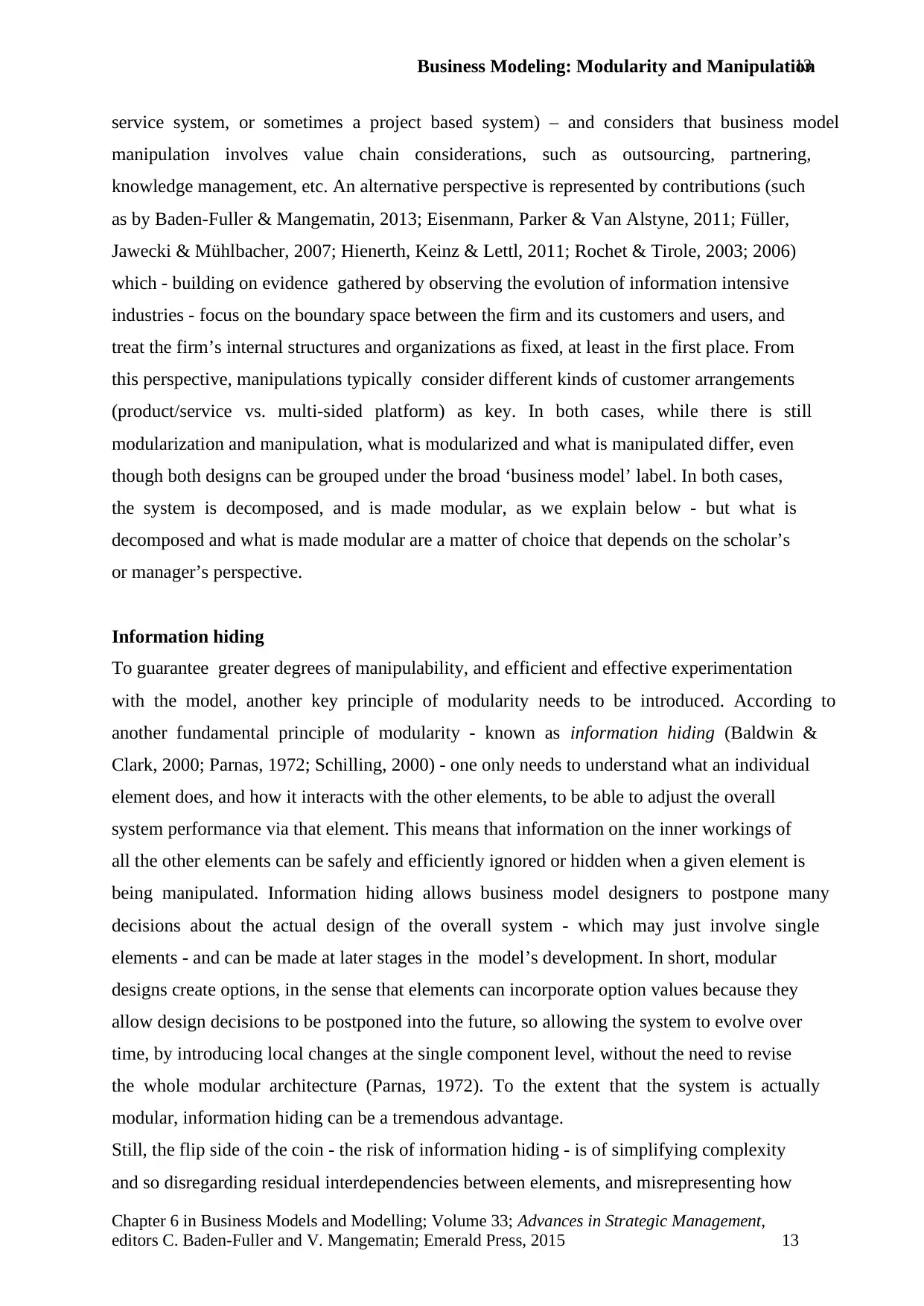
Business Modeling: Modularity and Manipulation
Chapter 6 in Business Models and Modelling; Volume 33; Advances in Strategic Management,
editors C. Baden-Fuller and V. Mangematin; Emerald Press, 2015 13
13
service system, or sometimes a project based system) – and considers that business model
manipulation involves value chain considerations, such as outsourcing, partnering,
knowledge management, etc. An alternative perspective is represented by contributions (such
as by Baden-Fuller & Mangematin, 2013; Eisenmann, Parker & Van Alstyne, 2011; Füller,
Jawecki & Mühlbacher, 2007; Hienerth, Keinz & Lettl, 2011; Rochet & Tirole, 2003; 2006)
which - building on evidence gathered by observing the evolution of information intensive
industries - focus on the boundary space between the firm and its customers and users, and
treat the firm’s internal structures and organizations as fixed, at least in the first place. From
this perspective, manipulations typically consider different kinds of customer arrangements
(product/service vs. multi-sided platform) as key. In both cases, while there is still
modularization and manipulation, what is modularized and what is manipulated differ, even
though both designs can be grouped under the broad ‘business model’ label. In both cases,
the system is decomposed, and is made modular, as we explain below - but what is
decomposed and what is made modular are a matter of choice that depends on the scholar’s
or manager’s perspective.
Information hiding
To guarantee greater degrees of manipulability, and efficient and effective experimentation
with the model, another key principle of modularity needs to be introduced. According to
another fundamental principle of modularity - known as information hiding (Baldwin &
Clark, 2000; Parnas, 1972; Schilling, 2000) - one only needs to understand what an individual
element does, and how it interacts with the other elements, to be able to adjust the overall
system performance via that element. This means that information on the inner workings of
all the other elements can be safely and efficiently ignored or hidden when a given element is
being manipulated. Information hiding allows business model designers to postpone many
decisions about the actual design of the overall system - which may just involve single
elements - and can be made at later stages in the model’s development. In short, modular
designs create options, in the sense that elements can incorporate option values because they
allow design decisions to be postponed into the future, so allowing the system to evolve over
time, by introducing local changes at the single component level, without the need to revise
the whole modular architecture (Parnas, 1972). To the extent that the system is actually
modular, information hiding can be a tremendous advantage.
Still, the flip side of the coin - the risk of information hiding - is of simplifying complexity
and so disregarding residual interdependencies between elements, and misrepresenting how
Chapter 6 in Business Models and Modelling; Volume 33; Advances in Strategic Management,
editors C. Baden-Fuller and V. Mangematin; Emerald Press, 2015 13
13
service system, or sometimes a project based system) – and considers that business model
manipulation involves value chain considerations, such as outsourcing, partnering,
knowledge management, etc. An alternative perspective is represented by contributions (such
as by Baden-Fuller & Mangematin, 2013; Eisenmann, Parker & Van Alstyne, 2011; Füller,
Jawecki & Mühlbacher, 2007; Hienerth, Keinz & Lettl, 2011; Rochet & Tirole, 2003; 2006)
which - building on evidence gathered by observing the evolution of information intensive
industries - focus on the boundary space between the firm and its customers and users, and
treat the firm’s internal structures and organizations as fixed, at least in the first place. From
this perspective, manipulations typically consider different kinds of customer arrangements
(product/service vs. multi-sided platform) as key. In both cases, while there is still
modularization and manipulation, what is modularized and what is manipulated differ, even
though both designs can be grouped under the broad ‘business model’ label. In both cases,
the system is decomposed, and is made modular, as we explain below - but what is
decomposed and what is made modular are a matter of choice that depends on the scholar’s
or manager’s perspective.
Information hiding
To guarantee greater degrees of manipulability, and efficient and effective experimentation
with the model, another key principle of modularity needs to be introduced. According to
another fundamental principle of modularity - known as information hiding (Baldwin &
Clark, 2000; Parnas, 1972; Schilling, 2000) - one only needs to understand what an individual
element does, and how it interacts with the other elements, to be able to adjust the overall
system performance via that element. This means that information on the inner workings of
all the other elements can be safely and efficiently ignored or hidden when a given element is
being manipulated. Information hiding allows business model designers to postpone many
decisions about the actual design of the overall system - which may just involve single
elements - and can be made at later stages in the model’s development. In short, modular
designs create options, in the sense that elements can incorporate option values because they
allow design decisions to be postponed into the future, so allowing the system to evolve over
time, by introducing local changes at the single component level, without the need to revise
the whole modular architecture (Parnas, 1972). To the extent that the system is actually
modular, information hiding can be a tremendous advantage.
Still, the flip side of the coin - the risk of information hiding - is of simplifying complexity
and so disregarding residual interdependencies between elements, and misrepresenting how
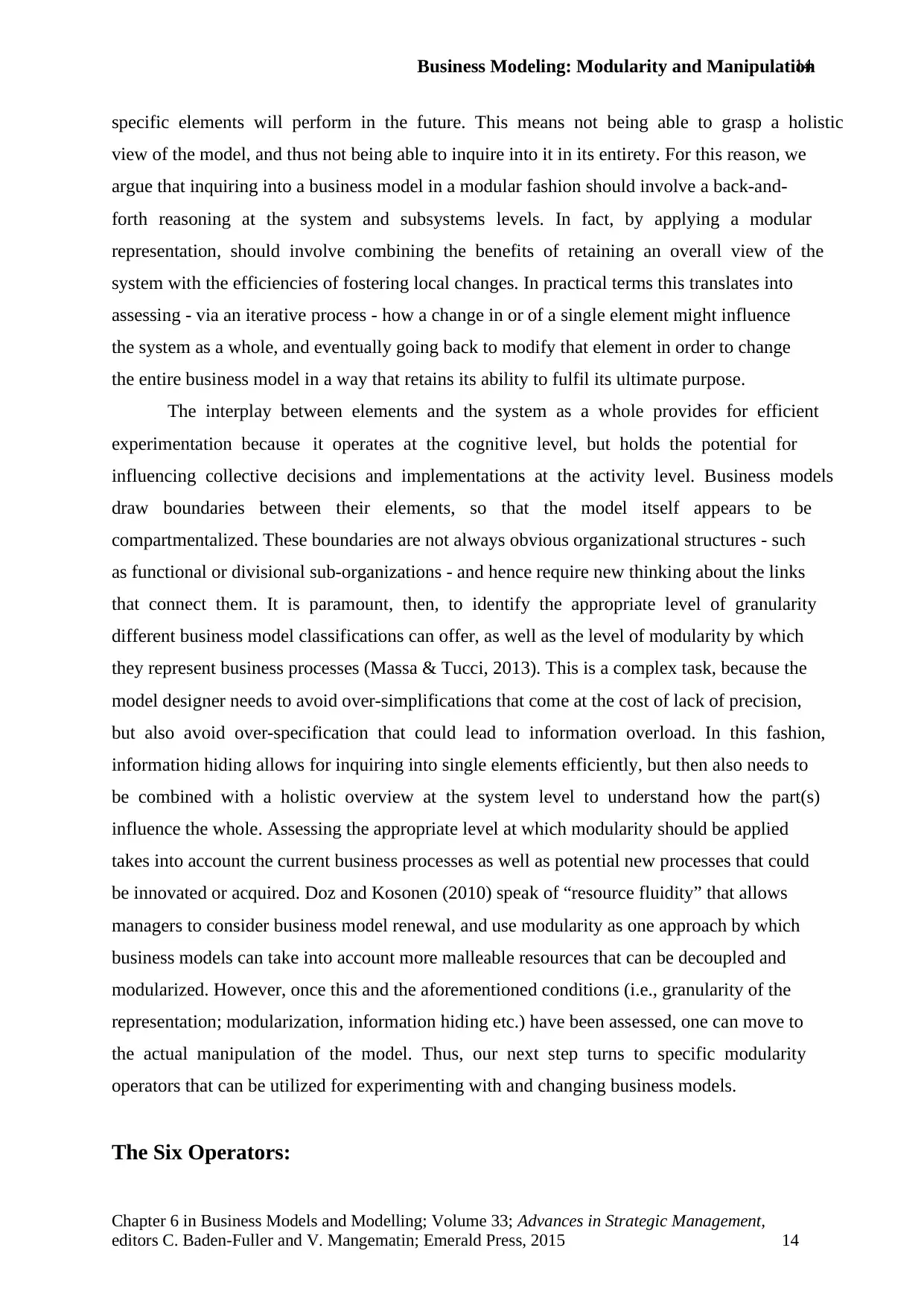
Business Modeling: Modularity and Manipulation
Chapter 6 in Business Models and Modelling; Volume 33; Advances in Strategic Management,
editors C. Baden-Fuller and V. Mangematin; Emerald Press, 2015 14
14
specific elements will perform in the future. This means not being able to grasp a holistic
view of the model, and thus not being able to inquire into it in its entirety. For this reason, we
argue that inquiring into a business model in a modular fashion should involve a back-and-
forth reasoning at the system and subsystems levels. In fact, by applying a modular
representation, should involve combining the benefits of retaining an overall view of the
system with the efficiencies of fostering local changes. In practical terms this translates into
assessing - via an iterative process - how a change in or of a single element might influence
the system as a whole, and eventually going back to modify that element in order to change
the entire business model in a way that retains its ability to fulfil its ultimate purpose.
The interplay between elements and the system as a whole provides for efficient
experimentation because it operates at the cognitive level, but holds the potential for
influencing collective decisions and implementations at the activity level. Business models
draw boundaries between their elements, so that the model itself appears to be
compartmentalized. These boundaries are not always obvious organizational structures - such
as functional or divisional sub-organizations - and hence require new thinking about the links
that connect them. It is paramount, then, to identify the appropriate level of granularity
different business model classifications can offer, as well as the level of modularity by which
they represent business processes (Massa & Tucci, 2013). This is a complex task, because the
model designer needs to avoid over-simplifications that come at the cost of lack of precision,
but also avoid over-specification that could lead to information overload. In this fashion,
information hiding allows for inquiring into single elements efficiently, but then also needs to
be combined with a holistic overview at the system level to understand how the part(s)
influence the whole. Assessing the appropriate level at which modularity should be applied
takes into account the current business processes as well as potential new processes that could
be innovated or acquired. Doz and Kosonen (2010) speak of “resource fluidity” that allows
managers to consider business model renewal, and use modularity as one approach by which
business models can take into account more malleable resources that can be decoupled and
modularized. However, once this and the aforementioned conditions (i.e., granularity of the
representation; modularization, information hiding etc.) have been assessed, one can move to
the actual manipulation of the model. Thus, our next step turns to specific modularity
operators that can be utilized for experimenting with and changing business models.
The Six Operators:
Chapter 6 in Business Models and Modelling; Volume 33; Advances in Strategic Management,
editors C. Baden-Fuller and V. Mangematin; Emerald Press, 2015 14
14
specific elements will perform in the future. This means not being able to grasp a holistic
view of the model, and thus not being able to inquire into it in its entirety. For this reason, we
argue that inquiring into a business model in a modular fashion should involve a back-and-
forth reasoning at the system and subsystems levels. In fact, by applying a modular
representation, should involve combining the benefits of retaining an overall view of the
system with the efficiencies of fostering local changes. In practical terms this translates into
assessing - via an iterative process - how a change in or of a single element might influence
the system as a whole, and eventually going back to modify that element in order to change
the entire business model in a way that retains its ability to fulfil its ultimate purpose.
The interplay between elements and the system as a whole provides for efficient
experimentation because it operates at the cognitive level, but holds the potential for
influencing collective decisions and implementations at the activity level. Business models
draw boundaries between their elements, so that the model itself appears to be
compartmentalized. These boundaries are not always obvious organizational structures - such
as functional or divisional sub-organizations - and hence require new thinking about the links
that connect them. It is paramount, then, to identify the appropriate level of granularity
different business model classifications can offer, as well as the level of modularity by which
they represent business processes (Massa & Tucci, 2013). This is a complex task, because the
model designer needs to avoid over-simplifications that come at the cost of lack of precision,
but also avoid over-specification that could lead to information overload. In this fashion,
information hiding allows for inquiring into single elements efficiently, but then also needs to
be combined with a holistic overview at the system level to understand how the part(s)
influence the whole. Assessing the appropriate level at which modularity should be applied
takes into account the current business processes as well as potential new processes that could
be innovated or acquired. Doz and Kosonen (2010) speak of “resource fluidity” that allows
managers to consider business model renewal, and use modularity as one approach by which
business models can take into account more malleable resources that can be decoupled and
modularized. However, once this and the aforementioned conditions (i.e., granularity of the
representation; modularization, information hiding etc.) have been assessed, one can move to
the actual manipulation of the model. Thus, our next step turns to specific modularity
operators that can be utilized for experimenting with and changing business models.
The Six Operators:
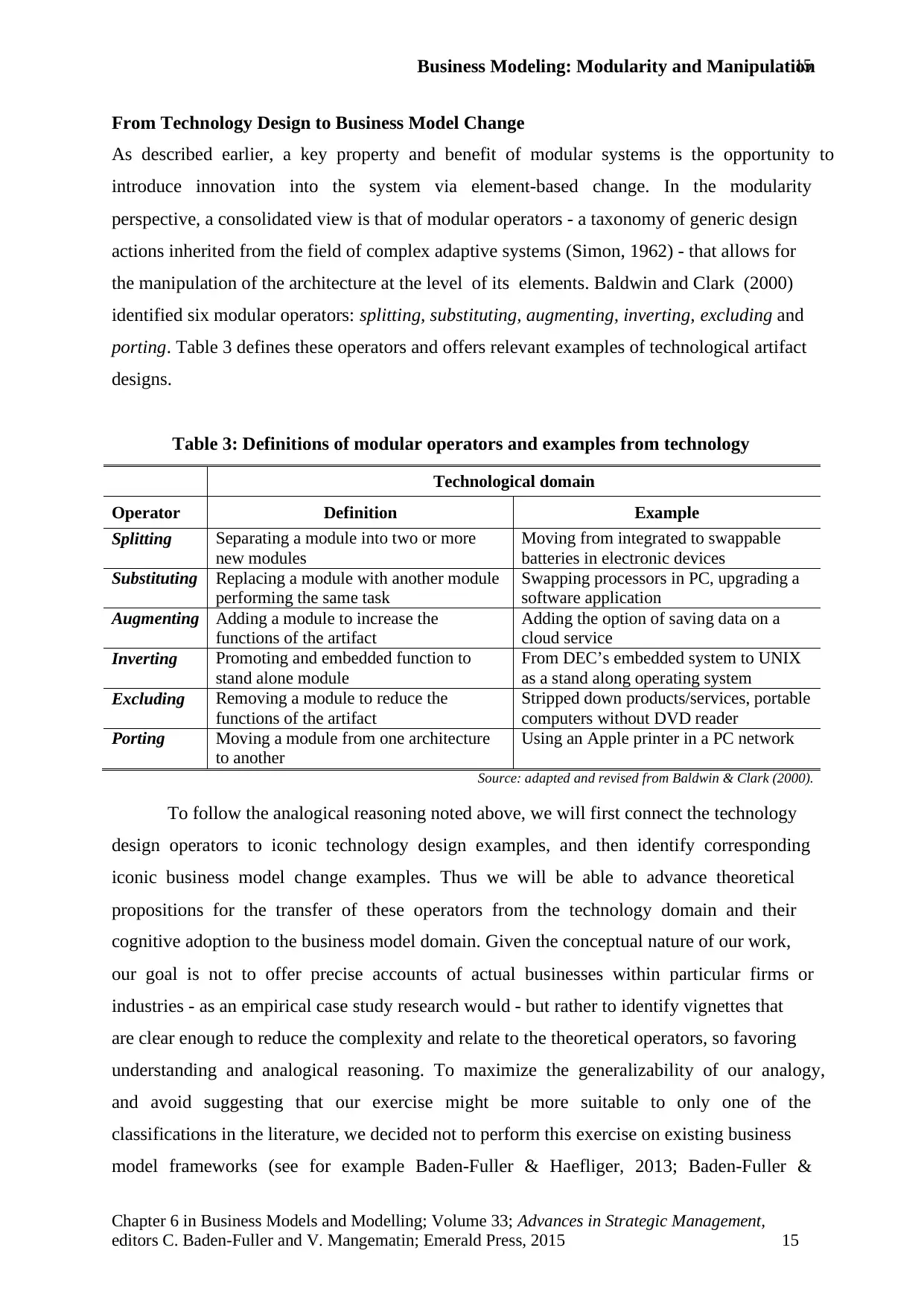
Business Modeling: Modularity and Manipulation
Chapter 6 in Business Models and Modelling; Volume 33; Advances in Strategic Management,
editors C. Baden-Fuller and V. Mangematin; Emerald Press, 2015 15
15
From Technology Design to Business Model Change
As described earlier, a key property and benefit of modular systems is the opportunity to
introduce innovation into the system via element-based change. In the modularity
perspective, a consolidated view is that of modular operators - a taxonomy of generic design
actions inherited from the field of complex adaptive systems (Simon, 1962) - that allows for
the manipulation of the architecture at the level of its elements. Baldwin and Clark (2000)
identified six modular operators: splitting, substituting, augmenting, inverting, excluding and
porting. Table 3 defines these operators and offers relevant examples of technological artifact
designs.
Table 3: Definitions of modular operators and examples from technology
Technological domain
Operator Definition Example
Splitting Separating a module into two or more
new modules
Moving from integrated to swappable
batteries in electronic devices
Substituting Replacing a module with another module
performing the same task
Swapping processors in PC, upgrading a
software application
Augmenting Adding a module to increase the
functions of the artifact
Adding the option of saving data on a
cloud service
Inverting Promoting and embedded function to
stand alone module
From DEC’s embedded system to UNIX
as a stand along operating system
Excluding Removing a module to reduce the
functions of the artifact
Stripped down products/services, portable
computers without DVD reader
Porting Moving a module from one architecture
to another
Using an Apple printer in a PC network
Source: adapted and revised from Baldwin & Clark (2000).
To follow the analogical reasoning noted above, we will first connect the technology
design operators to iconic technology design examples, and then identify corresponding
iconic business model change examples. Thus we will be able to advance theoretical
propositions for the transfer of these operators from the technology domain and their
cognitive adoption to the business model domain. Given the conceptual nature of our work,
our goal is not to offer precise accounts of actual businesses within particular firms or
industries - as an empirical case study research would - but rather to identify vignettes that
are clear enough to reduce the complexity and relate to the theoretical operators, so favoring
understanding and analogical reasoning. To maximize the generalizability of our analogy,
and avoid suggesting that our exercise might be more suitable to only one of the
classifications in the literature, we decided not to perform this exercise on existing business
model frameworks (see for example Baden-Fuller & Haefliger, 2013; Baden-Fuller &
Chapter 6 in Business Models and Modelling; Volume 33; Advances in Strategic Management,
editors C. Baden-Fuller and V. Mangematin; Emerald Press, 2015 15
15
From Technology Design to Business Model Change
As described earlier, a key property and benefit of modular systems is the opportunity to
introduce innovation into the system via element-based change. In the modularity
perspective, a consolidated view is that of modular operators - a taxonomy of generic design
actions inherited from the field of complex adaptive systems (Simon, 1962) - that allows for
the manipulation of the architecture at the level of its elements. Baldwin and Clark (2000)
identified six modular operators: splitting, substituting, augmenting, inverting, excluding and
porting. Table 3 defines these operators and offers relevant examples of technological artifact
designs.
Table 3: Definitions of modular operators and examples from technology
Technological domain
Operator Definition Example
Splitting Separating a module into two or more
new modules
Moving from integrated to swappable
batteries in electronic devices
Substituting Replacing a module with another module
performing the same task
Swapping processors in PC, upgrading a
software application
Augmenting Adding a module to increase the
functions of the artifact
Adding the option of saving data on a
cloud service
Inverting Promoting and embedded function to
stand alone module
From DEC’s embedded system to UNIX
as a stand along operating system
Excluding Removing a module to reduce the
functions of the artifact
Stripped down products/services, portable
computers without DVD reader
Porting Moving a module from one architecture
to another
Using an Apple printer in a PC network
Source: adapted and revised from Baldwin & Clark (2000).
To follow the analogical reasoning noted above, we will first connect the technology
design operators to iconic technology design examples, and then identify corresponding
iconic business model change examples. Thus we will be able to advance theoretical
propositions for the transfer of these operators from the technology domain and their
cognitive adoption to the business model domain. Given the conceptual nature of our work,
our goal is not to offer precise accounts of actual businesses within particular firms or
industries - as an empirical case study research would - but rather to identify vignettes that
are clear enough to reduce the complexity and relate to the theoretical operators, so favoring
understanding and analogical reasoning. To maximize the generalizability of our analogy,
and avoid suggesting that our exercise might be more suitable to only one of the
classifications in the literature, we decided not to perform this exercise on existing business
model frameworks (see for example Baden-Fuller & Haefliger, 2013; Baden-Fuller &
Secure Best Marks with AI Grader
Need help grading? Try our AI Grader for instant feedback on your assignments.
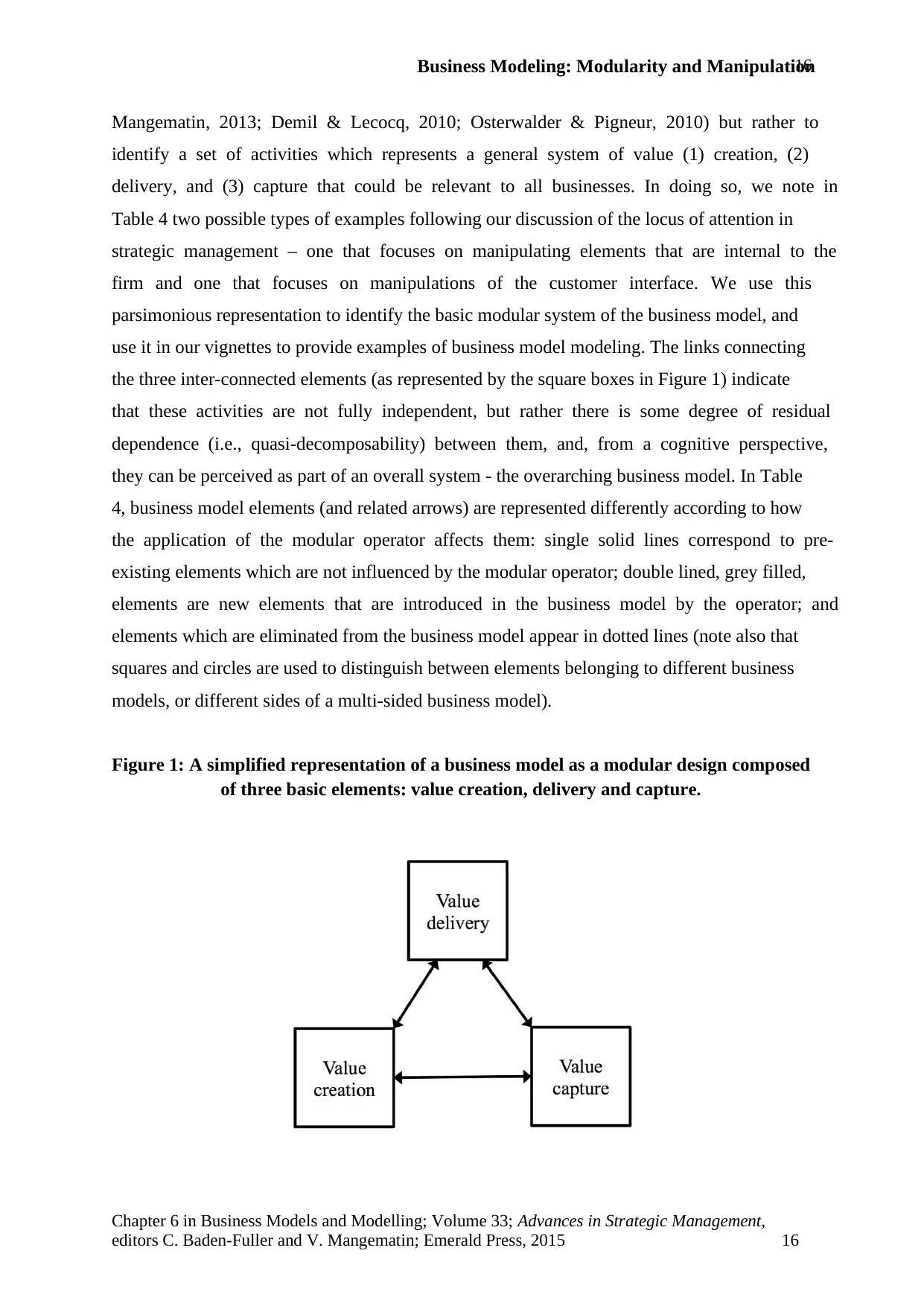
Business Modeling: Modularity and Manipulation
Chapter 6 in Business Models and Modelling; Volume 33; Advances in Strategic Management,
editors C. Baden-Fuller and V. Mangematin; Emerald Press, 2015 16
16
Mangematin, 2013; Demil & Lecocq, 2010; Osterwalder & Pigneur, 2010) but rather to
identify a set of activities which represents a general system of value (1) creation, (2)
delivery, and (3) capture that could be relevant to all businesses. In doing so, we note in
Table 4 two possible types of examples following our discussion of the locus of attention in
strategic management – one that focuses on manipulating elements that are internal to the
firm and one that focuses on manipulations of the customer interface. We use this
parsimonious representation to identify the basic modular system of the business model, and
use it in our vignettes to provide examples of business model modeling. The links connecting
the three inter-connected elements (as represented by the square boxes in Figure 1) indicate
that these activities are not fully independent, but rather there is some degree of residual
dependence (i.e., quasi-decomposability) between them, and, from a cognitive perspective,
they can be perceived as part of an overall system - the overarching business model. In Table
4, business model elements (and related arrows) are represented differently according to how
the application of the modular operator affects them: single solid lines correspond to pre-
existing elements which are not influenced by the modular operator; double lined, grey filled,
elements are new elements that are introduced in the business model by the operator; and
elements which are eliminated from the business model appear in dotted lines (note also that
squares and circles are used to distinguish between elements belonging to different business
models, or different sides of a multi-sided business model).
Figure 1: A simplified representation of a business model as a modular design composed
of three basic elements: value creation, delivery and capture.
Chapter 6 in Business Models and Modelling; Volume 33; Advances in Strategic Management,
editors C. Baden-Fuller and V. Mangematin; Emerald Press, 2015 16
16
Mangematin, 2013; Demil & Lecocq, 2010; Osterwalder & Pigneur, 2010) but rather to
identify a set of activities which represents a general system of value (1) creation, (2)
delivery, and (3) capture that could be relevant to all businesses. In doing so, we note in
Table 4 two possible types of examples following our discussion of the locus of attention in
strategic management – one that focuses on manipulating elements that are internal to the
firm and one that focuses on manipulations of the customer interface. We use this
parsimonious representation to identify the basic modular system of the business model, and
use it in our vignettes to provide examples of business model modeling. The links connecting
the three inter-connected elements (as represented by the square boxes in Figure 1) indicate
that these activities are not fully independent, but rather there is some degree of residual
dependence (i.e., quasi-decomposability) between them, and, from a cognitive perspective,
they can be perceived as part of an overall system - the overarching business model. In Table
4, business model elements (and related arrows) are represented differently according to how
the application of the modular operator affects them: single solid lines correspond to pre-
existing elements which are not influenced by the modular operator; double lined, grey filled,
elements are new elements that are introduced in the business model by the operator; and
elements which are eliminated from the business model appear in dotted lines (note also that
squares and circles are used to distinguish between elements belonging to different business
models, or different sides of a multi-sided business model).
Figure 1: A simplified representation of a business model as a modular design composed
of three basic elements: value creation, delivery and capture.
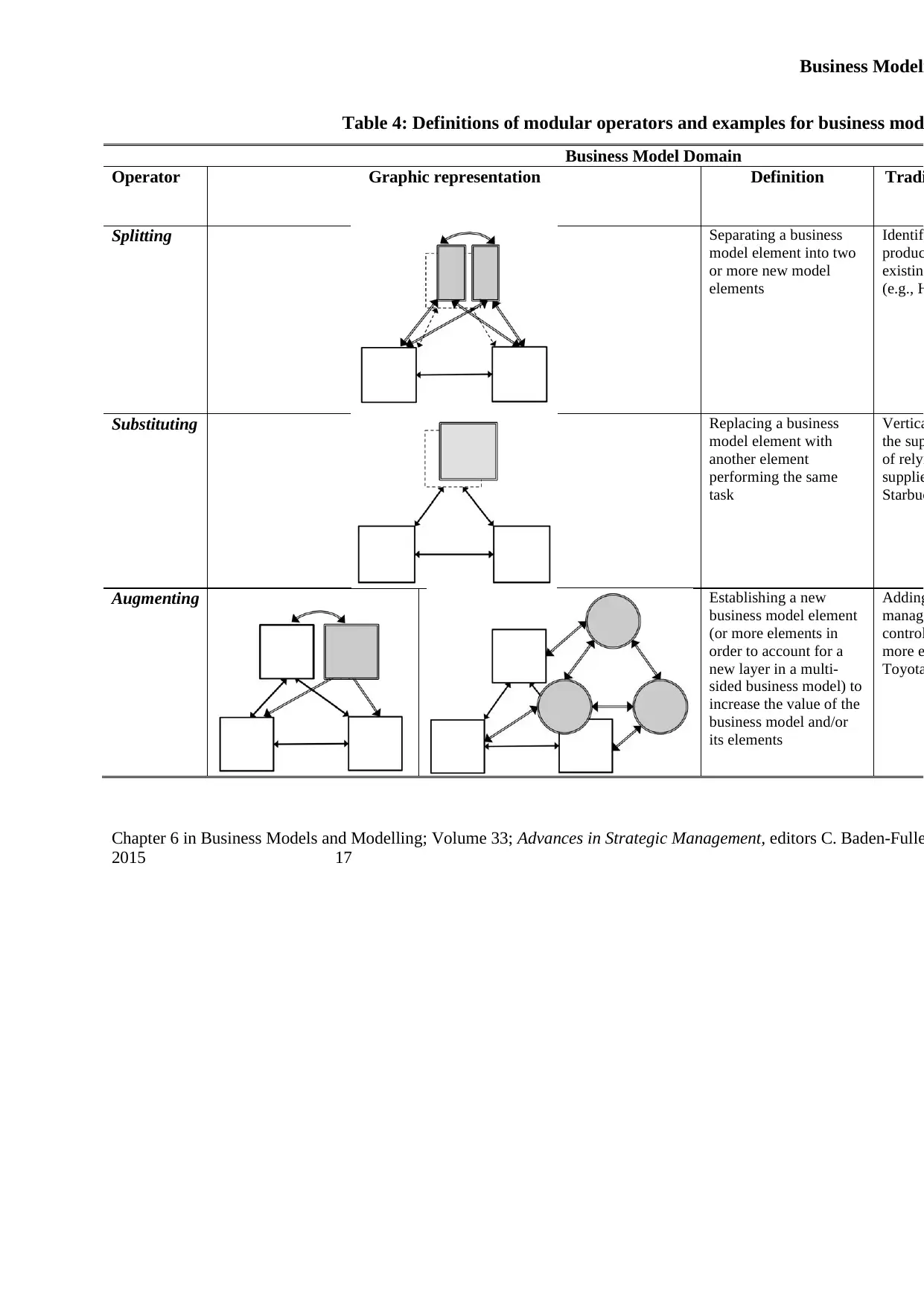
Business Modeli
Chapter 6 in Business Models and Modelling; Volume 33; Advances in Strategic Management, editors C. Baden-Fulle
2015 17
Table 4: Definitions of modular operators and examples for business mod
Business Model Domain
Operator Graphic representation Definition Tradi
Splitting Separating a business
model element into two
or more new model
elements
Identif
produc
existin
(e.g., H
Substituting Replacing a business
model element with
another element
performing the same
task
Vertica
the sup
of relyi
supplie
Starbuc
Augmenting Establishing a new
business model element
(or more elements in
order to account for a
new layer in a multi-
sided business model) to
increase the value of the
business model and/or
its elements
Adding
manag
control
more e
Toyota
Chapter 6 in Business Models and Modelling; Volume 33; Advances in Strategic Management, editors C. Baden-Fulle
2015 17
Table 4: Definitions of modular operators and examples for business mod
Business Model Domain
Operator Graphic representation Definition Tradi
Splitting Separating a business
model element into two
or more new model
elements
Identif
produc
existin
(e.g., H
Substituting Replacing a business
model element with
another element
performing the same
task
Vertica
the sup
of relyi
supplie
Starbuc
Augmenting Establishing a new
business model element
(or more elements in
order to account for a
new layer in a multi-
sided business model) to
increase the value of the
business model and/or
its elements
Adding
manag
control
more e
Toyota
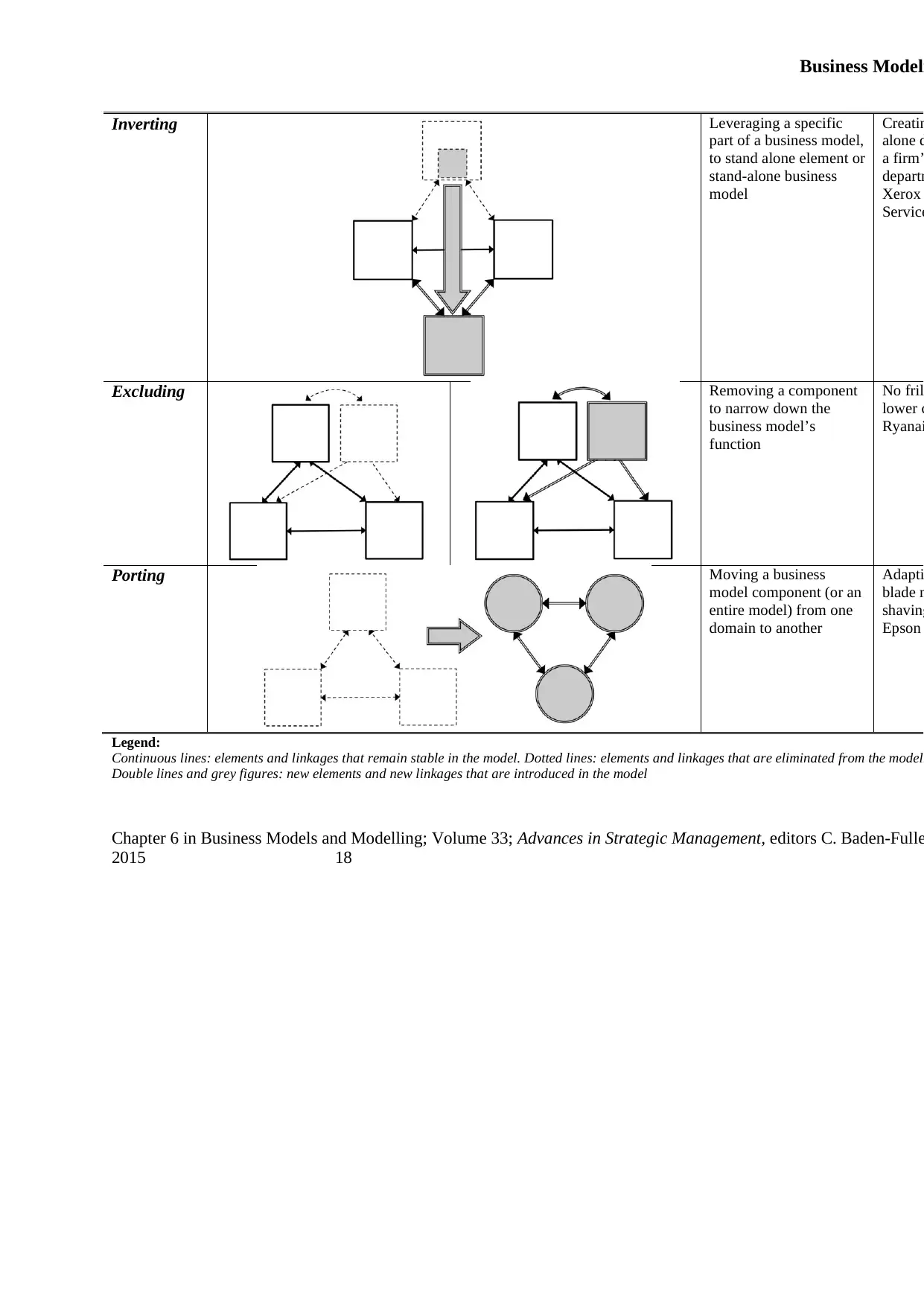
Business Modeli
Chapter 6 in Business Models and Modelling; Volume 33; Advances in Strategic Management, editors C. Baden-Fulle
2015 18
Inverting Leveraging a specific
part of a business model,
to stand alone element or
stand-alone business
model
Creatin
alone d
a firm’
departm
Xerox
Service
Excluding Removing a component
to narrow down the
business model’s
function
No fril
lower c
Ryanai
Porting Moving a business
model component (or an
entire model) from one
domain to another
Adapti
blade m
shaving
Epson
Legend:
Continuous lines: elements and linkages that remain stable in the model. Dotted lines: elements and linkages that are eliminated from the model.
Double lines and grey figures: new elements and new linkages that are introduced in the model
Chapter 6 in Business Models and Modelling; Volume 33; Advances in Strategic Management, editors C. Baden-Fulle
2015 18
Inverting Leveraging a specific
part of a business model,
to stand alone element or
stand-alone business
model
Creatin
alone d
a firm’
departm
Xerox
Service
Excluding Removing a component
to narrow down the
business model’s
function
No fril
lower c
Ryanai
Porting Moving a business
model component (or an
entire model) from one
domain to another
Adapti
blade m
shaving
Epson
Legend:
Continuous lines: elements and linkages that remain stable in the model. Dotted lines: elements and linkages that are eliminated from the model.
Double lines and grey figures: new elements and new linkages that are introduced in the model
Paraphrase This Document
Need a fresh take? Get an instant paraphrase of this document with our AI Paraphraser
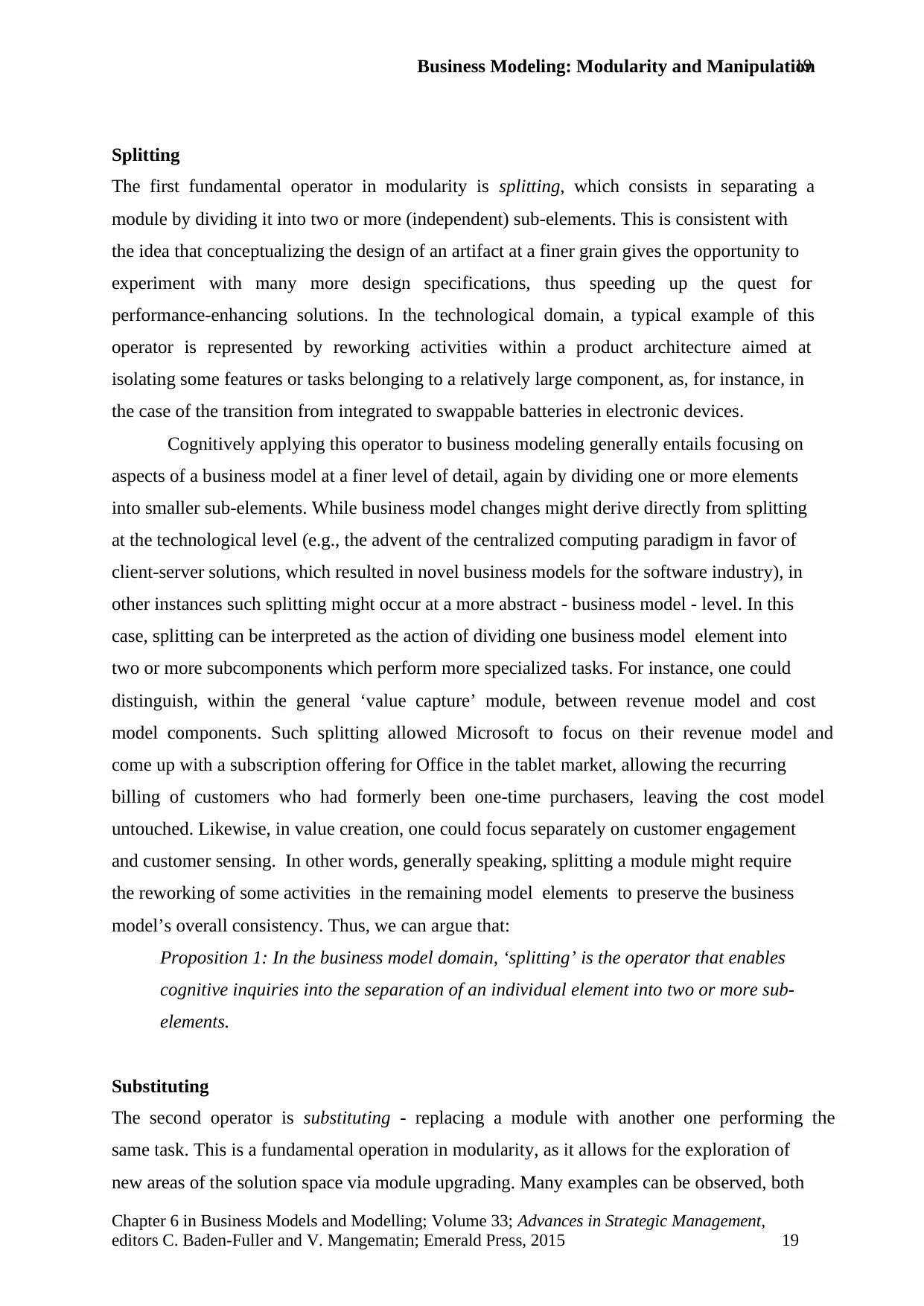
Business Modeling: Modularity and Manipulation
Chapter 6 in Business Models and Modelling; Volume 33; Advances in Strategic Management,
editors C. Baden-Fuller and V. Mangematin; Emerald Press, 2015 19
19
Splitting
The first fundamental operator in modularity is splitting, which consists in separating a
module by dividing it into two or more (independent) sub-elements. This is consistent with
the idea that conceptualizing the design of an artifact at a finer grain gives the opportunity to
experiment with many more design specifications, thus speeding up the quest for
performance-enhancing solutions. In the technological domain, a typical example of this
operator is represented by reworking activities within a product architecture aimed at
isolating some features or tasks belonging to a relatively large component, as, for instance, in
the case of the transition from integrated to swappable batteries in electronic devices.
Cognitively applying this operator to business modeling generally entails focusing on
aspects of a business model at a finer level of detail, again by dividing one or more elements
into smaller sub-elements. While business model changes might derive directly from splitting
at the technological level (e.g., the advent of the centralized computing paradigm in favor of
client-server solutions, which resulted in novel business models for the software industry), in
other instances such splitting might occur at a more abstract - business model - level. In this
case, splitting can be interpreted as the action of dividing one business model element into
two or more subcomponents which perform more specialized tasks. For instance, one could
distinguish, within the general ‘value capture’ module, between revenue model and cost
model components. Such splitting allowed Microsoft to focus on their revenue model and
come up with a subscription offering for Office in the tablet market, allowing the recurring
billing of customers who had formerly been one-time purchasers, leaving the cost model
untouched. Likewise, in value creation, one could focus separately on customer engagement
and customer sensing. In other words, generally speaking, splitting a module might require
the reworking of some activities in the remaining model elements to preserve the business
model’s overall consistency. Thus, we can argue that:
Proposition 1: In the business model domain, ‘splitting’ is the operator that enables
cognitive inquiries into the separation of an individual element into two or more sub-
elements.
Substituting
The second operator is substituting - replacing a module with another one performing the
same task. This is a fundamental operation in modularity, as it allows for the exploration of
new areas of the solution space via module upgrading. Many examples can be observed, both
Chapter 6 in Business Models and Modelling; Volume 33; Advances in Strategic Management,
editors C. Baden-Fuller and V. Mangematin; Emerald Press, 2015 19
19
Splitting
The first fundamental operator in modularity is splitting, which consists in separating a
module by dividing it into two or more (independent) sub-elements. This is consistent with
the idea that conceptualizing the design of an artifact at a finer grain gives the opportunity to
experiment with many more design specifications, thus speeding up the quest for
performance-enhancing solutions. In the technological domain, a typical example of this
operator is represented by reworking activities within a product architecture aimed at
isolating some features or tasks belonging to a relatively large component, as, for instance, in
the case of the transition from integrated to swappable batteries in electronic devices.
Cognitively applying this operator to business modeling generally entails focusing on
aspects of a business model at a finer level of detail, again by dividing one or more elements
into smaller sub-elements. While business model changes might derive directly from splitting
at the technological level (e.g., the advent of the centralized computing paradigm in favor of
client-server solutions, which resulted in novel business models for the software industry), in
other instances such splitting might occur at a more abstract - business model - level. In this
case, splitting can be interpreted as the action of dividing one business model element into
two or more subcomponents which perform more specialized tasks. For instance, one could
distinguish, within the general ‘value capture’ module, between revenue model and cost
model components. Such splitting allowed Microsoft to focus on their revenue model and
come up with a subscription offering for Office in the tablet market, allowing the recurring
billing of customers who had formerly been one-time purchasers, leaving the cost model
untouched. Likewise, in value creation, one could focus separately on customer engagement
and customer sensing. In other words, generally speaking, splitting a module might require
the reworking of some activities in the remaining model elements to preserve the business
model’s overall consistency. Thus, we can argue that:
Proposition 1: In the business model domain, ‘splitting’ is the operator that enables
cognitive inquiries into the separation of an individual element into two or more sub-
elements.
Substituting
The second operator is substituting - replacing a module with another one performing the
same task. This is a fundamental operation in modularity, as it allows for the exploration of
new areas of the solution space via module upgrading. Many examples can be observed, both

Business Modeling: Modularity and Manipulation
Chapter 6 in Business Models and Modelling; Volume 33; Advances in Strategic Management,
editors C. Baden-Fuller and V. Mangematin; Emerald Press, 2015 20
20
in terms of producers experimenting with their technology product architectures, such as
swapping a type of processor or software in a personal computer as a way of introducing
variety and higher performance in a product line, or improving a mobile phone’s wi-fi
connectivity by substituting a GPRS-based data service with a component that can support
faster connectivity (e.g., 2G, 3G, 4G, etc.).
In general terms, a business model undergoes an element substitution process every
time one or more value creation, delivery or capture elements are replaced by another which,
despite being internally arranged with a different set of activities, performs the same task in
the business model architecture. Scholars or managers may use such archetypal ‘swapping’
operations to evaluate the effectiveness of incremental business model innovation (e.g.,
‘Leaving everything else untouched, what if we change this?’). This can take the form of
high-level abstraction - e.g., at the value creation level: (‘Could we engage the customer
through a taxi, rather than a bus, mode?’) - or a more practical evaluation of alternative ways
to implement activities pertaining to a specific business model element (e.g., substituting the
standard ‘paid’ mode by introducing ‘free-to-play’ or ‘freemium’ modes in an app’s value
capture mechanism). However, this type of change might force managers to reconsider their
product types, as free-to play games (e.g., Angry Birds) might need to be designed to fit with
the requirements of in-game advertisers. To be effective, substitution needs to also consider
the overall business model and re-design some of its elements within the interplay between
the system and its elements. Consider crowdsourcing as the poster child of substituting, e.g.,
Amazon’s Mechanical Turk micro-task platform or Eli Lilly’s InnoCentive marketplace for
innovative ideas. In both these cases, the business model innovation lies in conceptualizing
alternative ways to organize and execute production or design/ideation tasks by engaging
large external crowds of contributors in the firm’s business operations. So we can posit that:
Proposition 2: In the business model domain, ‘substituting’ is an operator that allows
cognitive inquiries into replacing one original business model element with a different
one that performs the same task but in a different way.
Augmenting
The third modular operator is augmenting, which can be defined as the action of adding a
module to the existing architecture in order to increase the number of tasks or functions the
artifact can perform. A classic example of augmenting in the technology design domain is
represented by adding a cloud-storing data service to a digital device, or including a camera
or a GPS system into a mobile phone’s architecture.
Chapter 6 in Business Models and Modelling; Volume 33; Advances in Strategic Management,
editors C. Baden-Fuller and V. Mangematin; Emerald Press, 2015 20
20
in terms of producers experimenting with their technology product architectures, such as
swapping a type of processor or software in a personal computer as a way of introducing
variety and higher performance in a product line, or improving a mobile phone’s wi-fi
connectivity by substituting a GPRS-based data service with a component that can support
faster connectivity (e.g., 2G, 3G, 4G, etc.).
In general terms, a business model undergoes an element substitution process every
time one or more value creation, delivery or capture elements are replaced by another which,
despite being internally arranged with a different set of activities, performs the same task in
the business model architecture. Scholars or managers may use such archetypal ‘swapping’
operations to evaluate the effectiveness of incremental business model innovation (e.g.,
‘Leaving everything else untouched, what if we change this?’). This can take the form of
high-level abstraction - e.g., at the value creation level: (‘Could we engage the customer
through a taxi, rather than a bus, mode?’) - or a more practical evaluation of alternative ways
to implement activities pertaining to a specific business model element (e.g., substituting the
standard ‘paid’ mode by introducing ‘free-to-play’ or ‘freemium’ modes in an app’s value
capture mechanism). However, this type of change might force managers to reconsider their
product types, as free-to play games (e.g., Angry Birds) might need to be designed to fit with
the requirements of in-game advertisers. To be effective, substitution needs to also consider
the overall business model and re-design some of its elements within the interplay between
the system and its elements. Consider crowdsourcing as the poster child of substituting, e.g.,
Amazon’s Mechanical Turk micro-task platform or Eli Lilly’s InnoCentive marketplace for
innovative ideas. In both these cases, the business model innovation lies in conceptualizing
alternative ways to organize and execute production or design/ideation tasks by engaging
large external crowds of contributors in the firm’s business operations. So we can posit that:
Proposition 2: In the business model domain, ‘substituting’ is an operator that allows
cognitive inquiries into replacing one original business model element with a different
one that performs the same task but in a different way.
Augmenting
The third modular operator is augmenting, which can be defined as the action of adding a
module to the existing architecture in order to increase the number of tasks or functions the
artifact can perform. A classic example of augmenting in the technology design domain is
represented by adding a cloud-storing data service to a digital device, or including a camera
or a GPS system into a mobile phone’s architecture.
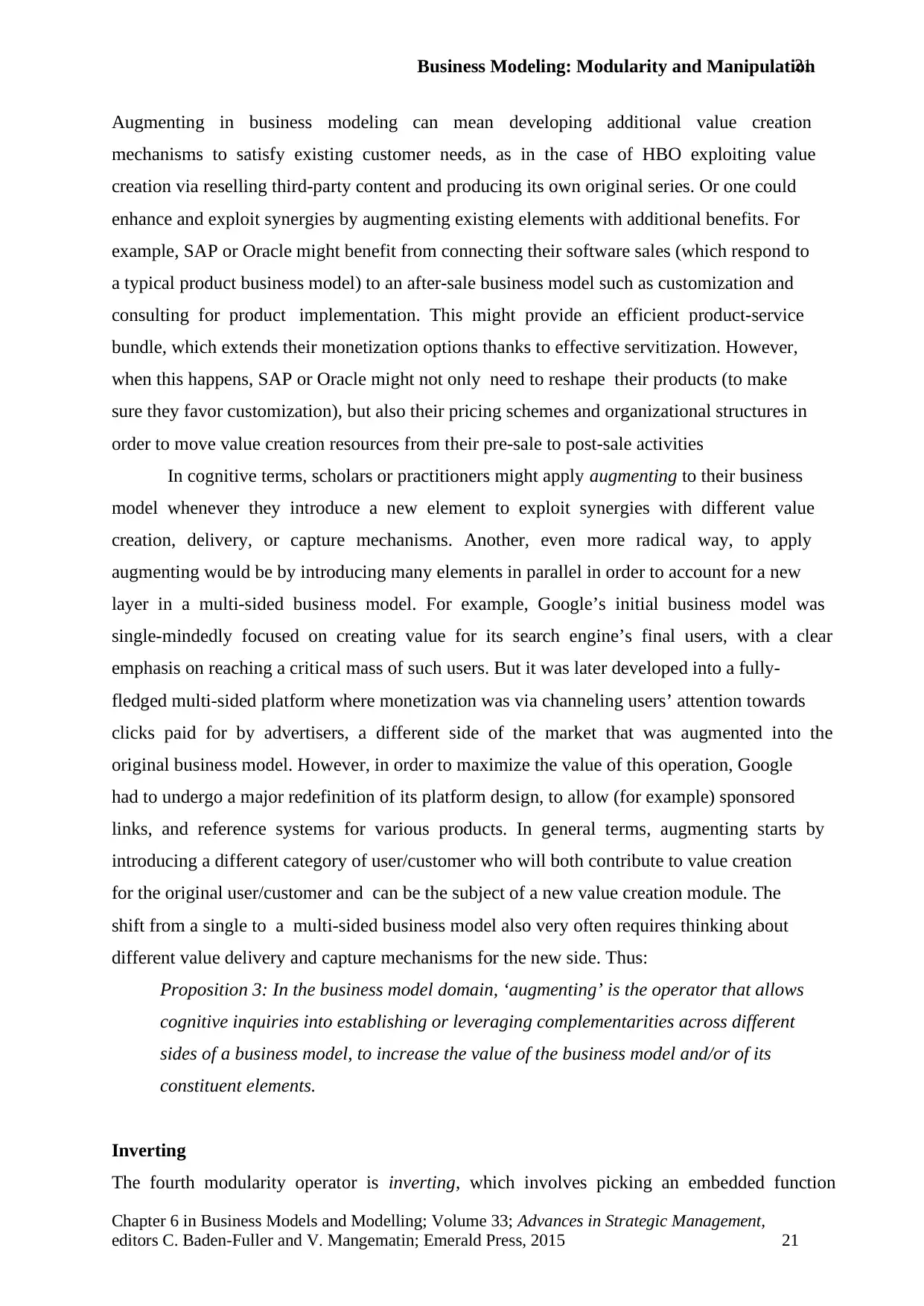
Business Modeling: Modularity and Manipulation
Chapter 6 in Business Models and Modelling; Volume 33; Advances in Strategic Management,
editors C. Baden-Fuller and V. Mangematin; Emerald Press, 2015 21
21
Augmenting in business modeling can mean developing additional value creation
mechanisms to satisfy existing customer needs, as in the case of HBO exploiting value
creation via reselling third-party content and producing its own original series. Or one could
enhance and exploit synergies by augmenting existing elements with additional benefits. For
example, SAP or Oracle might benefit from connecting their software sales (which respond to
a typical product business model) to an after-sale business model such as customization and
consulting for product implementation. This might provide an efficient product-service
bundle, which extends their monetization options thanks to effective servitization. However,
when this happens, SAP or Oracle might not only need to reshape their products (to make
sure they favor customization), but also their pricing schemes and organizational structures in
order to move value creation resources from their pre-sale to post-sale activities
In cognitive terms, scholars or practitioners might apply augmenting to their business
model whenever they introduce a new element to exploit synergies with different value
creation, delivery, or capture mechanisms. Another, even more radical way, to apply
augmenting would be by introducing many elements in parallel in order to account for a new
layer in a multi-sided business model. For example, Google’s initial business model was
single-mindedly focused on creating value for its search engine’s final users, with a clear
emphasis on reaching a critical mass of such users. But it was later developed into a fully-
fledged multi-sided platform where monetization was via channeling users’ attention towards
clicks paid for by advertisers, a different side of the market that was augmented into the
original business model. However, in order to maximize the value of this operation, Google
had to undergo a major redefinition of its platform design, to allow (for example) sponsored
links, and reference systems for various products. In general terms, augmenting starts by
introducing a different category of user/customer who will both contribute to value creation
for the original user/customer and can be the subject of a new value creation module. The
shift from a single to a multi-sided business model also very often requires thinking about
different value delivery and capture mechanisms for the new side. Thus:
Proposition 3: In the business model domain, ‘augmenting’ is the operator that allows
cognitive inquiries into establishing or leveraging complementarities across different
sides of a business model, to increase the value of the business model and/or of its
constituent elements.
Inverting
The fourth modularity operator is inverting, which involves picking an embedded function
Chapter 6 in Business Models and Modelling; Volume 33; Advances in Strategic Management,
editors C. Baden-Fuller and V. Mangematin; Emerald Press, 2015 21
21
Augmenting in business modeling can mean developing additional value creation
mechanisms to satisfy existing customer needs, as in the case of HBO exploiting value
creation via reselling third-party content and producing its own original series. Or one could
enhance and exploit synergies by augmenting existing elements with additional benefits. For
example, SAP or Oracle might benefit from connecting their software sales (which respond to
a typical product business model) to an after-sale business model such as customization and
consulting for product implementation. This might provide an efficient product-service
bundle, which extends their monetization options thanks to effective servitization. However,
when this happens, SAP or Oracle might not only need to reshape their products (to make
sure they favor customization), but also their pricing schemes and organizational structures in
order to move value creation resources from their pre-sale to post-sale activities
In cognitive terms, scholars or practitioners might apply augmenting to their business
model whenever they introduce a new element to exploit synergies with different value
creation, delivery, or capture mechanisms. Another, even more radical way, to apply
augmenting would be by introducing many elements in parallel in order to account for a new
layer in a multi-sided business model. For example, Google’s initial business model was
single-mindedly focused on creating value for its search engine’s final users, with a clear
emphasis on reaching a critical mass of such users. But it was later developed into a fully-
fledged multi-sided platform where monetization was via channeling users’ attention towards
clicks paid for by advertisers, a different side of the market that was augmented into the
original business model. However, in order to maximize the value of this operation, Google
had to undergo a major redefinition of its platform design, to allow (for example) sponsored
links, and reference systems for various products. In general terms, augmenting starts by
introducing a different category of user/customer who will both contribute to value creation
for the original user/customer and can be the subject of a new value creation module. The
shift from a single to a multi-sided business model also very often requires thinking about
different value delivery and capture mechanisms for the new side. Thus:
Proposition 3: In the business model domain, ‘augmenting’ is the operator that allows
cognitive inquiries into establishing or leveraging complementarities across different
sides of a business model, to increase the value of the business model and/or of its
constituent elements.
Inverting
The fourth modularity operator is inverting, which involves picking an embedded function
Secure Best Marks with AI Grader
Need help grading? Try our AI Grader for instant feedback on your assignments.
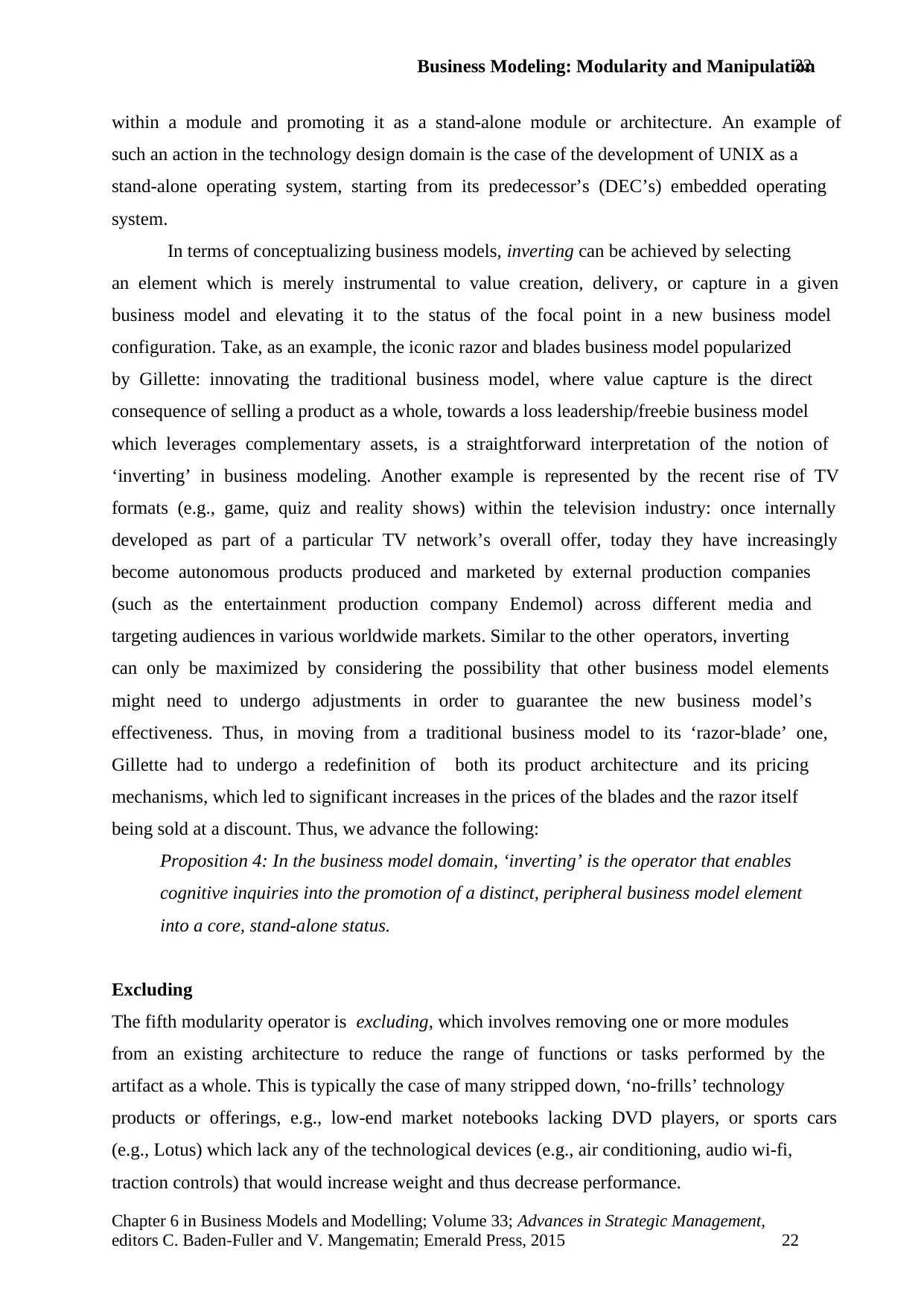
Business Modeling: Modularity and Manipulation
Chapter 6 in Business Models and Modelling; Volume 33; Advances in Strategic Management,
editors C. Baden-Fuller and V. Mangematin; Emerald Press, 2015 22
22
within a module and promoting it as a stand-alone module or architecture. An example of
such an action in the technology design domain is the case of the development of UNIX as a
stand-alone operating system, starting from its predecessor’s (DEC’s) embedded operating
system.
In terms of conceptualizing business models, inverting can be achieved by selecting
an element which is merely instrumental to value creation, delivery, or capture in a given
business model and elevating it to the status of the focal point in a new business model
configuration. Take, as an example, the iconic razor and blades business model popularized
by Gillette: innovating the traditional business model, where value capture is the direct
consequence of selling a product as a whole, towards a loss leadership/freebie business model
which leverages complementary assets, is a straightforward interpretation of the notion of
‘inverting’ in business modeling. Another example is represented by the recent rise of TV
formats (e.g., game, quiz and reality shows) within the television industry: once internally
developed as part of a particular TV network’s overall offer, today they have increasingly
become autonomous products produced and marketed by external production companies
(such as the entertainment production company Endemol) across different media and
targeting audiences in various worldwide markets. Similar to the other operators, inverting
can only be maximized by considering the possibility that other business model elements
might need to undergo adjustments in order to guarantee the new business model’s
effectiveness. Thus, in moving from a traditional business model to its ‘razor-blade’ one,
Gillette had to undergo a redefinition of both its product architecture and its pricing
mechanisms, which led to significant increases in the prices of the blades and the razor itself
being sold at a discount. Thus, we advance the following:
Proposition 4: In the business model domain, ‘inverting’ is the operator that enables
cognitive inquiries into the promotion of a distinct, peripheral business model element
into a core, stand-alone status.
Excluding
The fifth modularity operator is excluding, which involves removing one or more modules
from an existing architecture to reduce the range of functions or tasks performed by the
artifact as a whole. This is typically the case of many stripped down, ‘no-frills’ technology
products or offerings, e.g., low-end market notebooks lacking DVD players, or sports cars
(e.g., Lotus) which lack any of the technological devices (e.g., air conditioning, audio wi-fi,
traction controls) that would increase weight and thus decrease performance.
Chapter 6 in Business Models and Modelling; Volume 33; Advances in Strategic Management,
editors C. Baden-Fuller and V. Mangematin; Emerald Press, 2015 22
22
within a module and promoting it as a stand-alone module or architecture. An example of
such an action in the technology design domain is the case of the development of UNIX as a
stand-alone operating system, starting from its predecessor’s (DEC’s) embedded operating
system.
In terms of conceptualizing business models, inverting can be achieved by selecting
an element which is merely instrumental to value creation, delivery, or capture in a given
business model and elevating it to the status of the focal point in a new business model
configuration. Take, as an example, the iconic razor and blades business model popularized
by Gillette: innovating the traditional business model, where value capture is the direct
consequence of selling a product as a whole, towards a loss leadership/freebie business model
which leverages complementary assets, is a straightforward interpretation of the notion of
‘inverting’ in business modeling. Another example is represented by the recent rise of TV
formats (e.g., game, quiz and reality shows) within the television industry: once internally
developed as part of a particular TV network’s overall offer, today they have increasingly
become autonomous products produced and marketed by external production companies
(such as the entertainment production company Endemol) across different media and
targeting audiences in various worldwide markets. Similar to the other operators, inverting
can only be maximized by considering the possibility that other business model elements
might need to undergo adjustments in order to guarantee the new business model’s
effectiveness. Thus, in moving from a traditional business model to its ‘razor-blade’ one,
Gillette had to undergo a redefinition of both its product architecture and its pricing
mechanisms, which led to significant increases in the prices of the blades and the razor itself
being sold at a discount. Thus, we advance the following:
Proposition 4: In the business model domain, ‘inverting’ is the operator that enables
cognitive inquiries into the promotion of a distinct, peripheral business model element
into a core, stand-alone status.
Excluding
The fifth modularity operator is excluding, which involves removing one or more modules
from an existing architecture to reduce the range of functions or tasks performed by the
artifact as a whole. This is typically the case of many stripped down, ‘no-frills’ technology
products or offerings, e.g., low-end market notebooks lacking DVD players, or sports cars
(e.g., Lotus) which lack any of the technological devices (e.g., air conditioning, audio wi-fi,
traction controls) that would increase weight and thus decrease performance.
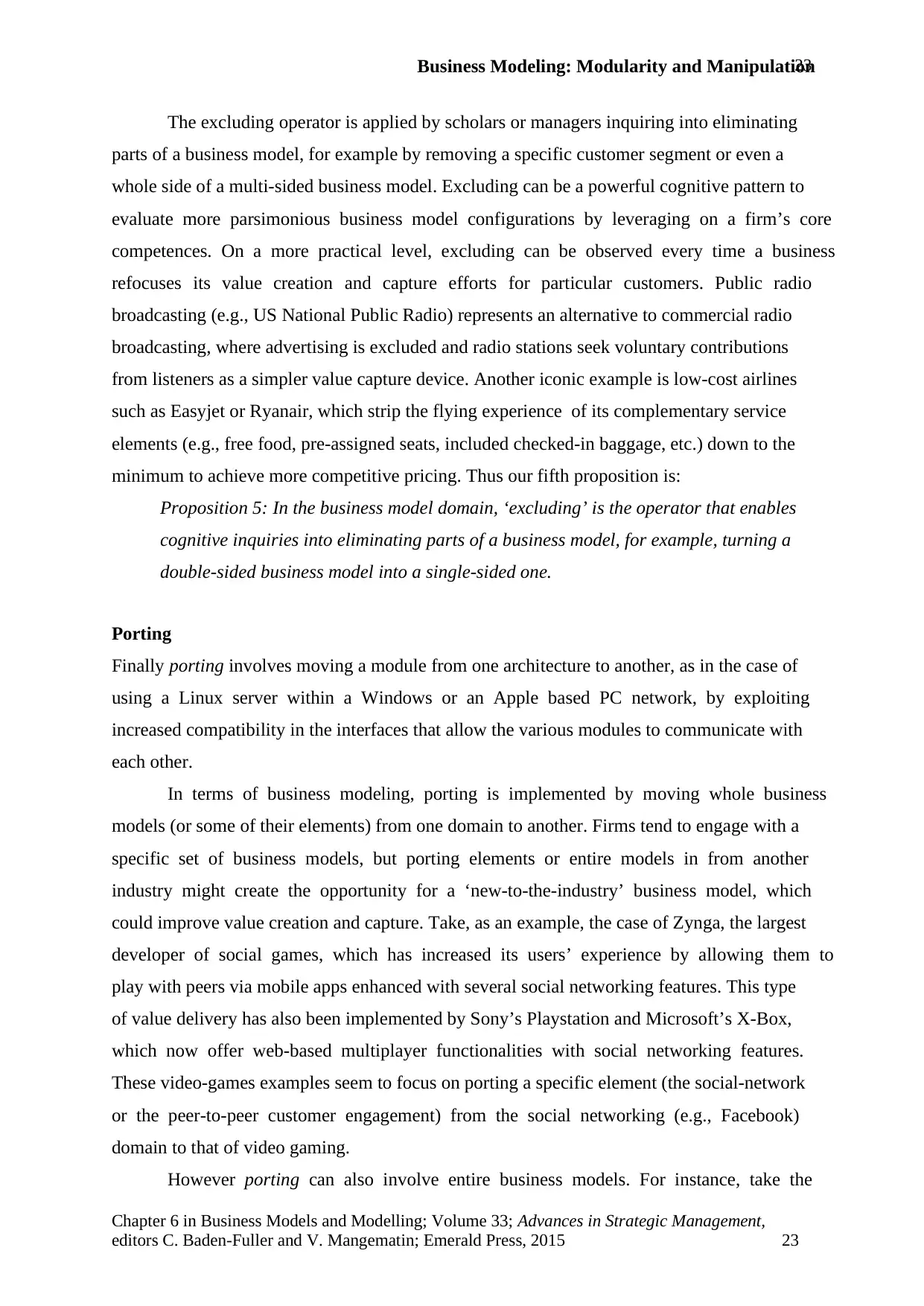
Business Modeling: Modularity and Manipulation
Chapter 6 in Business Models and Modelling; Volume 33; Advances in Strategic Management,
editors C. Baden-Fuller and V. Mangematin; Emerald Press, 2015 23
23
The excluding operator is applied by scholars or managers inquiring into eliminating
parts of a business model, for example by removing a specific customer segment or even a
whole side of a multi-sided business model. Excluding can be a powerful cognitive pattern to
evaluate more parsimonious business model configurations by leveraging on a firm’s core
competences. On a more practical level, excluding can be observed every time a business
refocuses its value creation and capture efforts for particular customers. Public radio
broadcasting (e.g., US National Public Radio) represents an alternative to commercial radio
broadcasting, where advertising is excluded and radio stations seek voluntary contributions
from listeners as a simpler value capture device. Another iconic example is low-cost airlines
such as Easyjet or Ryanair, which strip the flying experience of its complementary service
elements (e.g., free food, pre-assigned seats, included checked-in baggage, etc.) down to the
minimum to achieve more competitive pricing. Thus our fifth proposition is:
Proposition 5: In the business model domain, ‘excluding’ is the operator that enables
cognitive inquiries into eliminating parts of a business model, for example, turning a
double-sided business model into a single-sided one.
Porting
Finally porting involves moving a module from one architecture to another, as in the case of
using a Linux server within a Windows or an Apple based PC network, by exploiting
increased compatibility in the interfaces that allow the various modules to communicate with
each other.
In terms of business modeling, porting is implemented by moving whole business
models (or some of their elements) from one domain to another. Firms tend to engage with a
specific set of business models, but porting elements or entire models in from another
industry might create the opportunity for a ‘new-to-the-industry’ business model, which
could improve value creation and capture. Take, as an example, the case of Zynga, the largest
developer of social games, which has increased its users’ experience by allowing them to
play with peers via mobile apps enhanced with several social networking features. This type
of value delivery has also been implemented by Sony’s Playstation and Microsoft’s X-Box,
which now offer web-based multiplayer functionalities with social networking features.
These video-games examples seem to focus on porting a specific element (the social-network
or the peer-to-peer customer engagement) from the social networking (e.g., Facebook)
domain to that of video gaming.
However porting can also involve entire business models. For instance, take the
Chapter 6 in Business Models and Modelling; Volume 33; Advances in Strategic Management,
editors C. Baden-Fuller and V. Mangematin; Emerald Press, 2015 23
23
The excluding operator is applied by scholars or managers inquiring into eliminating
parts of a business model, for example by removing a specific customer segment or even a
whole side of a multi-sided business model. Excluding can be a powerful cognitive pattern to
evaluate more parsimonious business model configurations by leveraging on a firm’s core
competences. On a more practical level, excluding can be observed every time a business
refocuses its value creation and capture efforts for particular customers. Public radio
broadcasting (e.g., US National Public Radio) represents an alternative to commercial radio
broadcasting, where advertising is excluded and radio stations seek voluntary contributions
from listeners as a simpler value capture device. Another iconic example is low-cost airlines
such as Easyjet or Ryanair, which strip the flying experience of its complementary service
elements (e.g., free food, pre-assigned seats, included checked-in baggage, etc.) down to the
minimum to achieve more competitive pricing. Thus our fifth proposition is:
Proposition 5: In the business model domain, ‘excluding’ is the operator that enables
cognitive inquiries into eliminating parts of a business model, for example, turning a
double-sided business model into a single-sided one.
Porting
Finally porting involves moving a module from one architecture to another, as in the case of
using a Linux server within a Windows or an Apple based PC network, by exploiting
increased compatibility in the interfaces that allow the various modules to communicate with
each other.
In terms of business modeling, porting is implemented by moving whole business
models (or some of their elements) from one domain to another. Firms tend to engage with a
specific set of business models, but porting elements or entire models in from another
industry might create the opportunity for a ‘new-to-the-industry’ business model, which
could improve value creation and capture. Take, as an example, the case of Zynga, the largest
developer of social games, which has increased its users’ experience by allowing them to
play with peers via mobile apps enhanced with several social networking features. This type
of value delivery has also been implemented by Sony’s Playstation and Microsoft’s X-Box,
which now offer web-based multiplayer functionalities with social networking features.
These video-games examples seem to focus on porting a specific element (the social-network
or the peer-to-peer customer engagement) from the social networking (e.g., Facebook)
domain to that of video gaming.
However porting can also involve entire business models. For instance, take the

Business Modeling: Modularity and Manipulation
Chapter 6 in Business Models and Modelling; Volume 33; Advances in Strategic Management,
editors C. Baden-Fuller and V. Mangematin; Emerald Press, 2015 24
24
increasing introduction of sharing economy models, such as collaborative consumption, into
traditional business models such as car rental (e.g., the Zipcar business model). Generally
speaking, every time scholars or practitioners speculate on ‘how to become the Airbnb of
industry X’ or ‘the Ikea of industry Y’, they are making a thought exercise based on the idea
of porting. Still, porting a whole business model is an operation that needs not only
consideration of the new business model in its entirety, but also its complementarities with
other existing business models in the portfolio (when relevant). For example, major airlines
wanting to embrace a complementary low-cost service based on a ‘Ryanair-like business
model’ may need to adjust the pricing and services of their prime operation to avoid
cannibalization between their own business models. A holistic view of these factors must also
consider business model configurations at the portfolio level. Thus we propose:
Proposition 6: In the business model domain, ‘porting’ is the operator that enables
cognitive inquiries by adopting a business model (or some business model elements)
from different domains and industries, and which are which ‘new to the field’.
So far, we have sketched a first overview of the possible opportunities derived by extending
some key principles of modularity into business model thinking and manipulation. We have
generalized the modularity operators in terms of cognitive patterns that scholars or
practitioners might find useful to think about when renewing their business models. We have
also considered how those who want to manipulate model elements need to consider the
parallel effects on the business model as a whole, or in some cases even at the business model
portfolio level. The examples above suggest practical ways in which applying modular
operators might help them delve more systematically into thinking and classifying business
model change. Moreover, we have considered how scholars and managers might gather
deeper insights by looking at existing iconic patterns of business model innovation from their
direct competitors, or from other industries.
As an illustration of how applying different operators can result in meaningful
business model variations, consider this stylized example of Amazon’s business model
innovation. Amazon initially challenged its ‘bricks and mortar’ business model, which was
typical of the traditional retailing industry, by substituting a new online distribution platform
for its conventional delivery and customer engagement channels (physical stores). A few
years later, Amazon introduced another major innovation into its business model, again by
substituting the typical e-commerce value chain and linkages (based on proprietary
warehousing), to allow other physical sellers to use Amazon’s customer base. Similarly,
Chapter 6 in Business Models and Modelling; Volume 33; Advances in Strategic Management,
editors C. Baden-Fuller and V. Mangematin; Emerald Press, 2015 24
24
increasing introduction of sharing economy models, such as collaborative consumption, into
traditional business models such as car rental (e.g., the Zipcar business model). Generally
speaking, every time scholars or practitioners speculate on ‘how to become the Airbnb of
industry X’ or ‘the Ikea of industry Y’, they are making a thought exercise based on the idea
of porting. Still, porting a whole business model is an operation that needs not only
consideration of the new business model in its entirety, but also its complementarities with
other existing business models in the portfolio (when relevant). For example, major airlines
wanting to embrace a complementary low-cost service based on a ‘Ryanair-like business
model’ may need to adjust the pricing and services of their prime operation to avoid
cannibalization between their own business models. A holistic view of these factors must also
consider business model configurations at the portfolio level. Thus we propose:
Proposition 6: In the business model domain, ‘porting’ is the operator that enables
cognitive inquiries by adopting a business model (or some business model elements)
from different domains and industries, and which are which ‘new to the field’.
So far, we have sketched a first overview of the possible opportunities derived by extending
some key principles of modularity into business model thinking and manipulation. We have
generalized the modularity operators in terms of cognitive patterns that scholars or
practitioners might find useful to think about when renewing their business models. We have
also considered how those who want to manipulate model elements need to consider the
parallel effects on the business model as a whole, or in some cases even at the business model
portfolio level. The examples above suggest practical ways in which applying modular
operators might help them delve more systematically into thinking and classifying business
model change. Moreover, we have considered how scholars and managers might gather
deeper insights by looking at existing iconic patterns of business model innovation from their
direct competitors, or from other industries.
As an illustration of how applying different operators can result in meaningful
business model variations, consider this stylized example of Amazon’s business model
innovation. Amazon initially challenged its ‘bricks and mortar’ business model, which was
typical of the traditional retailing industry, by substituting a new online distribution platform
for its conventional delivery and customer engagement channels (physical stores). A few
years later, Amazon introduced another major innovation into its business model, again by
substituting the typical e-commerce value chain and linkages (based on proprietary
warehousing), to allow other physical sellers to use Amazon’s customer base. Similarly,
Paraphrase This Document
Need a fresh take? Get an instant paraphrase of this document with our AI Paraphraser
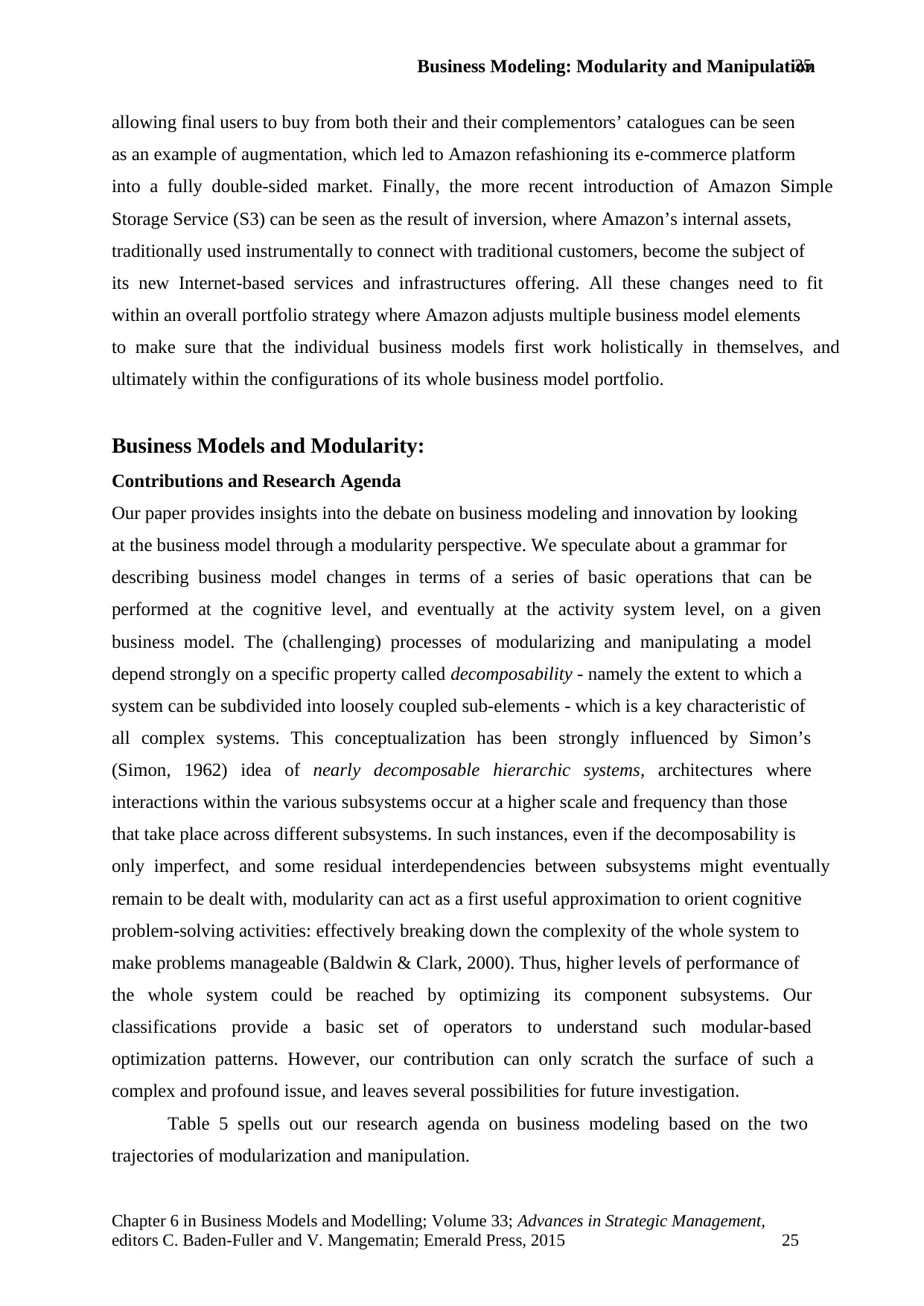
Business Modeling: Modularity and Manipulation
Chapter 6 in Business Models and Modelling; Volume 33; Advances in Strategic Management,
editors C. Baden-Fuller and V. Mangematin; Emerald Press, 2015 25
25
allowing final users to buy from both their and their complementors’ catalogues can be seen
as an example of augmentation, which led to Amazon refashioning its e-commerce platform
into a fully double-sided market. Finally, the more recent introduction of Amazon Simple
Storage Service (S3) can be seen as the result of inversion, where Amazon’s internal assets,
traditionally used instrumentally to connect with traditional customers, become the subject of
its new Internet-based services and infrastructures offering. All these changes need to fit
within an overall portfolio strategy where Amazon adjusts multiple business model elements
to make sure that the individual business models first work holistically in themselves, and
ultimately within the configurations of its whole business model portfolio.
Business Models and Modularity:
Contributions and Research Agenda
Our paper provides insights into the debate on business modeling and innovation by looking
at the business model through a modularity perspective. We speculate about a grammar for
describing business model changes in terms of a series of basic operations that can be
performed at the cognitive level, and eventually at the activity system level, on a given
business model. The (challenging) processes of modularizing and manipulating a model
depend strongly on a specific property called decomposability - namely the extent to which a
system can be subdivided into loosely coupled sub-elements - which is a key characteristic of
all complex systems. This conceptualization has been strongly influenced by Simon’s
(Simon, 1962) idea of nearly decomposable hierarchic systems, architectures where
interactions within the various subsystems occur at a higher scale and frequency than those
that take place across different subsystems. In such instances, even if the decomposability is
only imperfect, and some residual interdependencies between subsystems might eventually
remain to be dealt with, modularity can act as a first useful approximation to orient cognitive
problem-solving activities: effectively breaking down the complexity of the whole system to
make problems manageable (Baldwin & Clark, 2000). Thus, higher levels of performance of
the whole system could be reached by optimizing its component subsystems. Our
classifications provide a basic set of operators to understand such modular-based
optimization patterns. However, our contribution can only scratch the surface of such a
complex and profound issue, and leaves several possibilities for future investigation.
Table 5 spells out our research agenda on business modeling based on the two
trajectories of modularization and manipulation.
Chapter 6 in Business Models and Modelling; Volume 33; Advances in Strategic Management,
editors C. Baden-Fuller and V. Mangematin; Emerald Press, 2015 25
25
allowing final users to buy from both their and their complementors’ catalogues can be seen
as an example of augmentation, which led to Amazon refashioning its e-commerce platform
into a fully double-sided market. Finally, the more recent introduction of Amazon Simple
Storage Service (S3) can be seen as the result of inversion, where Amazon’s internal assets,
traditionally used instrumentally to connect with traditional customers, become the subject of
its new Internet-based services and infrastructures offering. All these changes need to fit
within an overall portfolio strategy where Amazon adjusts multiple business model elements
to make sure that the individual business models first work holistically in themselves, and
ultimately within the configurations of its whole business model portfolio.
Business Models and Modularity:
Contributions and Research Agenda
Our paper provides insights into the debate on business modeling and innovation by looking
at the business model through a modularity perspective. We speculate about a grammar for
describing business model changes in terms of a series of basic operations that can be
performed at the cognitive level, and eventually at the activity system level, on a given
business model. The (challenging) processes of modularizing and manipulating a model
depend strongly on a specific property called decomposability - namely the extent to which a
system can be subdivided into loosely coupled sub-elements - which is a key characteristic of
all complex systems. This conceptualization has been strongly influenced by Simon’s
(Simon, 1962) idea of nearly decomposable hierarchic systems, architectures where
interactions within the various subsystems occur at a higher scale and frequency than those
that take place across different subsystems. In such instances, even if the decomposability is
only imperfect, and some residual interdependencies between subsystems might eventually
remain to be dealt with, modularity can act as a first useful approximation to orient cognitive
problem-solving activities: effectively breaking down the complexity of the whole system to
make problems manageable (Baldwin & Clark, 2000). Thus, higher levels of performance of
the whole system could be reached by optimizing its component subsystems. Our
classifications provide a basic set of operators to understand such modular-based
optimization patterns. However, our contribution can only scratch the surface of such a
complex and profound issue, and leaves several possibilities for future investigation.
Table 5 spells out our research agenda on business modeling based on the two
trajectories of modularization and manipulation.
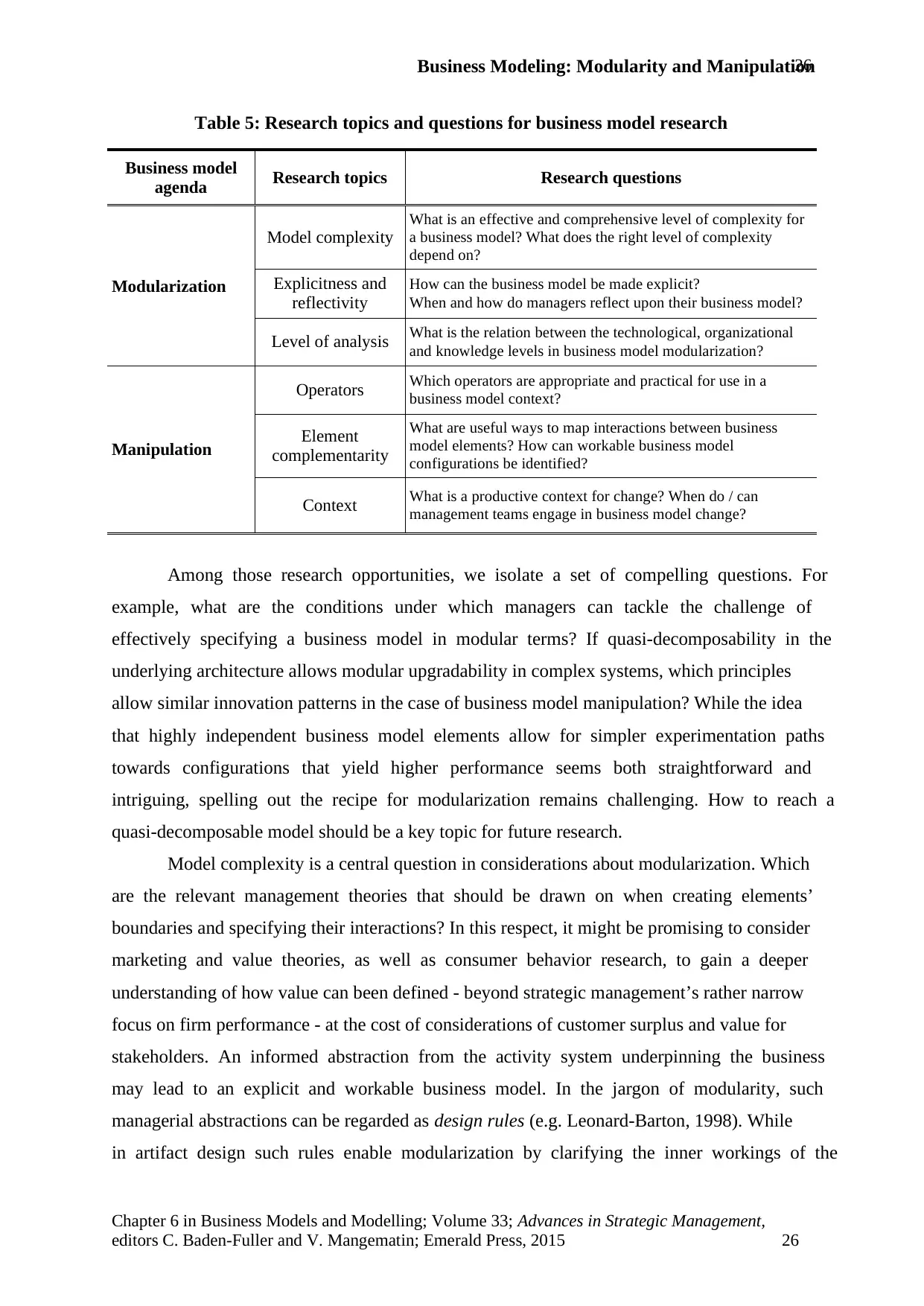
Business Modeling: Modularity and Manipulation
Chapter 6 in Business Models and Modelling; Volume 33; Advances in Strategic Management,
editors C. Baden-Fuller and V. Mangematin; Emerald Press, 2015 26
26
Table 5: Research topics and questions for business model research
Business model
agenda Research topics Research questions
Modularization
Model complexity
What is an effective and comprehensive level of complexity for
a business model? What does the right level of complexity
depend on?
Explicitness and
reflectivity
How can the business model be made explicit?
When and how do managers reflect upon their business model?
Level of analysis What is the relation between the technological, organizational
and knowledge levels in business model modularization?
Manipulation
Operators Which operators are appropriate and practical for use in a
business model context?
Element
complementarity
What are useful ways to map interactions between business
model elements? How can workable business model
configurations be identified?
Context What is a productive context for change? When do / can
management teams engage in business model change?
Among those research opportunities, we isolate a set of compelling questions. For
example, what are the conditions under which managers can tackle the challenge of
effectively specifying a business model in modular terms? If quasi-decomposability in the
underlying architecture allows modular upgradability in complex systems, which principles
allow similar innovation patterns in the case of business model manipulation? While the idea
that highly independent business model elements allow for simpler experimentation paths
towards configurations that yield higher performance seems both straightforward and
intriguing, spelling out the recipe for modularization remains challenging. How to reach a
quasi-decomposable model should be a key topic for future research.
Model complexity is a central question in considerations about modularization. Which
are the relevant management theories that should be drawn on when creating elements’
boundaries and specifying their interactions? In this respect, it might be promising to consider
marketing and value theories, as well as consumer behavior research, to gain a deeper
understanding of how value can been defined - beyond strategic management’s rather narrow
focus on firm performance - at the cost of considerations of customer surplus and value for
stakeholders. An informed abstraction from the activity system underpinning the business
may lead to an explicit and workable business model. In the jargon of modularity, such
managerial abstractions can be regarded as design rules (e.g. Leonard-Barton, 1998). While
in artifact design such rules enable modularization by clarifying the inner workings of the
Chapter 6 in Business Models and Modelling; Volume 33; Advances in Strategic Management,
editors C. Baden-Fuller and V. Mangematin; Emerald Press, 2015 26
26
Table 5: Research topics and questions for business model research
Business model
agenda Research topics Research questions
Modularization
Model complexity
What is an effective and comprehensive level of complexity for
a business model? What does the right level of complexity
depend on?
Explicitness and
reflectivity
How can the business model be made explicit?
When and how do managers reflect upon their business model?
Level of analysis What is the relation between the technological, organizational
and knowledge levels in business model modularization?
Manipulation
Operators Which operators are appropriate and practical for use in a
business model context?
Element
complementarity
What are useful ways to map interactions between business
model elements? How can workable business model
configurations be identified?
Context What is a productive context for change? When do / can
management teams engage in business model change?
Among those research opportunities, we isolate a set of compelling questions. For
example, what are the conditions under which managers can tackle the challenge of
effectively specifying a business model in modular terms? If quasi-decomposability in the
underlying architecture allows modular upgradability in complex systems, which principles
allow similar innovation patterns in the case of business model manipulation? While the idea
that highly independent business model elements allow for simpler experimentation paths
towards configurations that yield higher performance seems both straightforward and
intriguing, spelling out the recipe for modularization remains challenging. How to reach a
quasi-decomposable model should be a key topic for future research.
Model complexity is a central question in considerations about modularization. Which
are the relevant management theories that should be drawn on when creating elements’
boundaries and specifying their interactions? In this respect, it might be promising to consider
marketing and value theories, as well as consumer behavior research, to gain a deeper
understanding of how value can been defined - beyond strategic management’s rather narrow
focus on firm performance - at the cost of considerations of customer surplus and value for
stakeholders. An informed abstraction from the activity system underpinning the business
may lead to an explicit and workable business model. In the jargon of modularity, such
managerial abstractions can be regarded as design rules (e.g. Leonard-Barton, 1998). While
in artifact design such rules enable modularization by clarifying the inner workings of the
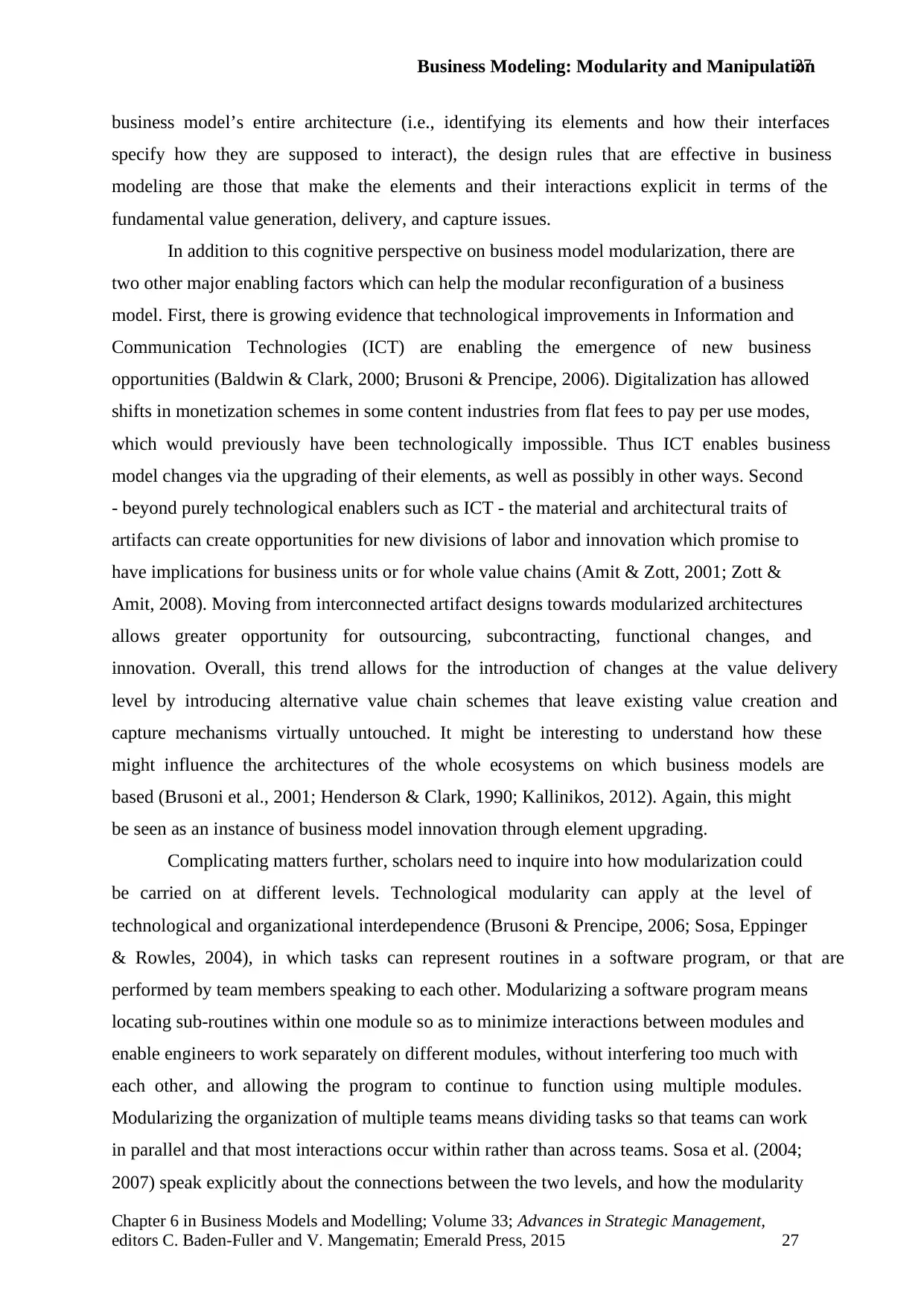
Business Modeling: Modularity and Manipulation
Chapter 6 in Business Models and Modelling; Volume 33; Advances in Strategic Management,
editors C. Baden-Fuller and V. Mangematin; Emerald Press, 2015 27
27
business model’s entire architecture (i.e., identifying its elements and how their interfaces
specify how they are supposed to interact), the design rules that are effective in business
modeling are those that make the elements and their interactions explicit in terms of the
fundamental value generation, delivery, and capture issues.
In addition to this cognitive perspective on business model modularization, there are
two other major enabling factors which can help the modular reconfiguration of a business
model. First, there is growing evidence that technological improvements in Information and
Communication Technologies (ICT) are enabling the emergence of new business
opportunities (Baldwin & Clark, 2000; Brusoni & Prencipe, 2006). Digitalization has allowed
shifts in monetization schemes in some content industries from flat fees to pay per use modes,
which would previously have been technologically impossible. Thus ICT enables business
model changes via the upgrading of their elements, as well as possibly in other ways. Second
- beyond purely technological enablers such as ICT - the material and architectural traits of
artifacts can create opportunities for new divisions of labor and innovation which promise to
have implications for business units or for whole value chains (Amit & Zott, 2001; Zott &
Amit, 2008). Moving from interconnected artifact designs towards modularized architectures
allows greater opportunity for outsourcing, subcontracting, functional changes, and
innovation. Overall, this trend allows for the introduction of changes at the value delivery
level by introducing alternative value chain schemes that leave existing value creation and
capture mechanisms virtually untouched. It might be interesting to understand how these
might influence the architectures of the whole ecosystems on which business models are
based (Brusoni et al., 2001; Henderson & Clark, 1990; Kallinikos, 2012). Again, this might
be seen as an instance of business model innovation through element upgrading.
Complicating matters further, scholars need to inquire into how modularization could
be carried on at different levels. Technological modularity can apply at the level of
technological and organizational interdependence (Brusoni & Prencipe, 2006; Sosa, Eppinger
& Rowles, 2004), in which tasks can represent routines in a software program, or that are
performed by team members speaking to each other. Modularizing a software program means
locating sub-routines within one module so as to minimize interactions between modules and
enable engineers to work separately on different modules, without interfering too much with
each other, and allowing the program to continue to function using multiple modules.
Modularizing the organization of multiple teams means dividing tasks so that teams can work
in parallel and that most interactions occur within rather than across teams. Sosa et al. (2004;
2007) speak explicitly about the connections between the two levels, and how the modularity
Chapter 6 in Business Models and Modelling; Volume 33; Advances in Strategic Management,
editors C. Baden-Fuller and V. Mangematin; Emerald Press, 2015 27
27
business model’s entire architecture (i.e., identifying its elements and how their interfaces
specify how they are supposed to interact), the design rules that are effective in business
modeling are those that make the elements and their interactions explicit in terms of the
fundamental value generation, delivery, and capture issues.
In addition to this cognitive perspective on business model modularization, there are
two other major enabling factors which can help the modular reconfiguration of a business
model. First, there is growing evidence that technological improvements in Information and
Communication Technologies (ICT) are enabling the emergence of new business
opportunities (Baldwin & Clark, 2000; Brusoni & Prencipe, 2006). Digitalization has allowed
shifts in monetization schemes in some content industries from flat fees to pay per use modes,
which would previously have been technologically impossible. Thus ICT enables business
model changes via the upgrading of their elements, as well as possibly in other ways. Second
- beyond purely technological enablers such as ICT - the material and architectural traits of
artifacts can create opportunities for new divisions of labor and innovation which promise to
have implications for business units or for whole value chains (Amit & Zott, 2001; Zott &
Amit, 2008). Moving from interconnected artifact designs towards modularized architectures
allows greater opportunity for outsourcing, subcontracting, functional changes, and
innovation. Overall, this trend allows for the introduction of changes at the value delivery
level by introducing alternative value chain schemes that leave existing value creation and
capture mechanisms virtually untouched. It might be interesting to understand how these
might influence the architectures of the whole ecosystems on which business models are
based (Brusoni et al., 2001; Henderson & Clark, 1990; Kallinikos, 2012). Again, this might
be seen as an instance of business model innovation through element upgrading.
Complicating matters further, scholars need to inquire into how modularization could
be carried on at different levels. Technological modularity can apply at the level of
technological and organizational interdependence (Brusoni & Prencipe, 2006; Sosa, Eppinger
& Rowles, 2004), in which tasks can represent routines in a software program, or that are
performed by team members speaking to each other. Modularizing a software program means
locating sub-routines within one module so as to minimize interactions between modules and
enable engineers to work separately on different modules, without interfering too much with
each other, and allowing the program to continue to function using multiple modules.
Modularizing the organization of multiple teams means dividing tasks so that teams can work
in parallel and that most interactions occur within rather than across teams. Sosa et al. (2004;
2007) speak explicitly about the connections between the two levels, and how the modularity
Secure Best Marks with AI Grader
Need help grading? Try our AI Grader for instant feedback on your assignments.

Business Modeling: Modularity and Manipulation
Chapter 6 in Business Models and Modelling; Volume 33; Advances in Strategic Management,
editors C. Baden-Fuller and V. Mangematin; Emerald Press, 2015 28
28
of teams should be aligned with the modularity of the technologies on which they are
working. When referring to the modularity of business models, we also talk about a third
level - the knowledge domain (Brusoni & Prencipe, 2006: 185) - which precedes and
accompanies both the organizational and the technology domains, in that managers need to
understand what they are modularizing and why - in terms of both business activities and
technologies.
The second set of questions, which relate to the issue of manipulability and its
boundary conditions, also deserves particular attention. First, some of the lessons learned
from modularity can be applied fruitfully regardless of the extent to which a business model
is truly modular. Applying modularity principles and operators can also be helpful as a first
cognitive approximation in settings where the business model is not made explicit, or is best
described as non-modular or as deeply intertwined. In many instances, it may seem that
business models are delicate, tightly interconnected systems of parts where changing even a
single element could trigger a series of adjustments that would influence the model’s overall
integration and performance. In this regard, different levels of integration between elements -
e.g., tightly vs. loosely coupled relationships (Brusoni & Prencipe, 2001b) - might moderate
the relationship between a change in an element and the system’s overall performance, thus
leading to different outcomes. For instance, simply introducing a premium service on top of a
previously free offering will not work out effectively in a business model without also
retouching the value creation domain that is being adjusted (the premium user might be not
the same as the free user, and engaging such consumers might require different skills). In
terms of modularity theory, such a change would trigger a sequence of testing and integration
activities between the elements (given their interdependencies, and due to the model’s non-
decomposability), which might entail adjustments or revisions in various elements before a
satisfactory outcome can be reached. This also connects to the idea of product or service
bundling (Stremersch & Tellis, 2002), in the sense that bundling different elements together
(e.g., different value offers, such as the premium and the free) will lead to the configuration
of the business model (e.g., into a freemium model) whose effects might differ from those of
just the sum of the two configurations in isolation.
Further, the idea of manipulation deserves attention in terms of how modular
operators are applied in business model innovation. Do they highlight alternative, novel,
competing, better versions of the original business model’s configuration? Or do they suggest
complementary, integrative business models that a firm can implement jointly and
simultaneously as a way to diversify its recipes for success? Modularity may or may not be
Chapter 6 in Business Models and Modelling; Volume 33; Advances in Strategic Management,
editors C. Baden-Fuller and V. Mangematin; Emerald Press, 2015 28
28
of teams should be aligned with the modularity of the technologies on which they are
working. When referring to the modularity of business models, we also talk about a third
level - the knowledge domain (Brusoni & Prencipe, 2006: 185) - which precedes and
accompanies both the organizational and the technology domains, in that managers need to
understand what they are modularizing and why - in terms of both business activities and
technologies.
The second set of questions, which relate to the issue of manipulability and its
boundary conditions, also deserves particular attention. First, some of the lessons learned
from modularity can be applied fruitfully regardless of the extent to which a business model
is truly modular. Applying modularity principles and operators can also be helpful as a first
cognitive approximation in settings where the business model is not made explicit, or is best
described as non-modular or as deeply intertwined. In many instances, it may seem that
business models are delicate, tightly interconnected systems of parts where changing even a
single element could trigger a series of adjustments that would influence the model’s overall
integration and performance. In this regard, different levels of integration between elements -
e.g., tightly vs. loosely coupled relationships (Brusoni & Prencipe, 2001b) - might moderate
the relationship between a change in an element and the system’s overall performance, thus
leading to different outcomes. For instance, simply introducing a premium service on top of a
previously free offering will not work out effectively in a business model without also
retouching the value creation domain that is being adjusted (the premium user might be not
the same as the free user, and engaging such consumers might require different skills). In
terms of modularity theory, such a change would trigger a sequence of testing and integration
activities between the elements (given their interdependencies, and due to the model’s non-
decomposability), which might entail adjustments or revisions in various elements before a
satisfactory outcome can be reached. This also connects to the idea of product or service
bundling (Stremersch & Tellis, 2002), in the sense that bundling different elements together
(e.g., different value offers, such as the premium and the free) will lead to the configuration
of the business model (e.g., into a freemium model) whose effects might differ from those of
just the sum of the two configurations in isolation.
Further, the idea of manipulation deserves attention in terms of how modular
operators are applied in business model innovation. Do they highlight alternative, novel,
competing, better versions of the original business model’s configuration? Or do they suggest
complementary, integrative business models that a firm can implement jointly and
simultaneously as a way to diversify its recipes for success? Modularity may or may not be

Business Modeling: Modularity and Manipulation
Chapter 6 in Business Models and Modelling; Volume 33; Advances in Strategic Management,
editors C. Baden-Fuller and V. Mangematin; Emerald Press, 2015 29
29
an ideal guide - but we can identify three research topics that may help shed light on the
application of the operators: the complementarity of elements within business model
configurations; the context of manipulation in collective thinking; and engagement among the
management team.
Many large companies engage in running more than one business model
simultaneously (Casadesus-Masanell & Tarzijan, 2012; Markides & Charitou, 2004), and the
manipulation of a business model may lead to complementarities between those different
models. Random manipulation cannot be a goal, but rather an informed play that may result
in new business model configurations that promise to be viable innovations when
implemented. In order to understand complementarities among business model elements (and
between entire models) it may first of all be helpful to map and follow the interactions that
exist in the current configuration. Value delivery involves upstream and downstream
partners, whose behaviors may be beyond the control of the focal firm, and such partners may
limit information flows about their critical strategic moves. Future research in strategy should
consider multiple business models explicitly, and which sorts of configurations prove viable
for firms. Literature on this topic is scarce, despite the insights that complementarities
between business models matter both for performance and for competitive dynamics and
innovation.
Finally, our analogical reasoning compares technology and business model operators,
suggesting that modularity theory might inform both technologies and business models.
However, a well-known trade-off applies in both fields: the modularization of a system
should not be thought of as being independent of its environment, lest it suffers from being
locked in to inferior designs or inefficient search patterns (Baden-Fuller & Haefliger, 2013).
Thus, the modularization of a business model as a cognitive task should take into account the
intensity of environmental change: this is a prerequisite for effective business model change,
and so may be a limitation on the usefulness of the operators we outline above.
Innovation is not a leisurely activity, and needs to be conducted under strict deadlines.
Others have compared management to theatre production, and insisted that the costs of
iteration in experimentation mean that knowledge work becomes more and more like
rehearsals prior to stage performances (Austin & Devin, 2003). Business models reduce
reality to a set of comprehensive elements that can be rehearsed and then played out under
various scenarios - and quickly, cheaply, and collectively. The rehearsal requires
manipulation of the different elements so that the play (the new business model) comes
together as a coherent and effective piece in performance. All the actors involved need to
Chapter 6 in Business Models and Modelling; Volume 33; Advances in Strategic Management,
editors C. Baden-Fuller and V. Mangematin; Emerald Press, 2015 29
29
an ideal guide - but we can identify three research topics that may help shed light on the
application of the operators: the complementarity of elements within business model
configurations; the context of manipulation in collective thinking; and engagement among the
management team.
Many large companies engage in running more than one business model
simultaneously (Casadesus-Masanell & Tarzijan, 2012; Markides & Charitou, 2004), and the
manipulation of a business model may lead to complementarities between those different
models. Random manipulation cannot be a goal, but rather an informed play that may result
in new business model configurations that promise to be viable innovations when
implemented. In order to understand complementarities among business model elements (and
between entire models) it may first of all be helpful to map and follow the interactions that
exist in the current configuration. Value delivery involves upstream and downstream
partners, whose behaviors may be beyond the control of the focal firm, and such partners may
limit information flows about their critical strategic moves. Future research in strategy should
consider multiple business models explicitly, and which sorts of configurations prove viable
for firms. Literature on this topic is scarce, despite the insights that complementarities
between business models matter both for performance and for competitive dynamics and
innovation.
Finally, our analogical reasoning compares technology and business model operators,
suggesting that modularity theory might inform both technologies and business models.
However, a well-known trade-off applies in both fields: the modularization of a system
should not be thought of as being independent of its environment, lest it suffers from being
locked in to inferior designs or inefficient search patterns (Baden-Fuller & Haefliger, 2013).
Thus, the modularization of a business model as a cognitive task should take into account the
intensity of environmental change: this is a prerequisite for effective business model change,
and so may be a limitation on the usefulness of the operators we outline above.
Innovation is not a leisurely activity, and needs to be conducted under strict deadlines.
Others have compared management to theatre production, and insisted that the costs of
iteration in experimentation mean that knowledge work becomes more and more like
rehearsals prior to stage performances (Austin & Devin, 2003). Business models reduce
reality to a set of comprehensive elements that can be rehearsed and then played out under
various scenarios - and quickly, cheaply, and collectively. The rehearsal requires
manipulation of the different elements so that the play (the new business model) comes
together as a coherent and effective piece in performance. All the actors involved need to
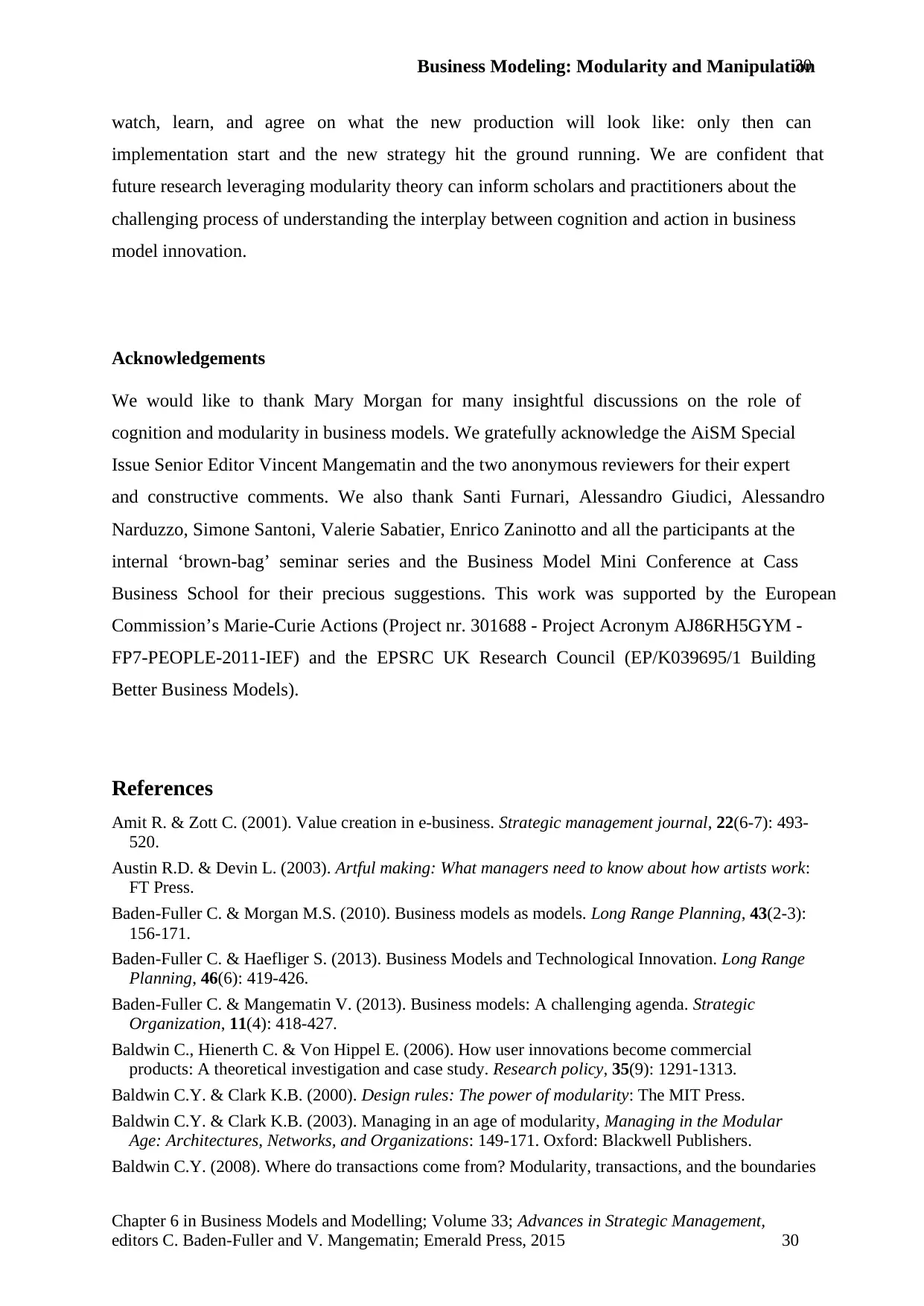
Business Modeling: Modularity and Manipulation
Chapter 6 in Business Models and Modelling; Volume 33; Advances in Strategic Management,
editors C. Baden-Fuller and V. Mangematin; Emerald Press, 2015 30
30
watch, learn, and agree on what the new production will look like: only then can
implementation start and the new strategy hit the ground running. We are confident that
future research leveraging modularity theory can inform scholars and practitioners about the
challenging process of understanding the interplay between cognition and action in business
model innovation.
Acknowledgements
We would like to thank Mary Morgan for many insightful discussions on the role of
cognition and modularity in business models. We gratefully acknowledge the AiSM Special
Issue Senior Editor Vincent Mangematin and the two anonymous reviewers for their expert
and constructive comments. We also thank Santi Furnari, Alessandro Giudici, Alessandro
Narduzzo, Simone Santoni, Valerie Sabatier, Enrico Zaninotto and all the participants at the
internal ‘brown-bag’ seminar series and the Business Model Mini Conference at Cass
Business School for their precious suggestions. This work was supported by the European
Commission’s Marie-Curie Actions (Project nr. 301688 - Project Acronym AJ86RH5GYM -
FP7-PEOPLE-2011-IEF) and the EPSRC UK Research Council (EP/K039695/1 Building
Better Business Models).
References
Amit R. & Zott C. (2001). Value creation in e-business. Strategic management journal, 22(6-7): 493-
520.
Austin R.D. & Devin L. (2003). Artful making: What managers need to know about how artists work:
FT Press.
Baden-Fuller C. & Morgan M.S. (2010). Business models as models. Long Range Planning, 43(2-3):
156-171.
Baden-Fuller C. & Haefliger S. (2013). Business Models and Technological Innovation. Long Range
Planning, 46(6): 419-426.
Baden-Fuller C. & Mangematin V. (2013). Business models: A challenging agenda. Strategic
Organization, 11(4): 418-427.
Baldwin C., Hienerth C. & Von Hippel E. (2006). How user innovations become commercial
products: A theoretical investigation and case study. Research policy, 35(9): 1291-1313.
Baldwin C.Y. & Clark K.B. (2000). Design rules: The power of modularity: The MIT Press.
Baldwin C.Y. & Clark K.B. (2003). Managing in an age of modularity, Managing in the Modular
Age: Architectures, Networks, and Organizations: 149-171. Oxford: Blackwell Publishers.
Baldwin C.Y. (2008). Where do transactions come from? Modularity, transactions, and the boundaries
Chapter 6 in Business Models and Modelling; Volume 33; Advances in Strategic Management,
editors C. Baden-Fuller and V. Mangematin; Emerald Press, 2015 30
30
watch, learn, and agree on what the new production will look like: only then can
implementation start and the new strategy hit the ground running. We are confident that
future research leveraging modularity theory can inform scholars and practitioners about the
challenging process of understanding the interplay between cognition and action in business
model innovation.
Acknowledgements
We would like to thank Mary Morgan for many insightful discussions on the role of
cognition and modularity in business models. We gratefully acknowledge the AiSM Special
Issue Senior Editor Vincent Mangematin and the two anonymous reviewers for their expert
and constructive comments. We also thank Santi Furnari, Alessandro Giudici, Alessandro
Narduzzo, Simone Santoni, Valerie Sabatier, Enrico Zaninotto and all the participants at the
internal ‘brown-bag’ seminar series and the Business Model Mini Conference at Cass
Business School for their precious suggestions. This work was supported by the European
Commission’s Marie-Curie Actions (Project nr. 301688 - Project Acronym AJ86RH5GYM -
FP7-PEOPLE-2011-IEF) and the EPSRC UK Research Council (EP/K039695/1 Building
Better Business Models).
References
Amit R. & Zott C. (2001). Value creation in e-business. Strategic management journal, 22(6-7): 493-
520.
Austin R.D. & Devin L. (2003). Artful making: What managers need to know about how artists work:
FT Press.
Baden-Fuller C. & Morgan M.S. (2010). Business models as models. Long Range Planning, 43(2-3):
156-171.
Baden-Fuller C. & Haefliger S. (2013). Business Models and Technological Innovation. Long Range
Planning, 46(6): 419-426.
Baden-Fuller C. & Mangematin V. (2013). Business models: A challenging agenda. Strategic
Organization, 11(4): 418-427.
Baldwin C., Hienerth C. & Von Hippel E. (2006). How user innovations become commercial
products: A theoretical investigation and case study. Research policy, 35(9): 1291-1313.
Baldwin C.Y. & Clark K.B. (2000). Design rules: The power of modularity: The MIT Press.
Baldwin C.Y. & Clark K.B. (2003). Managing in an age of modularity, Managing in the Modular
Age: Architectures, Networks, and Organizations: 149-171. Oxford: Blackwell Publishers.
Baldwin C.Y. (2008). Where do transactions come from? Modularity, transactions, and the boundaries
Paraphrase This Document
Need a fresh take? Get an instant paraphrase of this document with our AI Paraphraser
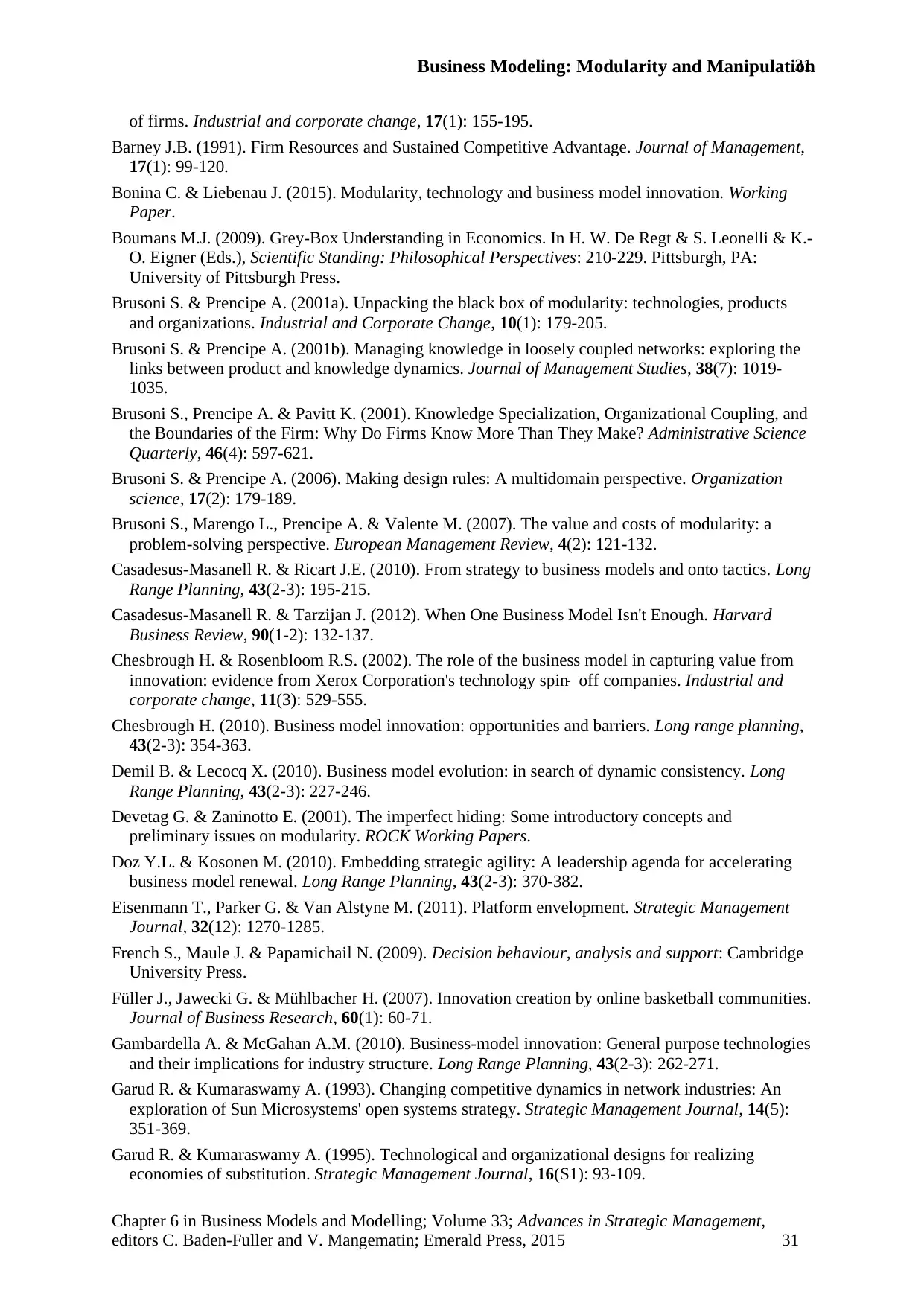
Business Modeling: Modularity and Manipulation
Chapter 6 in Business Models and Modelling; Volume 33; Advances in Strategic Management,
editors C. Baden-Fuller and V. Mangematin; Emerald Press, 2015 31
31
of firms. Industrial and corporate change, 17(1): 155-195.
Barney J.B. (1991). Firm Resources and Sustained Competitive Advantage. Journal of Management,
17(1): 99-120.
Bonina C. & Liebenau J. (2015). Modularity, technology and business model innovation. Working
Paper.
Boumans M.J. (2009). Grey-Box Understanding in Economics. In H. W. De Regt & S. Leonelli & K.-
O. Eigner (Eds.), Scientific Standing: Philosophical Perspectives: 210-229. Pittsburgh, PA:
University of Pittsburgh Press.
Brusoni S. & Prencipe A. (2001a). Unpacking the black box of modularity: technologies, products
and organizations. Industrial and Corporate Change, 10(1): 179-205.
Brusoni S. & Prencipe A. (2001b). Managing knowledge in loosely coupled networks: exploring the
links between product and knowledge dynamics. Journal of Management Studies, 38(7): 1019-
1035.
Brusoni S., Prencipe A. & Pavitt K. (2001). Knowledge Specialization, Organizational Coupling, and
the Boundaries of the Firm: Why Do Firms Know More Than They Make? Administrative Science
Quarterly, 46(4): 597-621.
Brusoni S. & Prencipe A. (2006). Making design rules: A multidomain perspective. Organization
science, 17(2): 179-189.
Brusoni S., Marengo L., Prencipe A. & Valente M. (2007). The value and costs of modularity: a
problem-solving perspective. European Management Review, 4(2): 121-132.
Casadesus-Masanell R. & Ricart J.E. (2010). From strategy to business models and onto tactics. Long
Range Planning, 43(2-3): 195-215.
Casadesus-Masanell R. & Tarzijan J. (2012). When One Business Model Isn't Enough. Harvard
Business Review, 90(1-2): 132-137.
Chesbrough H. & Rosenbloom R.S. (2002). The role of the business model in capturing value from
innovation: evidence from Xerox Corporation's technology spin‐ off companies. Industrial and
corporate change, 11(3): 529-555.
Chesbrough H. (2010). Business model innovation: opportunities and barriers. Long range planning,
43(2-3): 354-363.
Demil B. & Lecocq X. (2010). Business model evolution: in search of dynamic consistency. Long
Range Planning, 43(2-3): 227-246.
Devetag G. & Zaninotto E. (2001). The imperfect hiding: Some introductory concepts and
preliminary issues on modularity. ROCK Working Papers.
Doz Y.L. & Kosonen M. (2010). Embedding strategic agility: A leadership agenda for accelerating
business model renewal. Long Range Planning, 43(2-3): 370-382.
Eisenmann T., Parker G. & Van Alstyne M. (2011). Platform envelopment. Strategic Management
Journal, 32(12): 1270-1285.
French S., Maule J. & Papamichail N. (2009). Decision behaviour, analysis and support: Cambridge
University Press.
Füller J., Jawecki G. & Mühlbacher H. (2007). Innovation creation by online basketball communities.
Journal of Business Research, 60(1): 60-71.
Gambardella A. & McGahan A.M. (2010). Business-model innovation: General purpose technologies
and their implications for industry structure. Long Range Planning, 43(2-3): 262-271.
Garud R. & Kumaraswamy A. (1993). Changing competitive dynamics in network industries: An
exploration of Sun Microsystems' open systems strategy. Strategic Management Journal, 14(5):
351-369.
Garud R. & Kumaraswamy A. (1995). Technological and organizational designs for realizing
economies of substitution. Strategic Management Journal, 16(S1): 93-109.
Chapter 6 in Business Models and Modelling; Volume 33; Advances in Strategic Management,
editors C. Baden-Fuller and V. Mangematin; Emerald Press, 2015 31
31
of firms. Industrial and corporate change, 17(1): 155-195.
Barney J.B. (1991). Firm Resources and Sustained Competitive Advantage. Journal of Management,
17(1): 99-120.
Bonina C. & Liebenau J. (2015). Modularity, technology and business model innovation. Working
Paper.
Boumans M.J. (2009). Grey-Box Understanding in Economics. In H. W. De Regt & S. Leonelli & K.-
O. Eigner (Eds.), Scientific Standing: Philosophical Perspectives: 210-229. Pittsburgh, PA:
University of Pittsburgh Press.
Brusoni S. & Prencipe A. (2001a). Unpacking the black box of modularity: technologies, products
and organizations. Industrial and Corporate Change, 10(1): 179-205.
Brusoni S. & Prencipe A. (2001b). Managing knowledge in loosely coupled networks: exploring the
links between product and knowledge dynamics. Journal of Management Studies, 38(7): 1019-
1035.
Brusoni S., Prencipe A. & Pavitt K. (2001). Knowledge Specialization, Organizational Coupling, and
the Boundaries of the Firm: Why Do Firms Know More Than They Make? Administrative Science
Quarterly, 46(4): 597-621.
Brusoni S. & Prencipe A. (2006). Making design rules: A multidomain perspective. Organization
science, 17(2): 179-189.
Brusoni S., Marengo L., Prencipe A. & Valente M. (2007). The value and costs of modularity: a
problem-solving perspective. European Management Review, 4(2): 121-132.
Casadesus-Masanell R. & Ricart J.E. (2010). From strategy to business models and onto tactics. Long
Range Planning, 43(2-3): 195-215.
Casadesus-Masanell R. & Tarzijan J. (2012). When One Business Model Isn't Enough. Harvard
Business Review, 90(1-2): 132-137.
Chesbrough H. & Rosenbloom R.S. (2002). The role of the business model in capturing value from
innovation: evidence from Xerox Corporation's technology spin‐ off companies. Industrial and
corporate change, 11(3): 529-555.
Chesbrough H. (2010). Business model innovation: opportunities and barriers. Long range planning,
43(2-3): 354-363.
Demil B. & Lecocq X. (2010). Business model evolution: in search of dynamic consistency. Long
Range Planning, 43(2-3): 227-246.
Devetag G. & Zaninotto E. (2001). The imperfect hiding: Some introductory concepts and
preliminary issues on modularity. ROCK Working Papers.
Doz Y.L. & Kosonen M. (2010). Embedding strategic agility: A leadership agenda for accelerating
business model renewal. Long Range Planning, 43(2-3): 370-382.
Eisenmann T., Parker G. & Van Alstyne M. (2011). Platform envelopment. Strategic Management
Journal, 32(12): 1270-1285.
French S., Maule J. & Papamichail N. (2009). Decision behaviour, analysis and support: Cambridge
University Press.
Füller J., Jawecki G. & Mühlbacher H. (2007). Innovation creation by online basketball communities.
Journal of Business Research, 60(1): 60-71.
Gambardella A. & McGahan A.M. (2010). Business-model innovation: General purpose technologies
and their implications for industry structure. Long Range Planning, 43(2-3): 262-271.
Garud R. & Kumaraswamy A. (1993). Changing competitive dynamics in network industries: An
exploration of Sun Microsystems' open systems strategy. Strategic Management Journal, 14(5):
351-369.
Garud R. & Kumaraswamy A. (1995). Technological and organizational designs for realizing
economies of substitution. Strategic Management Journal, 16(S1): 93-109.

Business Modeling: Modularity and Manipulation
Chapter 6 in Business Models and Modelling; Volume 33; Advances in Strategic Management,
editors C. Baden-Fuller and V. Mangematin; Emerald Press, 2015 32
32
Garud R., Kumaraswamy A. & Langlois R. (2009). Managing in the modular age: architectures,
networks, and organizations: John Wiley & Sons.
Gavetti G., Levinthal D.A. & Rivkin J.W. (2005). Strategy making in novel and complex worlds: the
power of analogy. Strategic Management Journal, 26(8): 691-712.
Henderson R.M. & Clark K.B. (1990). Architectural Innovation: The Reconfiguration of Existing
Product Technologies and the Failure of Established Firms. Administrative Science Quarterly,
35(1): 9-30.
Hienerth C., Keinz P. & Lettl C. (2011). Exploring the nature and implementation process of user-
centric business models. Long Range Planning, 44(5): 344-374.
Kallinikos J. (2012). Form, function, and matter: Crossing the border of materiality. Materiality and
organizing: Social interaction in a technological world: 67-87.
Kodama F. (2004). Measuring emerging categories of innovation: Modularity and business model.
Technological Forecasting and Social Change, 71(6): 623-633.
Langlois R.N. & Robertson P.L. (1992). Networks and innovation in a modular system: Lessons from
the microcomputer and stereo component industries. Research Policy, 21(4): 297-313.
Leonard-Barton D. (1998). Wellsprings of knowledge: Building and sustaining the sources of
innovation: Harvard Business Press.
Markides C. & Charitou C.D. (2004). Competing with dual business models: A contingency
approach. The Academy of Management Executive, 18(3): 22-36.
Martins L.L., Rindova V.P. & Greenbaum B.E. (2015). Unlocking the Hidden Value of Concepts: A
Cognitive Approach to Business Model Innovation. Strategic Entrepreneurship Journal, 9(1): 99-
117.
Massa L. & Tucci C.L. (2013). Business model innovation. The Oxford Handbook of Innovation
Management: 420.
Morgan M.S. (1991). The stamping out of process analysis in econometrics: Brookfield.
Morgan M.S. (2012). The world in the model: how economists work and think: Cambridge University
Press.
Osterwalder A. & Pigneur Y. (2010). Business Model Generation: A Handbook For Visionaries,
Game Changers, And Challengers: John Wiley & Sons.
Parmatier G. (2015). Modularity in business model portfolios. Lessons from the digital industry.
Working Paper.
Parnas D.L. (1972). On the criteria to be used in decomposing systems into modules. Communications
of the ACM, 15(12): 1053-1058.
Rochet J.C. & Tirole J.( 2003). Platform competition in two-sided markets. Journal of the European
Economic Association, 1(4): 990-1029.
Rochet J.C. & Tirole J. (2006). Two-sided markets: a progress report. The RAND Journal of
Economics, 37(3): 645-667.
Schilling M.A. (2000). Toward a general modular systems theory and its application to interfirm
product modularity. Academy of Management Review, 25(2): 312-334.
Simon H.A. (1962). The Architecture of Complexity. Proceedings of the American Philosophical
Society, 106(6): 467-482.
Sosa M.E., Eppinger S.D. & Rowles C.M. (2004). The misalignment of product architecture and
organizational structure in complex product development. Management science, 50(12): 1674-
1689.
Sosa M.E., Eppinger S.D. & Rowles C.M. (2007). A network approach to define modularity of
components in complex products. Journal of mechanical design, 129(11): 1118-1129.
Stremersch S. & Tellis G.J. (2002). Strategic bundling of products and prices: A new synthesis for
marketing. Journal of Marketing, 66(1): 55-72.
Chapter 6 in Business Models and Modelling; Volume 33; Advances in Strategic Management,
editors C. Baden-Fuller and V. Mangematin; Emerald Press, 2015 32
32
Garud R., Kumaraswamy A. & Langlois R. (2009). Managing in the modular age: architectures,
networks, and organizations: John Wiley & Sons.
Gavetti G., Levinthal D.A. & Rivkin J.W. (2005). Strategy making in novel and complex worlds: the
power of analogy. Strategic Management Journal, 26(8): 691-712.
Henderson R.M. & Clark K.B. (1990). Architectural Innovation: The Reconfiguration of Existing
Product Technologies and the Failure of Established Firms. Administrative Science Quarterly,
35(1): 9-30.
Hienerth C., Keinz P. & Lettl C. (2011). Exploring the nature and implementation process of user-
centric business models. Long Range Planning, 44(5): 344-374.
Kallinikos J. (2012). Form, function, and matter: Crossing the border of materiality. Materiality and
organizing: Social interaction in a technological world: 67-87.
Kodama F. (2004). Measuring emerging categories of innovation: Modularity and business model.
Technological Forecasting and Social Change, 71(6): 623-633.
Langlois R.N. & Robertson P.L. (1992). Networks and innovation in a modular system: Lessons from
the microcomputer and stereo component industries. Research Policy, 21(4): 297-313.
Leonard-Barton D. (1998). Wellsprings of knowledge: Building and sustaining the sources of
innovation: Harvard Business Press.
Markides C. & Charitou C.D. (2004). Competing with dual business models: A contingency
approach. The Academy of Management Executive, 18(3): 22-36.
Martins L.L., Rindova V.P. & Greenbaum B.E. (2015). Unlocking the Hidden Value of Concepts: A
Cognitive Approach to Business Model Innovation. Strategic Entrepreneurship Journal, 9(1): 99-
117.
Massa L. & Tucci C.L. (2013). Business model innovation. The Oxford Handbook of Innovation
Management: 420.
Morgan M.S. (1991). The stamping out of process analysis in econometrics: Brookfield.
Morgan M.S. (2012). The world in the model: how economists work and think: Cambridge University
Press.
Osterwalder A. & Pigneur Y. (2010). Business Model Generation: A Handbook For Visionaries,
Game Changers, And Challengers: John Wiley & Sons.
Parmatier G. (2015). Modularity in business model portfolios. Lessons from the digital industry.
Working Paper.
Parnas D.L. (1972). On the criteria to be used in decomposing systems into modules. Communications
of the ACM, 15(12): 1053-1058.
Rochet J.C. & Tirole J.( 2003). Platform competition in two-sided markets. Journal of the European
Economic Association, 1(4): 990-1029.
Rochet J.C. & Tirole J. (2006). Two-sided markets: a progress report. The RAND Journal of
Economics, 37(3): 645-667.
Schilling M.A. (2000). Toward a general modular systems theory and its application to interfirm
product modularity. Academy of Management Review, 25(2): 312-334.
Simon H.A. (1962). The Architecture of Complexity. Proceedings of the American Philosophical
Society, 106(6): 467-482.
Sosa M.E., Eppinger S.D. & Rowles C.M. (2004). The misalignment of product architecture and
organizational structure in complex product development. Management science, 50(12): 1674-
1689.
Sosa M.E., Eppinger S.D. & Rowles C.M. (2007). A network approach to define modularity of
components in complex products. Journal of mechanical design, 129(11): 1118-1129.
Stremersch S. & Tellis G.J. (2002). Strategic bundling of products and prices: A new synthesis for
marketing. Journal of Marketing, 66(1): 55-72.
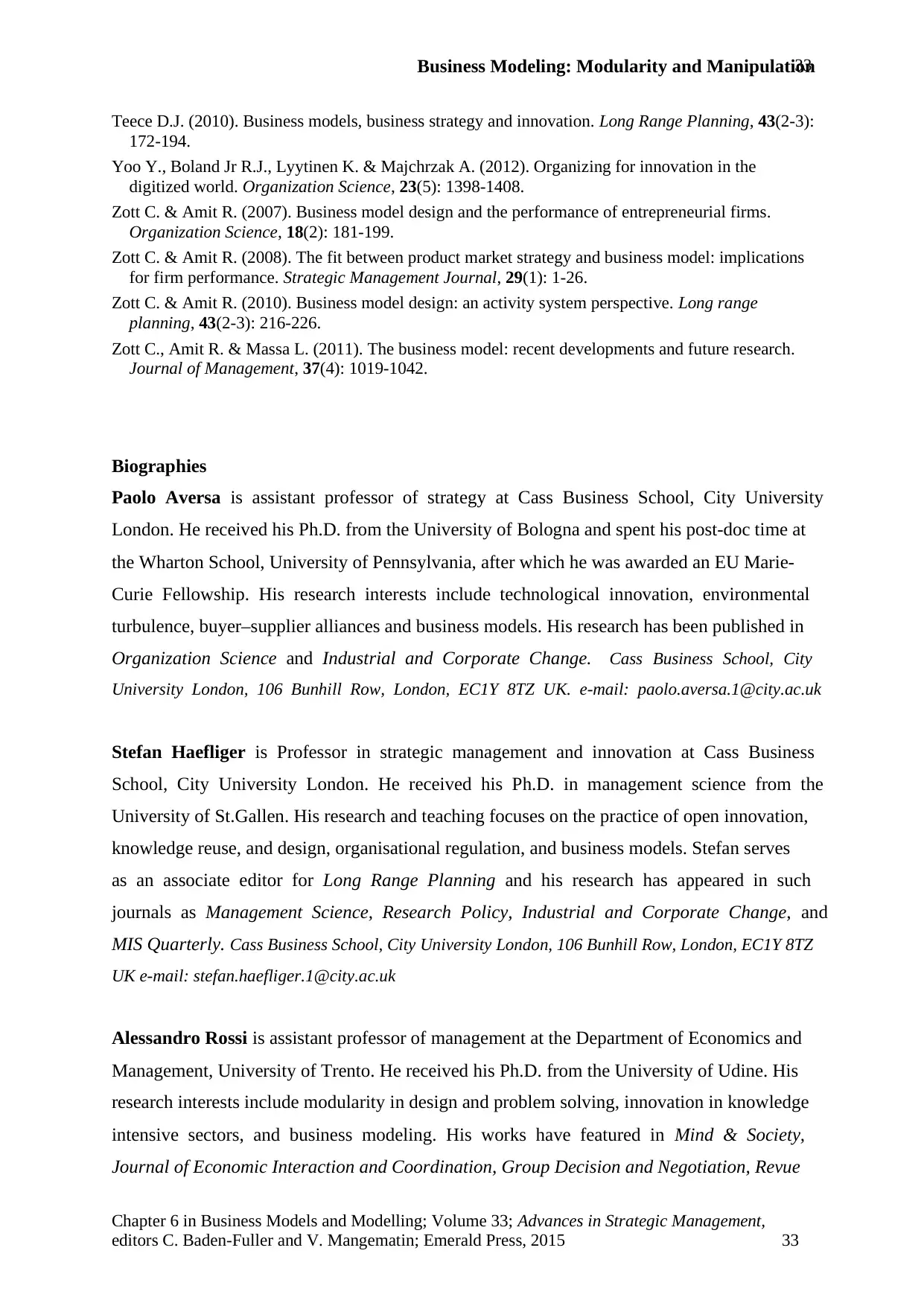
Business Modeling: Modularity and Manipulation
Chapter 6 in Business Models and Modelling; Volume 33; Advances in Strategic Management,
editors C. Baden-Fuller and V. Mangematin; Emerald Press, 2015 33
33
Teece D.J. (2010). Business models, business strategy and innovation. Long Range Planning, 43(2-3):
172-194.
Yoo Y., Boland Jr R.J., Lyytinen K. & Majchrzak A. (2012). Organizing for innovation in the
digitized world. Organization Science, 23(5): 1398-1408.
Zott C. & Amit R. (2007). Business model design and the performance of entrepreneurial firms.
Organization Science, 18(2): 181-199.
Zott C. & Amit R. (2008). The fit between product market strategy and business model: implications
for firm performance. Strategic Management Journal, 29(1): 1-26.
Zott C. & Amit R. (2010). Business model design: an activity system perspective. Long range
planning, 43(2-3): 216-226.
Zott C., Amit R. & Massa L. (2011). The business model: recent developments and future research.
Journal of Management, 37(4): 1019-1042.
Biographies
Paolo Aversa is assistant professor of strategy at Cass Business School, City University
London. He received his Ph.D. from the University of Bologna and spent his post-doc time at
the Wharton School, University of Pennsylvania, after which he was awarded an EU Marie-
Curie Fellowship. His research interests include technological innovation, environmental
turbulence, buyer–supplier alliances and business models. His research has been published in
Organization Science and Industrial and Corporate Change. Cass Business School, City
University London, 106 Bunhill Row, London, EC1Y 8TZ UK. e-mail: paolo.aversa.1@city.ac.uk
Stefan Haefliger is Professor in strategic management and innovation at Cass Business
School, City University London. He received his Ph.D. in management science from the
University of St.Gallen. His research and teaching focuses on the practice of open innovation,
knowledge reuse, and design, organisational regulation, and business models. Stefan serves
as an associate editor for Long Range Planning and his research has appeared in such
journals as Management Science, Research Policy, Industrial and Corporate Change, and
MIS Quarterly. Cass Business School, City University London, 106 Bunhill Row, London, EC1Y 8TZ
UK e-mail: stefan.haefliger.1@city.ac.uk
Alessandro Rossi is assistant professor of management at the Department of Economics and
Management, University of Trento. He received his Ph.D. from the University of Udine. His
research interests include modularity in design and problem solving, innovation in knowledge
intensive sectors, and business modeling. His works have featured in Mind & Society,
Journal of Economic Interaction and Coordination, Group Decision and Negotiation, Revue
Chapter 6 in Business Models and Modelling; Volume 33; Advances in Strategic Management,
editors C. Baden-Fuller and V. Mangematin; Emerald Press, 2015 33
33
Teece D.J. (2010). Business models, business strategy and innovation. Long Range Planning, 43(2-3):
172-194.
Yoo Y., Boland Jr R.J., Lyytinen K. & Majchrzak A. (2012). Organizing for innovation in the
digitized world. Organization Science, 23(5): 1398-1408.
Zott C. & Amit R. (2007). Business model design and the performance of entrepreneurial firms.
Organization Science, 18(2): 181-199.
Zott C. & Amit R. (2008). The fit between product market strategy and business model: implications
for firm performance. Strategic Management Journal, 29(1): 1-26.
Zott C. & Amit R. (2010). Business model design: an activity system perspective. Long range
planning, 43(2-3): 216-226.
Zott C., Amit R. & Massa L. (2011). The business model: recent developments and future research.
Journal of Management, 37(4): 1019-1042.
Biographies
Paolo Aversa is assistant professor of strategy at Cass Business School, City University
London. He received his Ph.D. from the University of Bologna and spent his post-doc time at
the Wharton School, University of Pennsylvania, after which he was awarded an EU Marie-
Curie Fellowship. His research interests include technological innovation, environmental
turbulence, buyer–supplier alliances and business models. His research has been published in
Organization Science and Industrial and Corporate Change. Cass Business School, City
University London, 106 Bunhill Row, London, EC1Y 8TZ UK. e-mail: paolo.aversa.1@city.ac.uk
Stefan Haefliger is Professor in strategic management and innovation at Cass Business
School, City University London. He received his Ph.D. in management science from the
University of St.Gallen. His research and teaching focuses on the practice of open innovation,
knowledge reuse, and design, organisational regulation, and business models. Stefan serves
as an associate editor for Long Range Planning and his research has appeared in such
journals as Management Science, Research Policy, Industrial and Corporate Change, and
MIS Quarterly. Cass Business School, City University London, 106 Bunhill Row, London, EC1Y 8TZ
UK e-mail: stefan.haefliger.1@city.ac.uk
Alessandro Rossi is assistant professor of management at the Department of Economics and
Management, University of Trento. He received his Ph.D. from the University of Udine. His
research interests include modularity in design and problem solving, innovation in knowledge
intensive sectors, and business modeling. His works have featured in Mind & Society,
Journal of Economic Interaction and Coordination, Group Decision and Negotiation, Revue
Secure Best Marks with AI Grader
Need help grading? Try our AI Grader for instant feedback on your assignments.
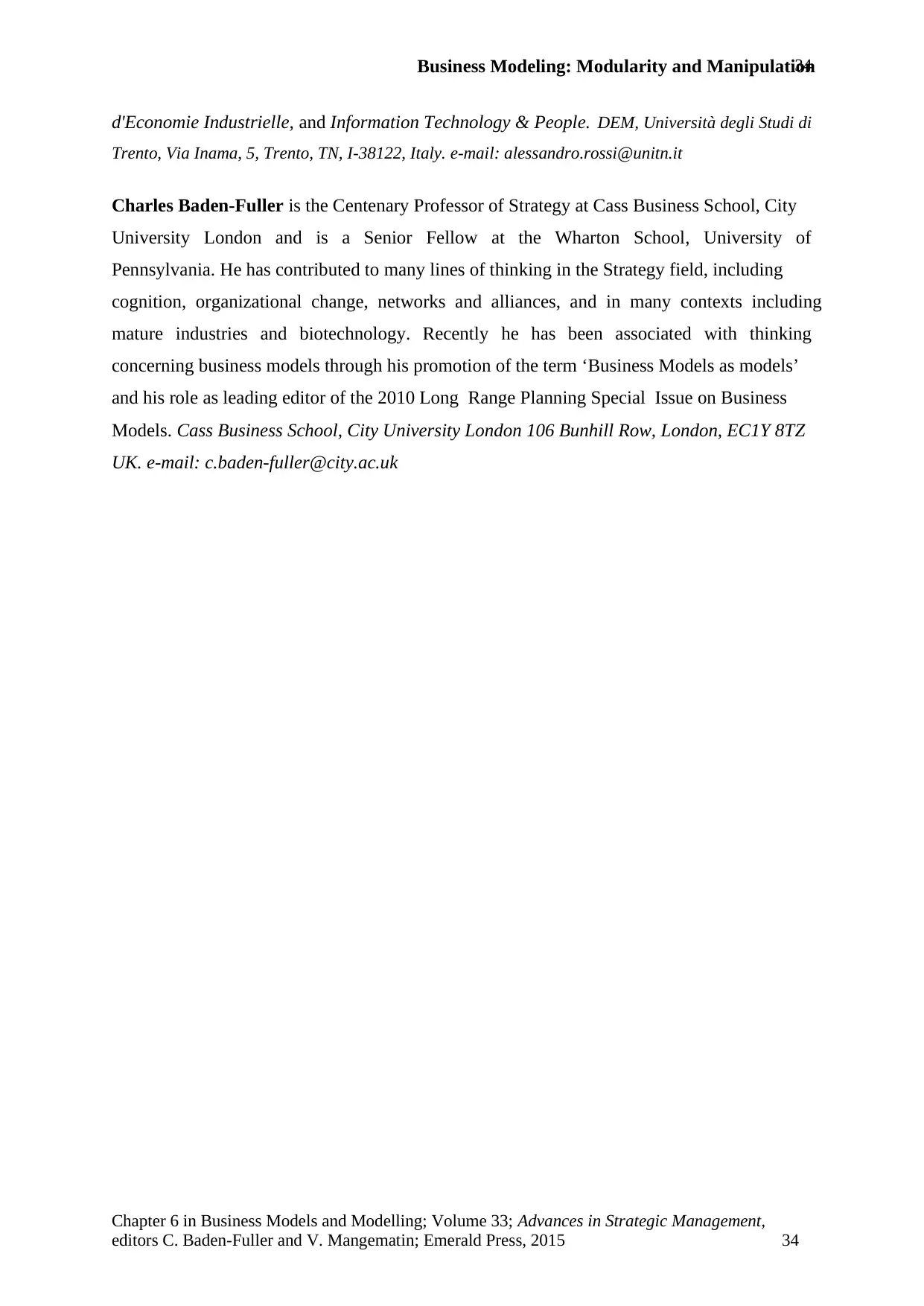
Business Modeling: Modularity and Manipulation
Chapter 6 in Business Models and Modelling; Volume 33; Advances in Strategic Management,
editors C. Baden-Fuller and V. Mangematin; Emerald Press, 2015 34
34
d'Economie Industrielle, and Information Technology & People. DEM, Università degli Studi di
Trento, Via Inama, 5, Trento, TN, I-38122, Italy. e-mail: alessandro.rossi@unitn.it
Charles Baden-Fuller is the Centenary Professor of Strategy at Cass Business School, City
University London and is a Senior Fellow at the Wharton School, University of
Pennsylvania. He has contributed to many lines of thinking in the Strategy field, including
cognition, organizational change, networks and alliances, and in many contexts including
mature industries and biotechnology. Recently he has been associated with thinking
concerning business models through his promotion of the term ‘Business Models as models’
and his role as leading editor of the 2010 Long Range Planning Special Issue on Business
Models. Cass Business School, City University London 106 Bunhill Row, London, EC1Y 8TZ
UK. e-mail: c.baden-fuller@city.ac.uk
Chapter 6 in Business Models and Modelling; Volume 33; Advances in Strategic Management,
editors C. Baden-Fuller and V. Mangematin; Emerald Press, 2015 34
34
d'Economie Industrielle, and Information Technology & People. DEM, Università degli Studi di
Trento, Via Inama, 5, Trento, TN, I-38122, Italy. e-mail: alessandro.rossi@unitn.it
Charles Baden-Fuller is the Centenary Professor of Strategy at Cass Business School, City
University London and is a Senior Fellow at the Wharton School, University of
Pennsylvania. He has contributed to many lines of thinking in the Strategy field, including
cognition, organizational change, networks and alliances, and in many contexts including
mature industries and biotechnology. Recently he has been associated with thinking
concerning business models through his promotion of the term ‘Business Models as models’
and his role as leading editor of the 2010 Long Range Planning Special Issue on Business
Models. Cass Business School, City University London 106 Bunhill Row, London, EC1Y 8TZ
UK. e-mail: c.baden-fuller@city.ac.uk
1 out of 35
Your All-in-One AI-Powered Toolkit for Academic Success.
+13062052269
info@desklib.com
Available 24*7 on WhatsApp / Email
![[object Object]](/_next/static/media/star-bottom.7253800d.svg)
Unlock your academic potential
© 2024 | Zucol Services PVT LTD | All rights reserved.